Iguazu Falls Travel Guide For Argentina & Brazil (+Map)
Iguazu Falls is one of the world’s most spectacular and impressive waterfalls, straddling the border between Argentina and Brazil in South America.
With more than 275 individual cascades, Iguazu is actually the biggest waterfall system in the world! The closest comparison is probably Niagara Falls in Canada and the United States, although Iguazu Falls is bigger than Niagara by most measurements.
This spectacular waterfall has been made into a national park in Argentina and Brazil, and both sides of the falls are well worth a visit since they offer different views! You can see the best highlights of Iguazu in a couple of days, although you could easily spend longer.
This travel guide will explain how to get to Iguazu Falls on the Argentina or Brazil side (with or without a tour), plus a map of the falls and more info. Lastly, I’ll share some interesting facts about the waterfall itself!

Where Is Iguazu Falls?
Iguazu Falls is located on the border of Argentina and Brazil, in the continent of South America.
There are towns and airports on both sides of the border, with plenty of tourist friendly hotels and restaurants, and you can easily go back and forth between the two countries to see both sides of the waterfall.
The town on the Argentine side of the falls is called Puerto Iguazu , while the Brazil side is called Foz do Iguacu .

Iguazu Falls is in Argentina and Brazil
How To Get To Iguazu Falls Argentina & Brazil
The main way to get to Iguazu Falls is by flying there from one of the big cities in Argentina or Brazil.
For the Argentina side, you can fly from Buenos Aires to Puerto Iguazu airport (IGR), which takes less than 2 hours and is offered by multiple airlines, with pretty reasonable prices. There are two airports in Buenos Aires (AEP or EZE) and you can use either of them to fly here.
If you’re in Brazil, you can fly from Sao Paulo or Rio De Janeiro to Foz do Iguacu airport (IGU), which takes about 2 hours, more or less. These routes are also offered by multiple airlines with daily departures.
Shop Now: Argentina & Brazil flights at Skyscanner

A busy day at Iguazu Falls
Once you arrive in the town of Puerto Iguazu, you can get to the Argentina waterfall by bus, taxi, or tour . The bus is cheap, safe, and easy to use, with regular departures from the bus terminal in town to the waterfall, and back.
However, if you want something more personalized and convenient, then a taxi or private tour can be a good option. You can ask the driver to wait for you while you explore the waterfall, and then take you back to town afterwards.
The Brazil side of Iguazu Falls works much the same way. You can get to the Brazil waterfall by bus, taxi, or tour , and all of these options work well depending on your needs and how much time you have in your itinerary.

Iguazu Falls Brazil side
It’s also easy to cross the international border between Argentina and Brazil, and go back and forth by bus, taxi, or tour , seeing both sides of the Iguazu waterfall.
For example, I based myself on the Argentina side of Iguazu Falls, but I did a day trip to the Brazil side using the bus, and I also did a separate day trip to the Paraguay side with a taxi.
As a US citizen, I didn’t need any visa for Argentina, Brazil, or Paraguay, so it was very easy to do day trips between them, but remember to check the current visa requirements for your nationality in these countries to avoid any border hassles, and don’t forget to bring your passport!

Views above the Iguazu waterfall
Best Iguazu Falls Tours
One of the easiest ways to visit Iguazu Falls is with a day tour from Puerto Iguazu or Foz do Iguacu.
GetYourGuide has high-rated day tours to see Iguazu Falls on the Argentina side , with optional boat tours where you can see the waterfalls up close and get soaked. This can be a fun way to see the beauty of Iguazu Falls from a different angle.
On the Brazil side, they have day tours to Iguazu Falls from Foz do Iguacu , with similar boat tours and an optional visit to the bird park. Just like on the Argentina side, these tours include a trilingual tour guide and hotel pickup and drop-off.
We’ve used GetYourGuide for lots of tours and activities around the world, and they’re great. Highly recommended!
Book Now: Iguazu Falls Argentina / Brazil Tour
Other Iguazu Falls Tours
GetYourGuide also has some convenient day tours that cross the border to see Argentina or Brazil from the other side. This can be a handy solution if you’re planning to see both sides of Iguazu Falls.
In other words, they have a tour that goes to the Argentina side of the falls starting from Brazil, or a tour to the Brazilian side starting from Argentina. Both of these are great.
If you’re short on time, they even have package tours from Buenos Aires or Rio De Janeiro that include flights, a private driver and tour guide, and your national park entrance tickets.
Iguazu Falls Argentina Side: What To Expect
Visiting Iguazu Falls is an amazing experience! The pictures don’t really do it justice at all.
The Argentina side of Iguazu Falls is bigger and more spread out than the Brazil side, so it’s divided into circuits that go to different parts of the waterfall. The very best things to see are the upper circuit, lower circuit, and Devil’s Throat viewpoint.
The park is well connected by walking trails and a free mini train system, so it’s pretty easy to get around. You can choose to walk the entire park, explore it by train, or use a combination of the two transport methods. There are also benches and cafes where you can stop and rest along the way.
If you’re in decent shape, I would recommend walking the upper and lower circuits in the morning without the train, and then using the train to go to the Devil’s Throat viewpoint in the afternoon. This will give you a good workout, but it’s not too much for a day.

Twin waterfalls on the Argentina side
As you explore the national park, you can see all kinds of wildlife like monkeys, coatis, crocodiles, turtles, and lizards, plus various kinds of birds, spiders, and butterflies. If you’re lucky you might even see a tapir.
The upper and lower circuits at Iguazu both have some amazing panoramic views of the waterfall to enjoy, but in my opinion the very best thing to see in Argentina is the Devil’s Throat viewpoint (in Spanish: ‘Garganta Del Diablo’).
At the appropriately named Devil’s Throat, you can stand and gaze directly into the center of Iguazu Falls, which has a massive U-shaped curtain of water with a tremendous roaring sound and a cloud of mist.
I’d say this viewpoint is the single most impressive feature on either side of Iguazu Falls!

Devil’s Throat viewpoint (‘Garganta Del Diablo’)

Massive wall of water
• Entrance Fee (Argentina)
Iguazu Falls is a national park in Argentina, so there’s a fee you have to pay to enter the park. This applies whether you’re visiting the walkways or doing other activities like a boat cruise, although some day tours may include the park fee in their price.
You can find the current entrance fee on the Argentina national parks website . However, if you visit two days in a row then the second day price is marked down by 50 percent, so just remember to keep your ticket so you can show them and get a discount.
You can pay for your park tickets with a credit or debit card, or with the local currency (Argentine Pesos). They also accept Brazilian Reals, US Dollars, or Paraguayan Guarani. I paid with a foreign credit card and that was fine.
You can book your park tickets in advance, but there’s really no need, because they’re unlimited and never sell out. Lines are always quick at the ticket counter, and I got my tickets in less than a minute. The only thing you might want to book in advance is the boat cruise.

Iguazu Falls Argentina side
• Opening Hours (Argentina)
The opening hours for the Argentina side are 8 AM to 6 PM, but the last entry is at 4:30 PM.
This is the same every day of the year, including holidays like Christmas Day, New Year’s Day, and Easter Sunday.
• Map (Argentina)
Here’s a handy map of the Iguazu Falls Argentina side you can use to plan your trip. You can click the map to view it in full size.
There are also maps signposted throughout the national park to help you find your way to all of the trails and waterfalls.

Map of Iguazu Falls Argentina side (© Parque Nacional Iguazu )
Iguazu Falls Brazil Side: What To Expect
The Brazil side of Iguazu Falls is a bit smaller and more simple than the Argentina side, but there’s still plenty of great things to see and do.
The park has one main pathway that follows the side of the river, ending with a thrilling balcony near the edge of the falls, and then several platforms that let you see the waterfall from above, either by going up stairs or taking an elevator.
The Brazil park is set up in a loop arrangement with a free bus service that takes you from the entrance gate to either end of the park, and back. Overall, it’s shorter and easier to visit than the Argentina side.

Getting up close with the waterfall

One of my favorite views on the Brazilian side of Iguazu Falls
I loved the Brazil side of Iguazu Falls, and even though it’s not quite as impressive as the ‘Devil’s Throat’ viewpoint in Argentina, I still think it’s more photogenic than the Argentina side in many ways. It would be a big mistake to skip this side of Iguazu just because it’s smaller!
When you get done exploring the Brazil side of Iguazu Falls, there’s also a nice bird park you can visit near the entrance to the national park. It has lots of great South American birds, including some colorful macaws and toucans!
The bird park is called ‘ Parque Das Aves ‘ and it’s just a short walk from the waterfall entrance. Don’t miss it! The ticket is separate from Iguazu, and it’s a little pricey, but it’s worth it.

An amazing toucan at the Brazil bird park
• Entrance Fee (Brazil)
You can check the current Brazil park fee on the official website here , and they also let you buy tickets in advance.
Just like on the Argentina side, there’s no need to book the park tickets in advance, because they’re unlimited and never sell out.
At the park entrance, you can pay for your tickets with a credit or debit card, or with the local currency (Brazilian Reals). They also accept Argentine Pesos, US Dollars, or Paraguayan Guarani.

• Opening Hours (Brazil)
The opening hours for the Brazil side are 9 AM to 6 PM every day of the year, but the last entry is at 4:30 PM.
• Map (Brazil)
Here’s a map of the Iguazu Falls Brazil side to help you navigate the waterfall area. You can click the map to view it in full size.

Map of Iguazu Falls Brazil side (© Parque Nacional Do Iguacu )
How Much Time To Spend At Iguazu Falls
You need two full days to really see and explore both sides of Iguazu Falls: one day for Argentina, and one day for Brazil. The Brazil side can be done in a half day if you skip the bird park.
A third day at Iguazu will give you more flexibility with weather, and it’ll allow you to re-visit one of the national parks or else do a day trip to Paraguay to see Monday Falls (the Saltos Del Monday waterfall).
If you’re really pressed for time, it’s possible to see both sides of Iguazu Falls in a single day (Argentina and Brazil), although you’ll have to use a tour in order to speed up the border crossings and other logistics.

Boat cruise in a rainbow
What To Bring To Iguazu Falls
- Clothing: The climate at Iguazu is tropical, so it’s hot and humid year round. You’ll want to dress for summer. Shorts and sandals are a good idea.
- Sunscreen: It can be very hot and sunny here, so you’ll want a hat and sunscreen. This is the only place I got any burn in Argentina.
- Rain Coat: There can be extreme mist and spray at some areas of the waterfall, such as the Devil’s Throat, so a poncho is helpful to keep you dry.
- Bug Spray: In general there aren’t many mosquitoes at Iguazu, and I think they’re mostly scared away by the noise and spray of the waterfalls. However, some areas of the park are more calm and you’re likely to run into mosquitoes and other bugs there, so bring bug spray just in case.
- Vaccines: I got the Yellow Fever vaccine before traveling here, and I think it’s a good idea, especially if you plan to travel to Yellow Fever areas in the future. The vaccine is good for life. According to the US CDC , there is some presence of Yellow Fever in the mosquitoes around Iguazu. The vaccine is recommended, but not required by Argentina or Brazil, so that’s your decision to make. Most people don’t bother with the vaccine, and have a great trip anyways.
- Camera: Both sides of the waterfall are very photogenic. A lens with a little bit of zoom is best, although for the Devil’s Throat you’ll want a wide angle lens.
- Passport: If you’re crossing a border, remember to bring your passport. You’ll need it, and it’s easy to forget. Aside from border crossings, however, you won’t need to carry your passport everywhere. For example, if you’re staying in Argentina you won’t need to bring your passport to visit the Argentine side of the falls. It’s not required for entering either of the national parks (just crossing the border), and it would be bad to get your passport wet!

Best Time To Visit Iguazu Falls
There’s really no best time to visit Iguazu Falls. It has a good flow all year long, and it’s always photogenic!
If you want cooler weather, the humidity and temperatures are best from May to August. These are also some of the least rainy months of the year, and the bright sunny days are great for seeing rainbows at the falls.
With that said, I’ve visited Iguazu in the wet season and there really wasn’t too much rain at all. It was mostly sunny every day, with one shower in the evening, and the rain didn’t affect any of my plans.
Naturally, the waterfalls have the strongest and most impressive flow during the rainy season, although sometimes the water can look a bit brown and muddy, which may not be ideal for photos (I’m nitpicking there).
The best time of day to visit Iguazu Falls is in the morning so you can avoid some of the heat and crowds. This is a very popular tourist destination, so it gets pretty crowded by noon. Photography is good at any time of day, though.

You can see macaws and toucans at the Brazil bird park near Iguazu

The walkways in Argentina give you some great views
Iguazu Falls Argentina vs Brazil: Which Side Is Better?
So which side of Iguazu Falls is better? The Argentina side, or the Brazil side? That’s a tough question, because both sides are amazing.
The main advantage of the Argentina side is that it’s bigger and has more trails and walkways to explore. The Devil’s Throat viewpoint is also arguably the most spectacular thing you can see at Iguazu.
The Brazil side, on the other hand, is more compact but it still has some unique scenery and walkways. I would even argue it’s more photogenic than the Argentina side. Plus there’s a nice bird park near the entrance!
In conclusion, I thought the Argentina side was a bit more impressive to see with my own eyes, but the Brazil side may be better for taking photos. Both sides are very worthwhile, and I would recommend seeing both if you’re able.

Iguazu Falls Paraguay Side: Saltos Del Monday
If you want to see another big and beautiful waterfall near Iguazu Falls, there’s a nice one in neighboring Paraguay called Monday Falls (‘Saltos Del Monday’).
Technically this waterfall is not part of the same river system as Iguazu Falls, and it can’t compare in size or greatness, but it’s located nearby and the cascade is a pretty impressive one in its own right, with a height of more than 45 meters (150 feet).
It’s easy to visit Paraguay and the Monday Falls on a day trip from either the Argentina or Brazil side of Iguazu Falls, and as a bonus, you also get to check off another country (Paraguay) from your bucket list!
Read More: Saltos Del Monday Paraguay

Saltos Del Monday is a nice waterfall in Paraguay that you can visit on a day trip.
Fun Facts About Iguazu Falls
- How big is it? Iguazu Falls is huge. It’s actually the largest broken waterfall system in the world, with 275 individual cascades. Iguazu has a height of 64 to 82 meters (210 to 269 feet), a width of 2,700 meters (8,858 feet), and a mean annual flow rate of 1,746 cubic meters per second (61,600 cubic feet per second).
- How does it compare to Niagara Falls in Canada and USA? Iguazu Falls is frequently compared to Niagara Falls in North America, which sits on the border between Canada and the United States. Iguazu is bigger than Niagara in most ways. It’s higher and much wider, although Niagara has a stronger flow rate.
- How does it compare to Victoria Falls in Zambia and Zimbabwe? Iguazu Falls is also often compared to Victoria Falls, which is a waterfall in Africa on the border between Zambia and Zimbabwe. Victoria Falls is the biggest curtain of water in the world, and it’s also taller than Iguazu. Collectively, Iguazu is wider than Victoria, but it’s split into roughly 275 distinct waterfalls.
- What is the source? The Iguazu River is the source of the waterfall, and it originates in the Serra do Mar mountains of Brazil. This river is about 1,320 kilometers (820 miles) long.
- How did it get its name? The name Iguazu comes from indigenous Guarani words meaning ‘great water.’ It’s pronounced ‘ee-wasu’ or ‘ee-wazu’ although many people also pronounce it ‘eeg-wazu’ or ‘ig-wazu.’
- Is it a national park? Yes, Iguazu is a national park in both Argentina and Brazil. Each side is considered a separate national park. The Argentina side is officially called Parque Nacional Iguazú in Spanish, while the Brazilian side is called Parque Nacional Do Iguaçu in Portuguese.
- What is the UNESCO status? The Iguazu National Park in Argentina has been recognized as a UNESCO World Heritage Site since 1984, and the Brazil side has also been separately recognized by UNESCO since 1986. This is because of the area’s outstanding natural significance and beauty, as well as the biological diversity.
- Can you stay inside the national park? Yes, the Argentina national park has the Gran Melia Iguazu , while the Brazil side has the Belmond Hotel Das Cataratas . These hotels are expensive but high rated, and they’re the only options if you want to stay directly inside the national park and be right at the falls.
- What other facilities are there? Both national parks have lockers for storing luggage, and they also have plenty of bathrooms, cafes, maps, and souvenir shops. The parks have ATMs, but they’re not reliable for drawing cash. Thankfully you can pay for everything in the park with a credit card, and it’s possible to get cash from the banks in town.
- How hard is it to get to Iguazu Falls? It’s easy to get to either side of Iguazu Falls. You can fly into the town on either side of the river and use it as a base to see both Argentina and Brazil using a bus, taxi, or tour.

The roaring Devil’s Throat
Other Tips For Puerto Iguazu / Foz do Iguacu Town
- Hotels: There are a bunch of comfortable hotels and hostels in Puerto Iguazu town (Argentina), and also in Foz do Iguacu town on the Brazilian side.
- Restaurants: You can find lots of nice cafes and restaurants on both sides of Iguazu, so you’ll never have a hard time finding somewhere to eat breakfast, lunch, or dinner.
- Cash: You can withdraw cash at one of the bank ATMs in town. Sending money to yourself via Western Union is another option.
- Credit Cards: Most places in town accept credit cards, but some smaller places may be cash only. Keep some cash just in case.
- WiFi: The hotels and restaurants in town usually have fast, reliable WiFi. I was able to find great WiFi everywhere I went.
- Cell Service: There is good cell service/phone reception in town on both sides of the falls, although you may lose signal at times when touring the Iguazu waterfall because it’s pretty spread out.
- Safety: The Iguazu area is safe for tourists, and generally you don’t have to worry about crime in town. Just practice normal precautions. Don’t leave cash in your room, or valuables in your car.

Is Iguazu Falls Worth It?
Yes, Iguazu Falls is absolutely worth it!
Even though it’s not the easiest place to visit in Argentina or Brazil, this waterfall really deserves the detour. It’s one of the biggest and most impressive falls in the world.
If you’re planning to travel through South America, definitely add this place to your bucket list!
Is Iguazu Falls Open / Closed Right Now?
Yes, Iguazu Falls is currently open to tourists in both Argentina and Brazil! Both parks are wide open to international tourists. I’ll update this travel guide if anything changes.
Some areas of the park may be closed from time to time for maintenance, but this is temporary and they usually reopen quickly. You can also check current updates on the official websites for Iguazu Argentina and Iguazu Brazil .
Happy travels!
More South America Travel Tips
Thanks for looking! I hope you enjoyed this map and travel guide for Iguazu Falls Argentina and Brazil.
I have a bunch of other travel blog posts for Argentina and South America , so don’t forget to check them before you go.
You may also like
How to visit khao sok national park in thailand, how to spend 1 day in yosemite national park (itinerary), how to visit ciletuh geopark: waterfall valley in west java, how to visit tanjung puting national park in indonesia, coron vs el nido: which is better all differences explained, banggai islands travel guide & itinerary for sulawesi, leave a comment cancel reply.
Save my name, email, and website in this browser for the next time I comment.
- Skip to primary navigation
- Skip to main content
- Skip to primary sidebar
- Skip to footer

The Opinionated Travelogue of a Photo Maniac
- Middle East
- North America
- South America
- Pacific Islands
- FOOD & WINE
- TRAVEL GUIDES
- TRAVEL RESOURCES
- Rants & Raves
- Travel Blogger Interviews
- Contact Form
- Privacy Policy
- Featured Elsewhere
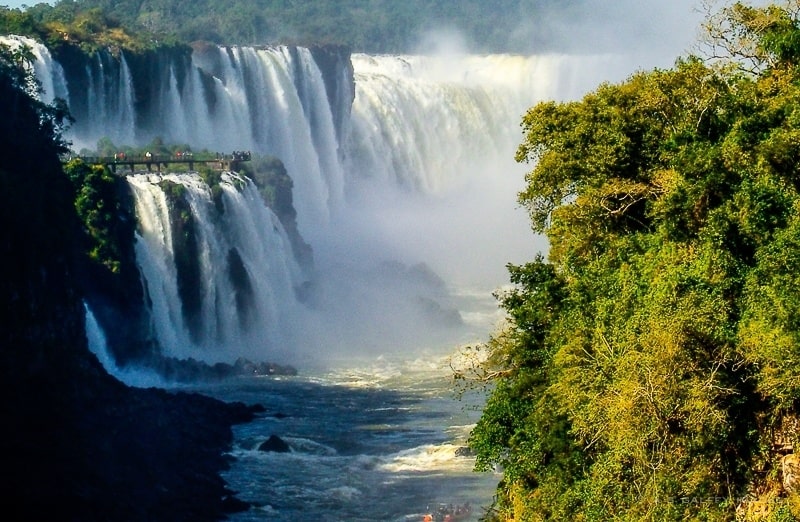
The Ultimate Guide to Visiting the Iguazu Falls – a 2 Day Itinerary
Last Modified: August 17, 2023 // by Anda // 47 Comments
Visiting the Iguazú Falls is one of the most powerful encounters with nature that you will ever have. You may have seen photos of this waterfall before, but coming face to face with it is like facing a dragon! It’s an experience you’ll never forget.
“ My poor Niagara! “were Eleanor Roosevelt’s words when she first saw the waterfall. And that was exactly my thought when I first saw the Iguazu Falls.
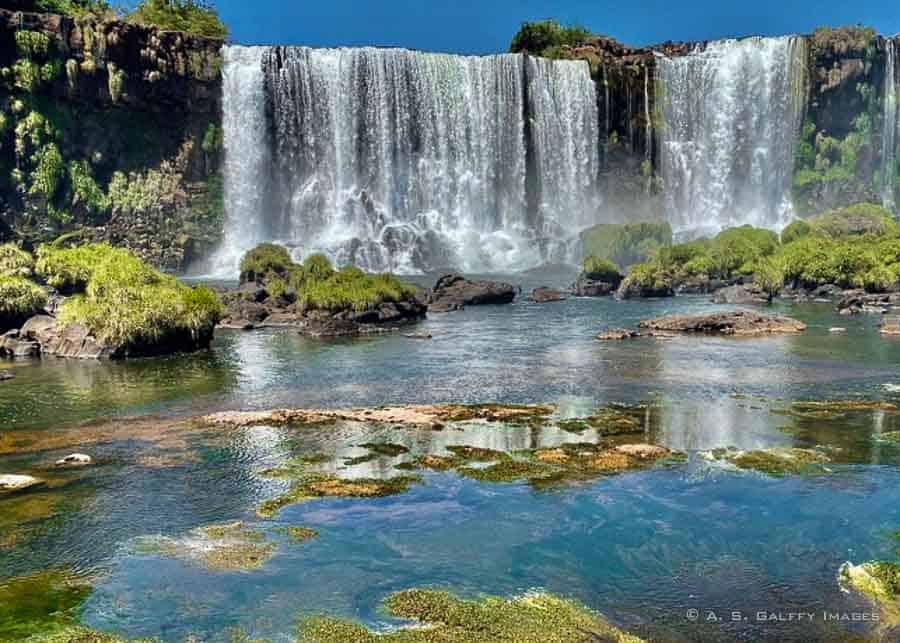
Located on the border of the Argentina and Brazil, Iguazú Falls stretch over 2.7 kilometers (1.7 miles) along the length of the Iguazu River. About 80% of the falls are on the Argentinean side, and only 20% on the Brazilian side.
Table of Contents
The Legend of the Falls
What’s the best way to visit the falls, the flora and fauna at iguazú, argentina vs. brazil: which side of the falls is better, visiting the argentinian side of iguazú falls, visiting the brazilian side of iguazú falls, best time to visit the falls, how to get to iguazú falls, where to stay when visiting iguazú falls, things to do on the brazilian side of iguazu falls.
Like many other beautiful places on Earth, Iguazu Falls has its own legend. The story says that a monstrous serpent named Boi used to live in the waters of Iguazu River. In order to tame the serpent, a beautiful woman had to be sacrificed every year by throwing her into the river.
One year, a young girl named Naipí was chosen for the sacrifice. Her lover,Tarobá, found out and kidnapped her in a canoe the night before the ceremony. In rage, the serpent split the river, creating the waterfalls and condemning the lovers to an eternal fall.
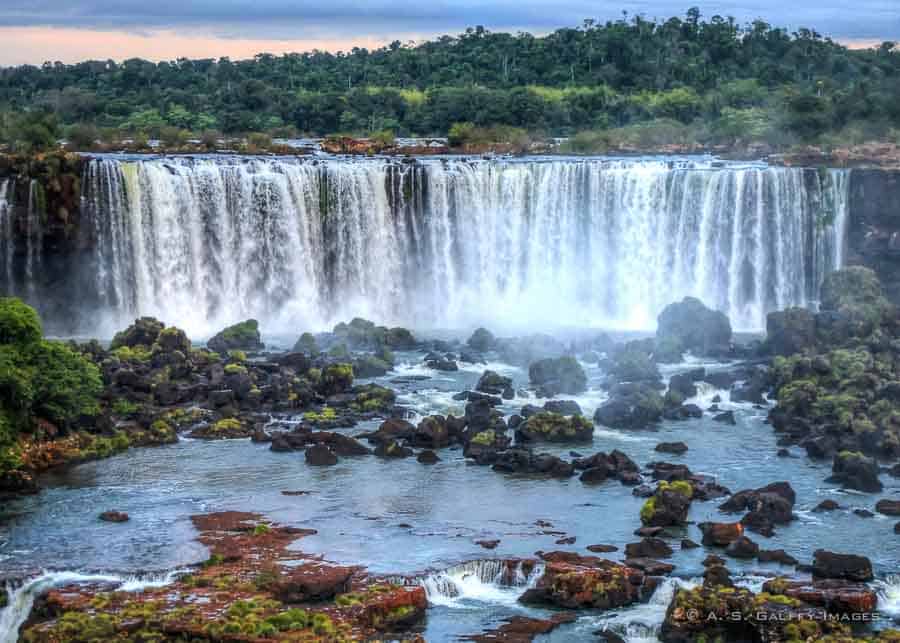
The Ultimate Guide for Visiting the Iguazú Falls Independently
Later in this article, I’ll share with you my top tips for making the most of your visit to the falls, including when to go, how to avoid the crowds, and which extra attractions are worth your money. All the practical information in this guide was updated in 2020 to reflect current prices, exchange rates, visa requirements, etc.
The best way to visit the Iguazú Falls is to approach them from the Argentinean side. By doing that, you’ll steadily get closer and closer so that you can appreciate first their size.
I recommend that you start on the short (but panoramic) upper circuit before heading down the lower circuit. The upper circuit has several viewing points from where you can admire the falls.
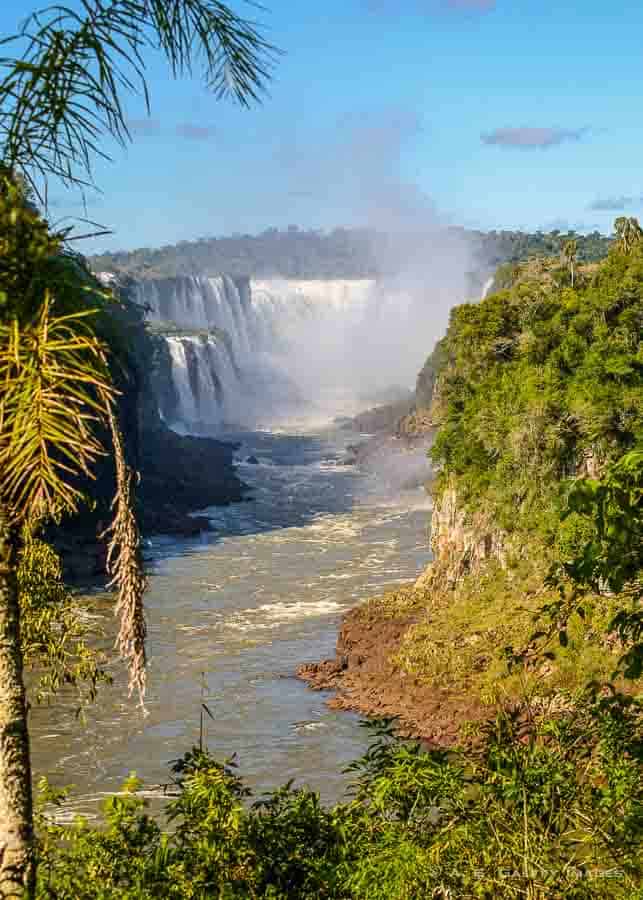
Visiting the Iguazú Falls involves a fair amount of walking through the jungle, so you should come prepared for that. The walking is done mainly wooden decks, but in certain areas you’ll be on birth paths as well.
Mosquitoes at Iguazu are the most active in the spring and summer, but we visited the falls in spring and didn’t have problems. However, if you are prone to mosquito bites, take the usual precautions like wearing long pants and long sleeve shirts, or using insect repellent.
You should allow at least a couple of days for visiting the the Iguazú Falls.

The biggest surprise we had when visiting Iguazu Falls was the abundance of flora and fauna around. There are hundreds of species of butterfly, birds and plants which flourish in the nearby tropical forest, with orchids, palms, lianas and colorful begonias.
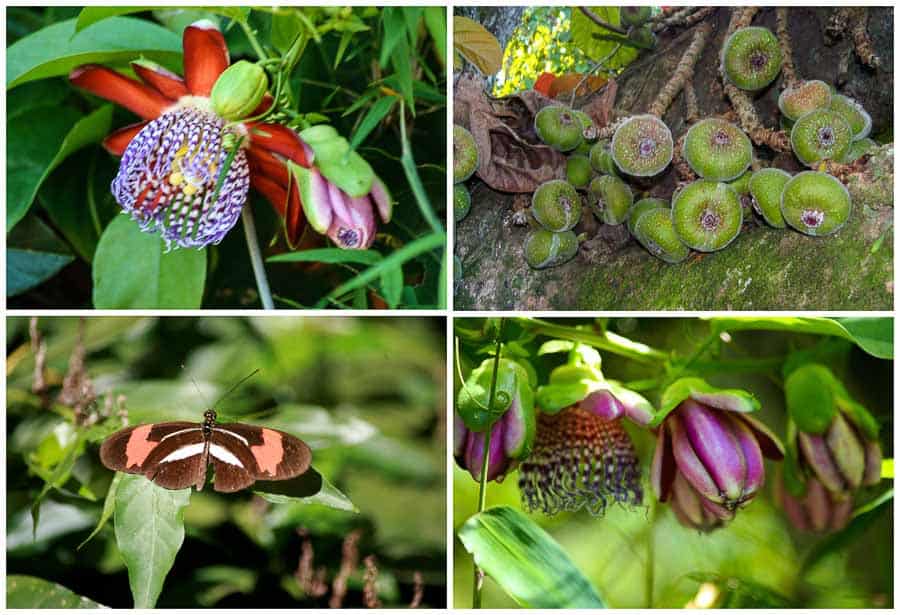
We came across packs of Coati roaming all around the park. Coatis are members of the raccoon family and have long upward-turned noses, long tails and very long non-retractable claws.

Some are brown, some dark gray all are very, very cute. They were especially present around the food stands, bagging for scraps. Although there are signs throughout the park warning visitors that Coatis can attack for food, my experience was different. They seemed very friendly and rather reminded me of little puppies.
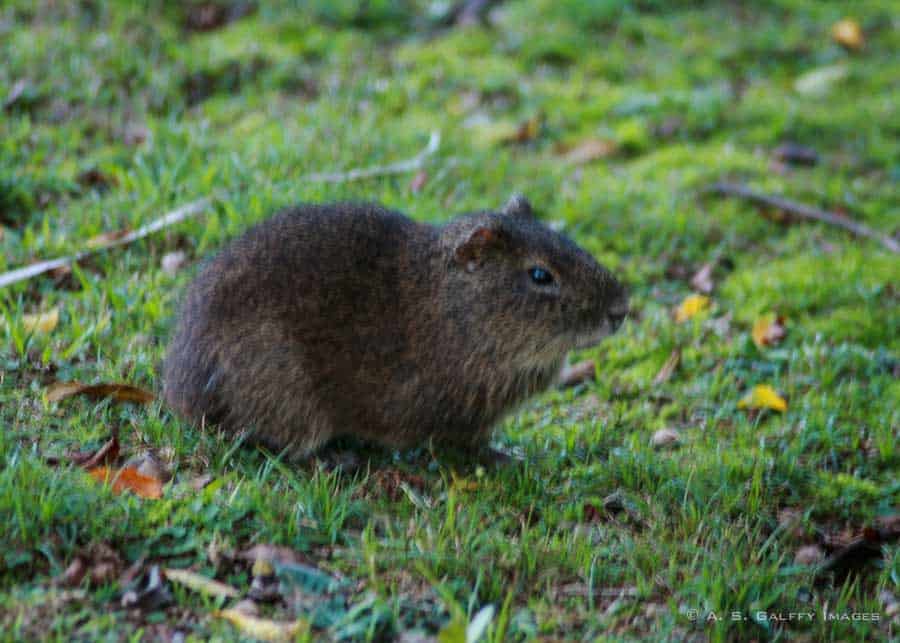
There are also Agouti , which look a lot like guinea pigs, and Capybara, which can be spotted in the more dense forest areas, or around the water. Capibara is the largest rodent in the world and can get as big as 140 pounds and can be over 4 feet tall. They also resemble a guinea pig.
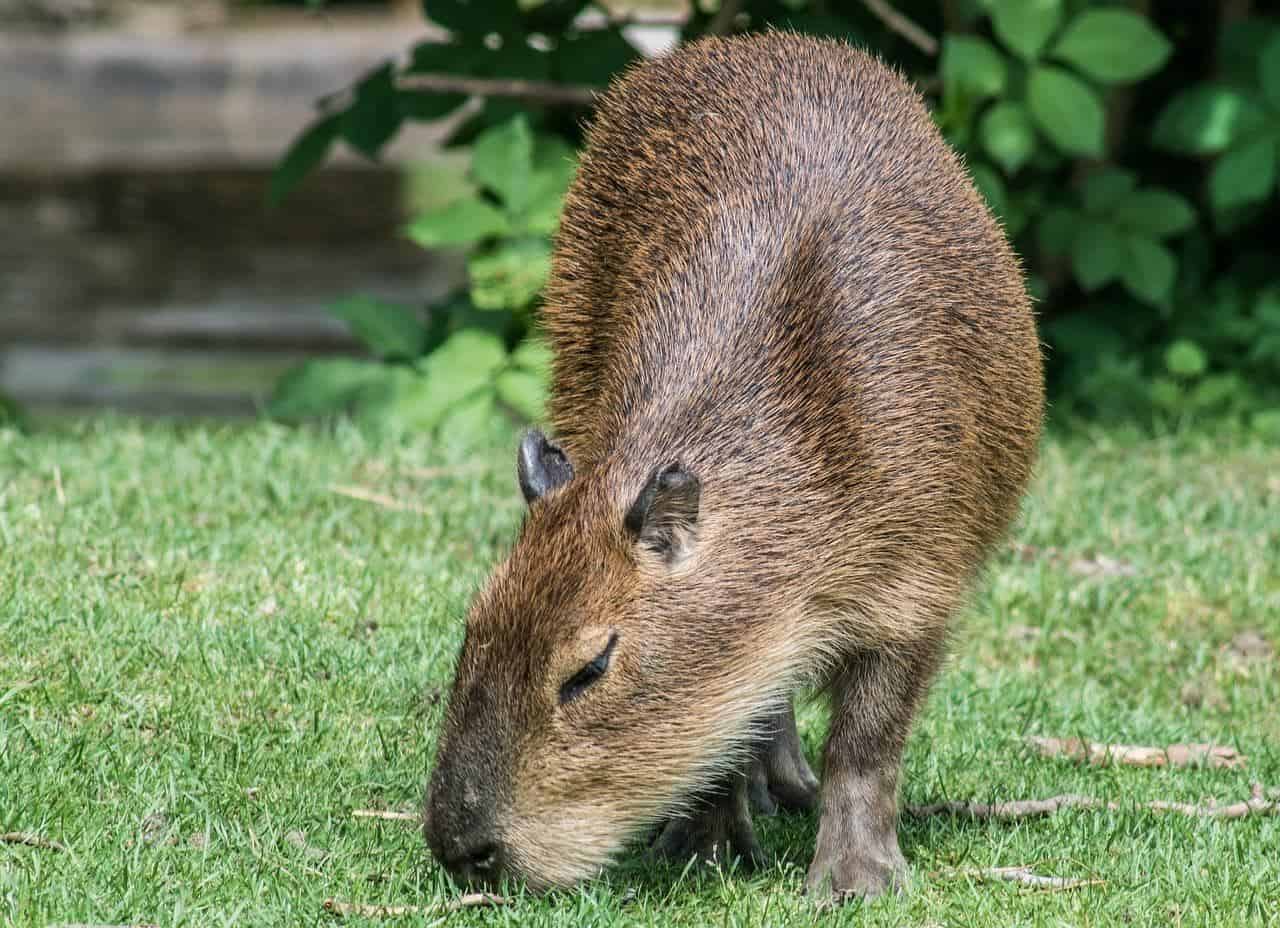
Iguazu Falls are shared by three countries: Paraguay, Brazil, and Argentina. Both Brazil and Argentina have National Parks devoted to them, and they are sufficiently different in character to each merit a visit.
The Argentinian side has a long circuit of trails that is some parts will take you very close to the water, while the Brazilian side offers great panoramic views of the falls. If you can spend two days in Iguazú, you should visit each side on a different day.
On the Argentinian side you can take the Jungle Train to the Fall Station, where there are two walking trails: the lower circuit and the upper circuit. On the lower circuit (about a mile long) you can enjoy the best views of the waterfalls.
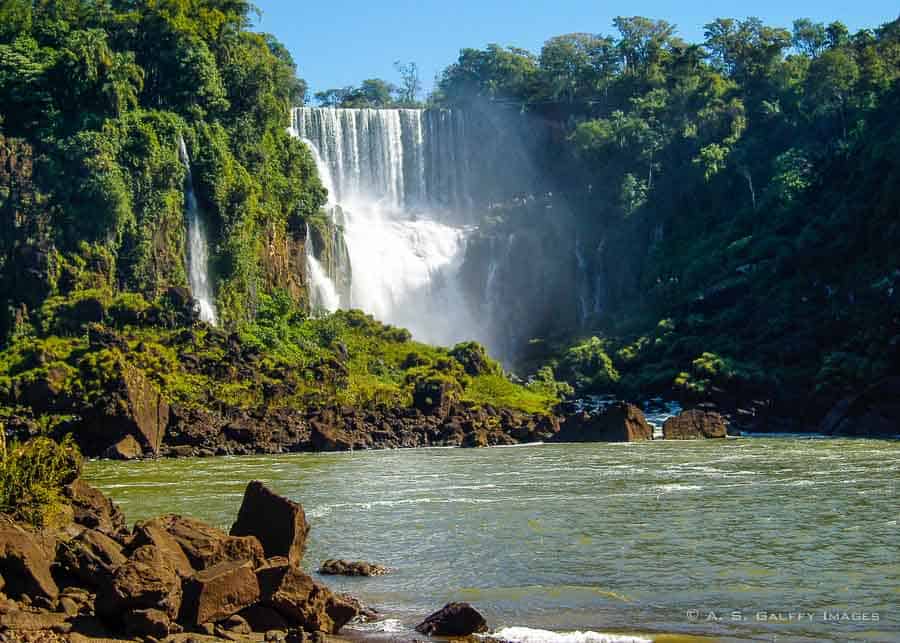
You can climb down to Salto Bossetti falls and catch a ferry to San Martin Island that has a beautiful beach. The upper circuit is slightly shorter and takes you over the canyon. From there you can look down at the waterfalls. On this circuit you can enjoy a lot of birds and a luscious vegetation. You’ll see giant trees, ferns, orchids and many other tropical plants.

The Jungle Train will also take you to the Devil’s Throat ( La Garganta del Diablo ). The U-shaped cliff marking the border between Argentina and Brazil is arguably the most impressive thing at Iguazu Falls. At over 80m (260ft) high, La Garganta del Diablo is the tallest of the waterfalls at Iguazú. We were blown away by the power and greatness of these falls.
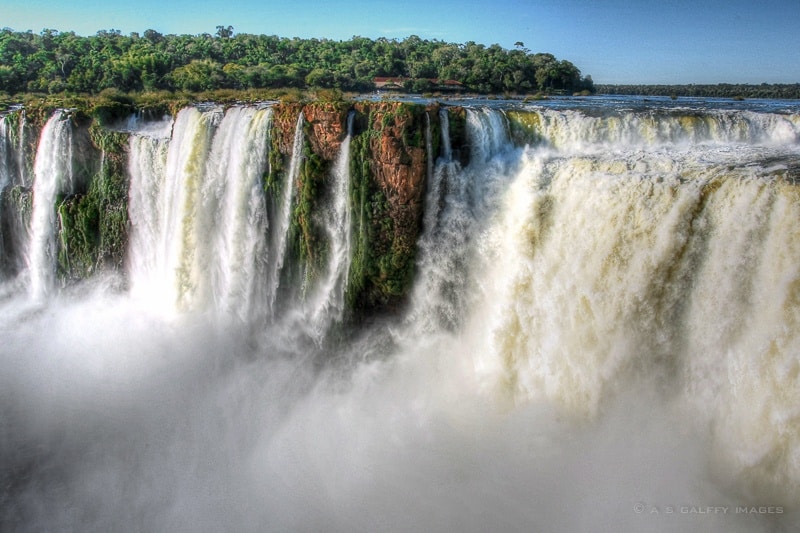
The river waters that run calmly until a few feet away from the drop, turn suddenly into a huge mass of raging waters that roar fiercely just a few feet away from.
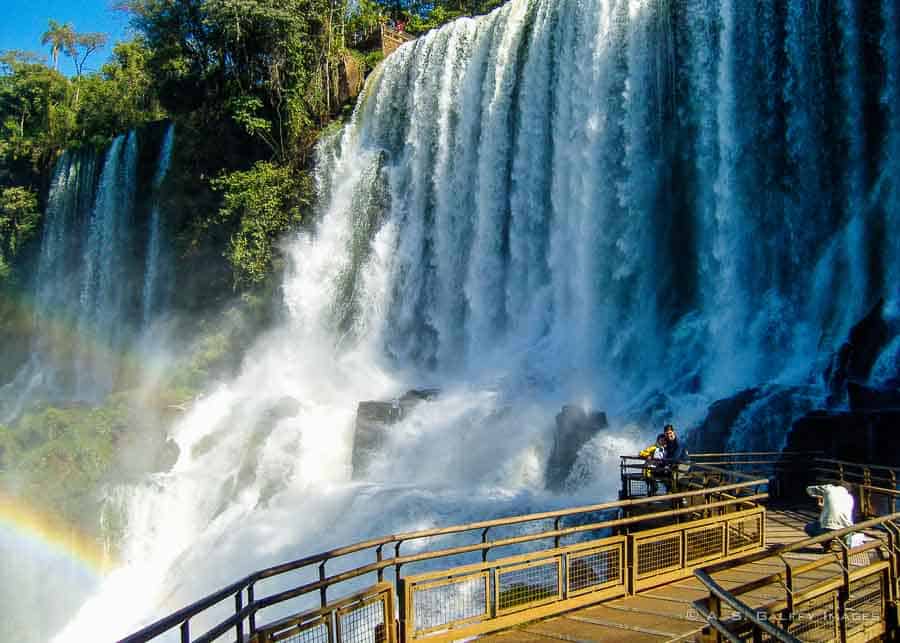
A newly build platform allows you to get pretty close to this site, making the experience overwhelming. The best time of the day to photograph the Devil’s Throat is late afternoon, when the sun shines behind you.
The law says that citizens from the United States, Canada, and Australia must get a visa to enter Brazil, whether it is for just one day or more. Yet, you hear about many American citizens crossing the border to Brazil without any obstacle. Some hotel concierges and tourist agencies ignore the rule to make a few extra bucks.
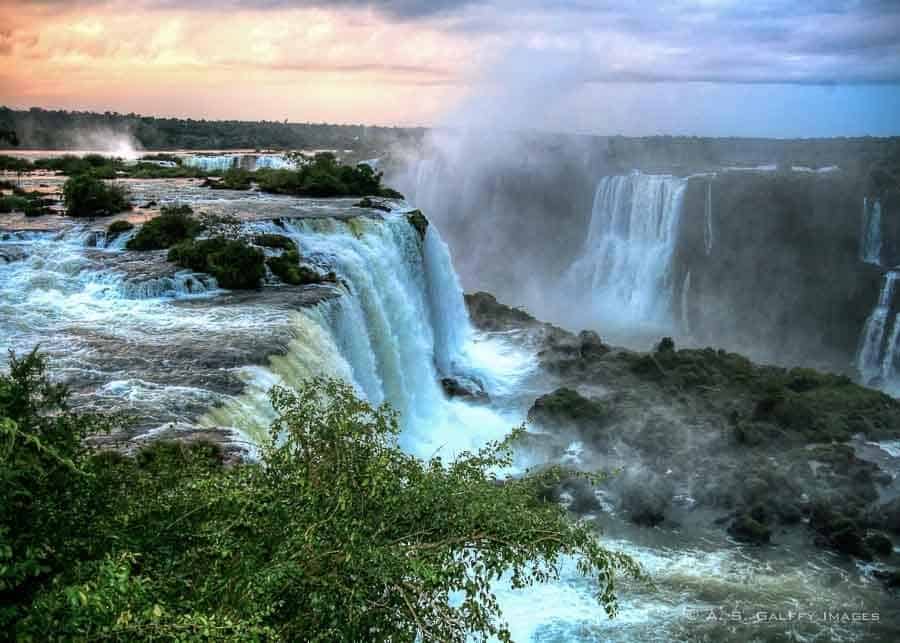
The Brazilian border patrol lets day visitors cross without a visa, if they are accompanied by a reputable local guide. Using the local guide at the Sheraton was apparently good enough because could cross the border without any problem.

So should you pay $140 for the Brazilian visa for just one day? If you want to be on the legal side you probably should. We learned about the rule only after we arrived in Iguazú, but there is not guarantees that this will work for every time.
When planning your visit to Iguazu Falls it’s important to know a little about the weather in this area. The region has a humid, subtropical climate, with cooler temperatures in winter and hot in summer. Rain can come at any time during the year, but there is a dryer season from April to July.
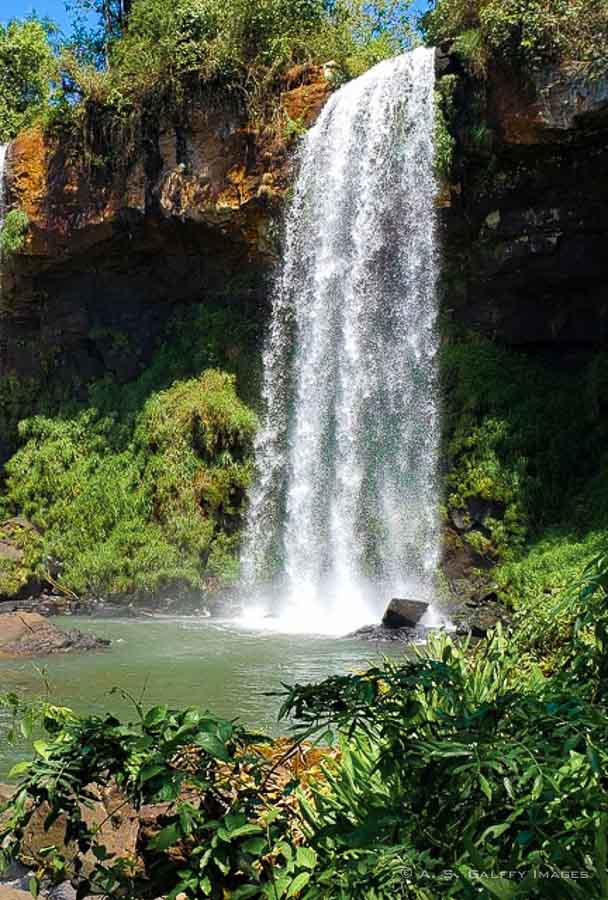
The best time of the year to visit Iguazú Falls is in spring or in fall. We went there in May, when in the Southern Hemisphere is fall time. The weather was pleasantly cool for walking in the morning (6-7°C) and it warmed up a little during the day. We were lucky to have the best possible weather and see the waterfalls at their peek.
Iguazu Falls stretches over a 3 km long rim that is shared by Argentina and Brazil. The quickest and most convient way to get to the falls is by air.
There are two airports within five miles of the falls — Foz do Iguaçu Airport (IGU) on the Brazilian side and Cataratas del Iguazú (IGR) on the Argentinian side. We arrived in Iguazú from Buenos Aires , as there are no direct flights from the USA to Iguazú.
The spread-out entrance complex ends at a train station, with departures every half-hour to the Cataratas train station, where the waterfall walks begin, and to the Garganta del Diablo.
There are many lodging options for all budgets in Puerto Iguazú, about 11 miles away from the waterfalls. Yet, if you can afford to spend more money, staying at the Sheraton Iguazu Falls right in the Park will put you to a big advantage.
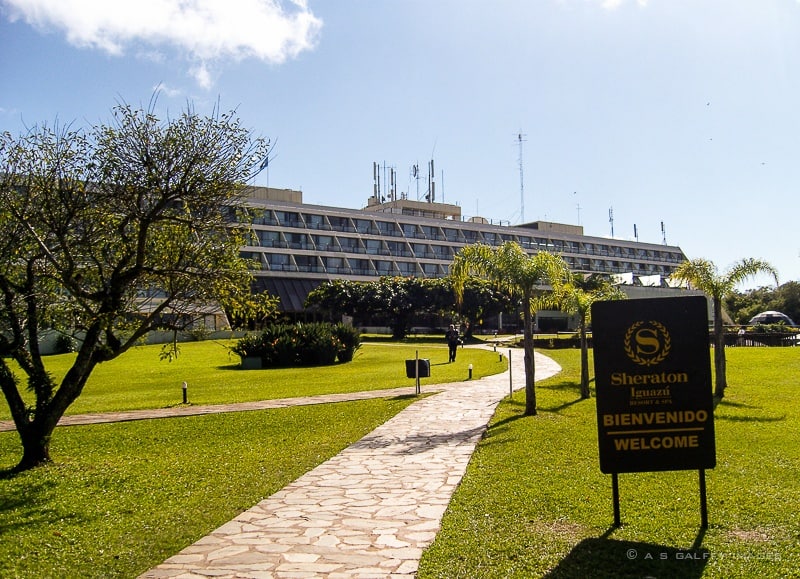
This luxury hotel sits right in the heart of the forest, offering spectacular views the waterfalls. The rooms are clean, spacious and comfortable, but nothing extravagant.
There is a beautiful swimming pool area, a couple of bars and a restaurant. But the greatest benefit of staying in this hotel is that, when the park opens, you can wander out to the falls before the big crowds arrive from the city.
After visiting Iguazu Falls on the Brazilian side, our guide took us to Parque das Aves . This aviary has huge cages where birds are actually able to fly. The visitors can get into some of the cages and mingle with the birds. Some even come very close.

It was a fantastic experience. Not only have we never seen a toucan in real life before, but playing with one and photographing it from a few inches away was more than we expected. They have quite a variety of birds. We’ve seen some species that we didn’t even know existed.
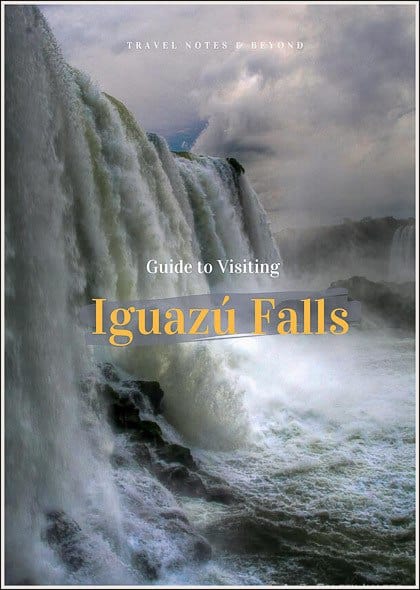
Iguazu Falls is a UNESCO World Heritage Site and in 2011 it became part of the New Seven Wonders of Nature. The two days we’ve spent there are the most memorable ones from our trip to Argentina.
Pin this for later:
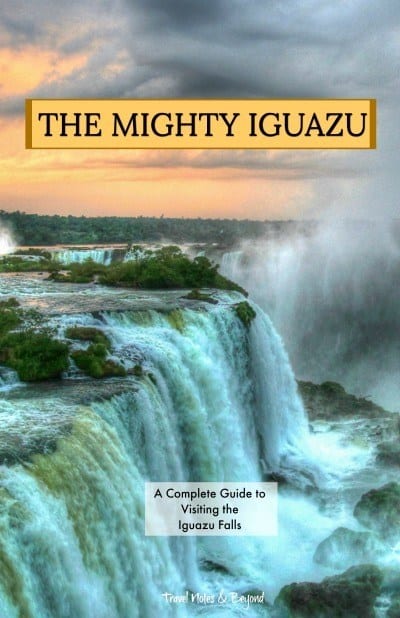
Anda is an award winning travel writer, avid globetrotter and passionate photographer. She is the voice behind "Travel Notes & Beyond," a collection of stories and travel impressions from her wanderings around the world. When she is not busy writing, traveling, or editing photographs, you can find her hiking in the foothills behind her house together with her husband and their dog.

Reader Interactions
Rhonda Albom
July 10, 2018 at 11:09 pm
I am pretty sure we will be there later in the year with my daughter who has been before. I appreciate the inclusion of where to stay, as that is one thing she won’t know. I can’t wait. Your photos are stunning.
Anda Galffy
July 11, 2018 at 12:39 am
I think you’ll have a great time at Iguazu Falls, Rhonda. Just make sure you don’t go there in summer. It’s way too hot.
Samantha Sparrow
February 22, 2018 at 5:02 am
Iguazú National Park has been on my bucket list for so long – right at the top of it! And your breathtaking pictures certainly make me yearn for it more. It’s great you saw it from both sides, that is something I’d like to plan too – and the hotel tip is gold, as staying within the national park makes total sense to me!
February 21, 2018 at 10:11 am
Wow! Your photos took my breath away! All this while the Victoria falls were high on my bucket list and I had decided to visit them from both Zambia and Zimbabwe. But this one honestly makes me want to rethink my Victoria Falls! So gorgeous and so mighty! I love the beauty from the Argentinian side though =)
February 21, 2018 at 11:53 am
I’d love to see the Victoria falls too, Meghna. I’ve heart they are beautiful.
February 20, 2018 at 5:27 am
Wow the mighty Iguazú Falls! I hope to see it from both sides. As suggested by you will look out for a sty option at Sheraton. Loved the colorful captures of the wild life there.
February 19, 2018 at 7:56 pm
I have heard so much about it and have seen it in so many films and TV programs. But it still remains one of the most formidable sights. However, for me the surprise was teh wildlife. Coatis and toucans were a delightful sight and I did not know you can meet them like that.
February 18, 2018 at 7:22 pm
I totally love Iguazú! I’ve been twice and was equally impressed both times as well. I didn’t stay at the Sheraton but I’ve had dinner there as it was Xmas and my birthday as well, loved it!
Megan Jerrard
February 18, 2018 at 4:37 am
Haha I love that quote by Eleanor Roosevelt – Igazu Falls truly are a sight to behold! I would love to get here at some stage, I’ve seen photos but obviously I’m sure it doesn’t compare to witnessing such grandeur in person. Thanks for the tip on staying at the Sheraton – I agree that it would be a big advantage to be able to stay within the national park. Glad to hear that your experience with the Coatis was a friendly one – they do appear rather cute creatures! I’m thinking that the view from Devil’s Throat is one of the most spectacular vantage points. But it’s definitely hard to pick a favorite one!
February 17, 2018 at 6:45 pm
Iguazu Falls is certainly the most stunning waterfall I’ve seen! And i’ve only been to the Argentina side. From your photos, it looks like I should have also gone to the Brazilian side. I liked it so much, I would definitely go again…this time to both sides.
February 17, 2018 at 7:05 am
Oh my god, your photos!?!? Stunning. I definitely need to pay a visit <3
February 17, 2018 at 4:08 am
Both I and my husband love to visit waterfalls. This looks like the ultimate dream destination for us. I can only imagine how the roar of so much water falling would be. I am sure we would love to spend at least 2 days there. Putting this on my wishlist right away.
February 17, 2018 at 12:09 am
Stunning photos! I know visiting Iguazu would blow my mind for sure, but I never realized how cool it would get, I was surprised to see how warmly dressed you guys were! Will aim to visit in the Summer time! (:
February 16, 2018 at 9:52 pm
I’m glad that the falls were named after the indigenous name and not some random European one. The mighty Iguazu falls have been on my bucket list for quite a while. I agree with your suggestion to go to both sides and can’t wait to check them out myself!
March 11, 2016 at 10:38 am
Loved Iguazú Falls when I was there in June 2014. Overall, I had more fun on Argentina’s side of Iguazú Falls because of its adventurous activities, including a speed boat road ride up to the base of the falls. But, the Brazilian side didn’t disappoint with its panoramic views. If speed boats aren’t your “cup of tea,” then Brazil has created a system of pedestrian bridges that allow you to walk towards the base of Devil’s Throat and its sister falls. You get completely soaked, so bring a waterproof camera if you have one. It will be at this point where you realize how massive Iguazú Falls truly is.
March 11, 2016 at 10:56 am
I agree with you, Ray. The Brazilian side has those platforms that allow you to get close to the waterfall, but the Argentinian side is more beautiful.
October 26, 2014 at 6:56 pm
Wow! just wow. Iguazu falls has been on my bucket list, but your photos move it higher up. Spectacular. Thanks for sharing so many, and the birds and wildlife too.
October 26, 2014 at 9:36 pm
Iguazu Falls and the Brazilian Aviary make a spectacular trip. I think you’ll fall in love with that area.
Meg @ Mapping Megan
October 15, 2014 at 10:24 pm
Thanks for all of the great detail on your experience – I love your photos. I love the Argentinian side for getting right up close to the water, though I totally agree with you that the best views are from Brazil. Loved this post 🙂
Michele {Malaysian Meanders}
August 6, 2014 at 9:12 pm
Thank you so much for the tip about staying at the Sheraton. I would happily stay that close to the falls so that I could explore it before the crowds arrive.
August 6, 2014 at 10:50 pm
That was our main reason for choosing this hotel also.
Adelina // Pack Me To
August 6, 2014 at 12:33 pm
Stunning photos and great breakdown of Argentina vs. Brazil. Good to know about the visa requirements. I had no idea. I would love to see these in real life one day.
August 6, 2014 at 12:37 pm
Yea, that’s a catch. We didn’t know either.
August 6, 2014 at 12:14 am
Okay, that definitely beats out Niagra. It looks amazing!
Christa Thompson
August 5, 2014 at 10:44 am
Hey, on behalf of Christa, Host of The Sunday Traveler, I was stopping by to check out your article. I would have to agree, absolutely breathtaking! I never knew of Coatis before. Great pictures throughout. Looks like a trip with memories made that will last a lifetime. I especially enjoyed reading about the Legend behind the falls. Great post, Thank you.
August 5, 2014 at 1:54 pm
Thank you Christa for your your nice comment. I hope you’ll get to see Iguazú Falls someday.
Chanel | Cultural Xplorer
August 4, 2014 at 2:39 pm
Wow! What beautiful falls and such helpful information! I will be bookmarking this page for my future visit 😀
August 4, 2014 at 10:00 am
Those waterfalls are absolutely spectacular and your photos are stunning!
August 4, 2014 at 2:54 pm
Thank you, Rosemary.
Travelling Penster
August 4, 2014 at 6:41 am
Simply breathtaking!! Hoping to make it to Argentina next year some time, and this will definitely be on the list.
August 4, 2014 at 3:00 pm
The real thing is even better!
August 17, 2023 at 8:57 am
* “ULTIMATE GUIDE” but doesn’t talk about what to do on the Brazilian side
August 17, 2023 at 9:00 am
If you look more carefully, you’ll notice that I mention visiting the Aviary on the Brazilian side, Lukas.
August 4, 2014 at 5:15 am
wowww I would so love to see this in real. The waterfall looks so majestic!!! stunning captures.
August 3, 2014 at 7:40 pm
Wonderful photos and a great description of the waterfalls. Wish I was there with you too.
August 3, 2014 at 7:12 pm
Loved your photographs. It’s a place I’ve never visited, but of course would love to one day. We visited Victoria Falls way back when we were backpackers but this is something else 😉
August 3, 2014 at 7:16 pm
Actually they say that Victoria is a bigger waterfall than Iguazú.
August 3, 2014 at 5:10 pm
Stunning, I would love to visit there some day including an extensive trip to Latin America.
August 3, 2014 at 5:59 pm
Iguazú is the second greatest waterfall in the world, after Victoria Falls in Zimbabwe.
August 3, 2014 at 4:19 pm
I’ve been wanting to visit Iguazu for a very long time. Your pictures are awesome and makes me want to go even more! Good to know about the Visa, I didn’t know that Canadian residents would be required to get one if they entered Brazil, even if only for the day!
Amy Lynne Hayes
August 3, 2014 at 10:11 am
Wow – these photos are stunning!! I had a friend who visited from the Brazilian side, and she absolutely loved it (naturally). I would love to visit for myself one of these days.
August 3, 2014 at 10:25 am
Thank you, Amy. It Iguazú was one of the most beautiful things I’ve seen in my life.
August 3, 2014 at 2:21 am
Wow – how did I not even know this existed before now?? Dare I say more beautiful than Niagra Falls? Yeah, definitely just got added to the bucket list.
August 3, 2014 at 10:09 am
Thanks, Mandie. You definitely should visit Iguazú.
August 2, 2014 at 7:25 pm
The falls are just stunning and are definitely on my bucket list.
August 2, 2014 at 9:24 pm
Iguazú Falls are a must-see, definitely.
August 2, 2014 at 10:30 am
Wow, absolutely stunning pictures! I would love to see this wonderful waterfall one day 🙂
Leave a Reply Cancel reply
Your email address will not be published. Required fields are marked *
Save my name, email, and website in this browser for the next time I comment.
COPYRIGHT NOTICE
All rights reserved © Travel Notes & Beyond. The material on this website is protected by copyright law. Republishing the content on this blog (including text, photography, etc.) is strictly prohibited.

AFFILIATE PROGRAM DISCLOSURE
Some of the pages and posts of this blog contain links to products and services that may be useful for my readers. When clicking on these links you will have the option to purchase or register for a service at no extra cost to you, but doing so can help me offset the costs associated with running this blog. Thank you for your support!

Getty Images/iStockphoto
Iguazú Falls
One of the planet’s most awe-inspiring sights, the Iguazú Falls are simply astounding. A visit is a jaw-dropping, visceral experience, and the power and noise of the cascades – a chain of hundreds of waterfalls nearly 1.85 miles (3km) in extension – live forever in the memory. An added benefit is the setting: the falls lie split between Brazil and Argentina in a large expanse of national park, much of it rainforest teeming with unique flora and fauna.
Attractions
Must-see attractions.
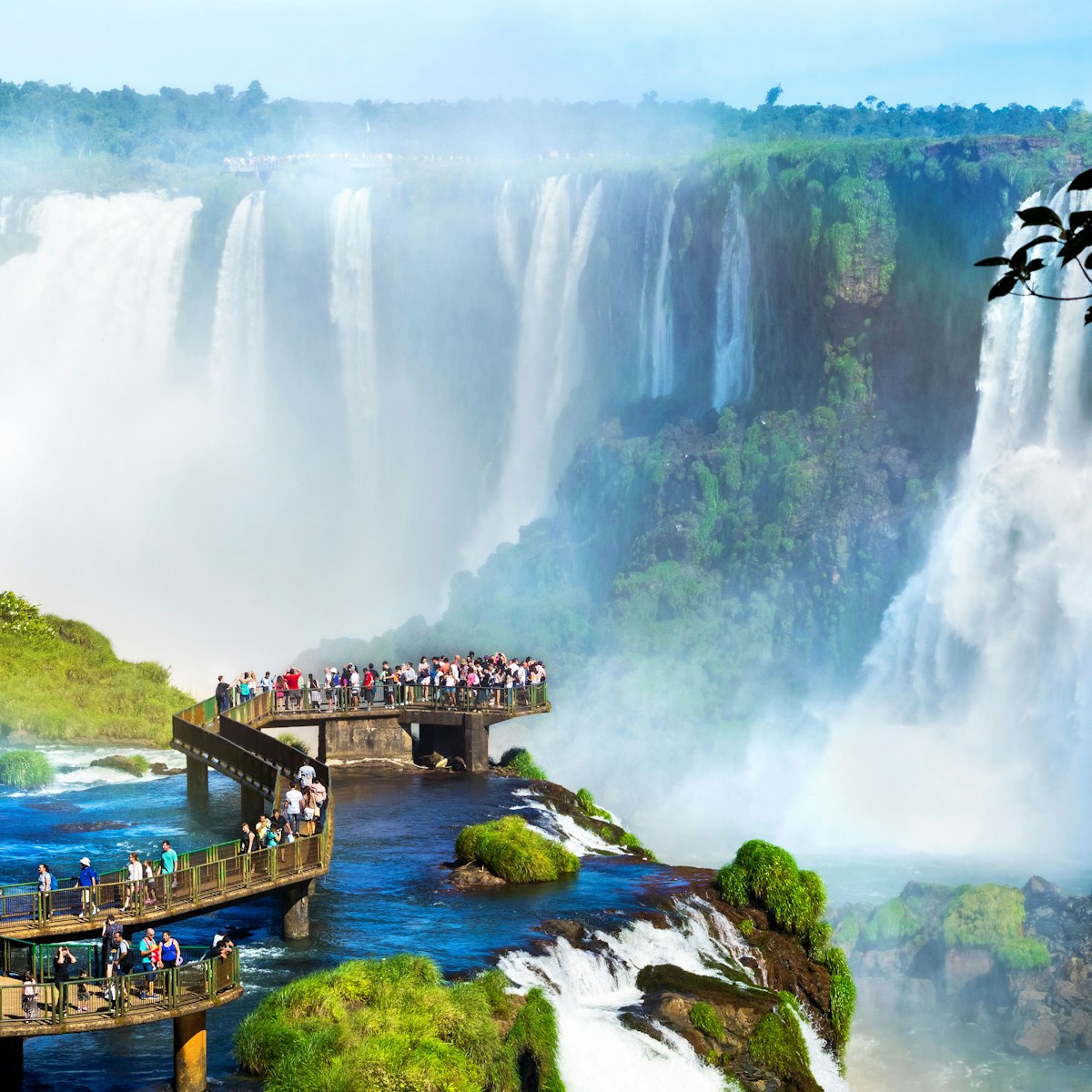
Parque Nacional Iguazú
On the Argentine side of the marvelous falls, this park has loads to offer, and involves a fair amount of walking. The spread-out entrance complex ends at…

Garganta del Diablo
A 1.1km walkway across the placid Río Iguazú leads to one of the planet’s most spectacular sights, the 'Devil’s Throat.' The lookout platform is perched…
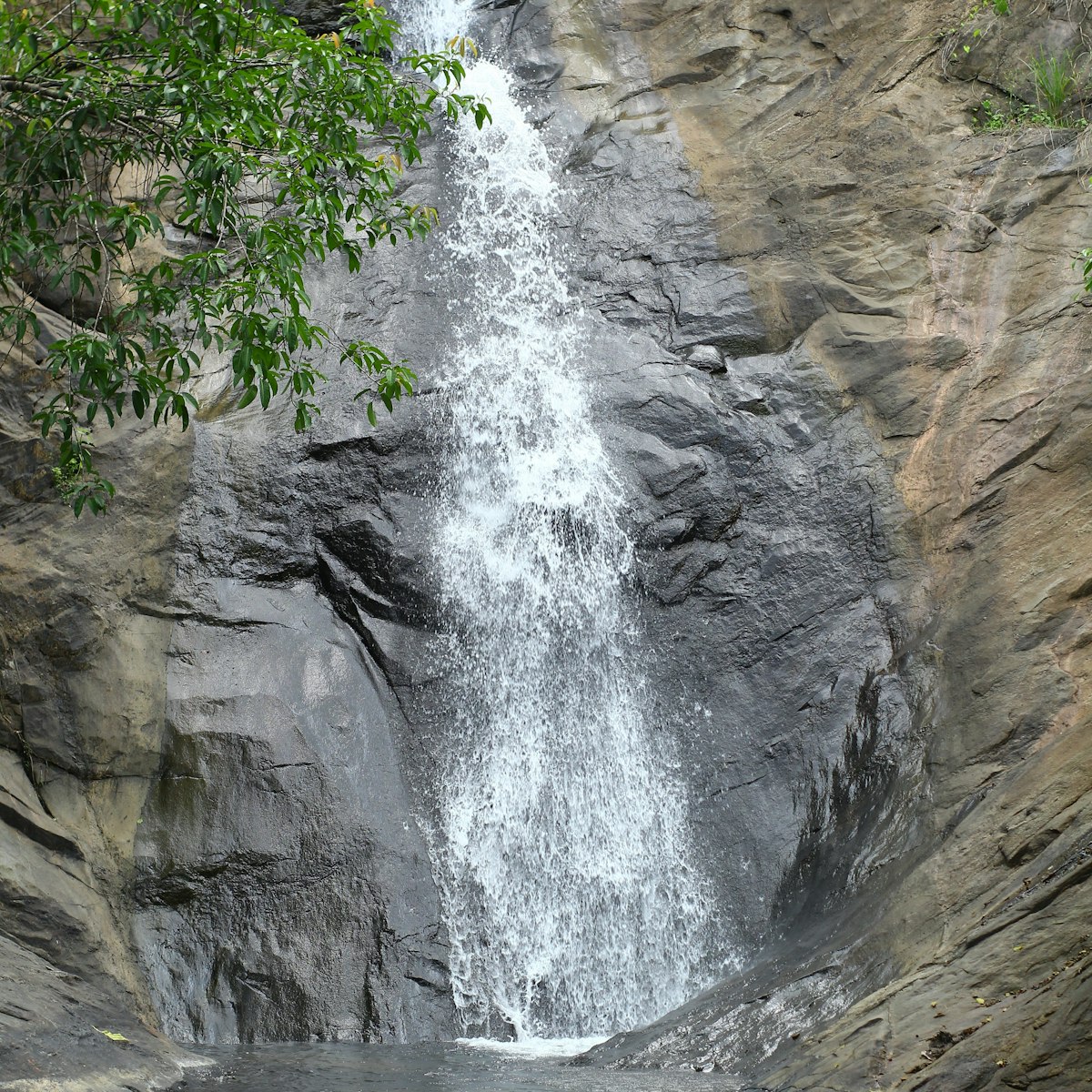
Circuito Inferior
This circuit (1400m) descends to the river, passing delightfully close to falls on the way. At the end of the path prepare for a drenching at the hands of…
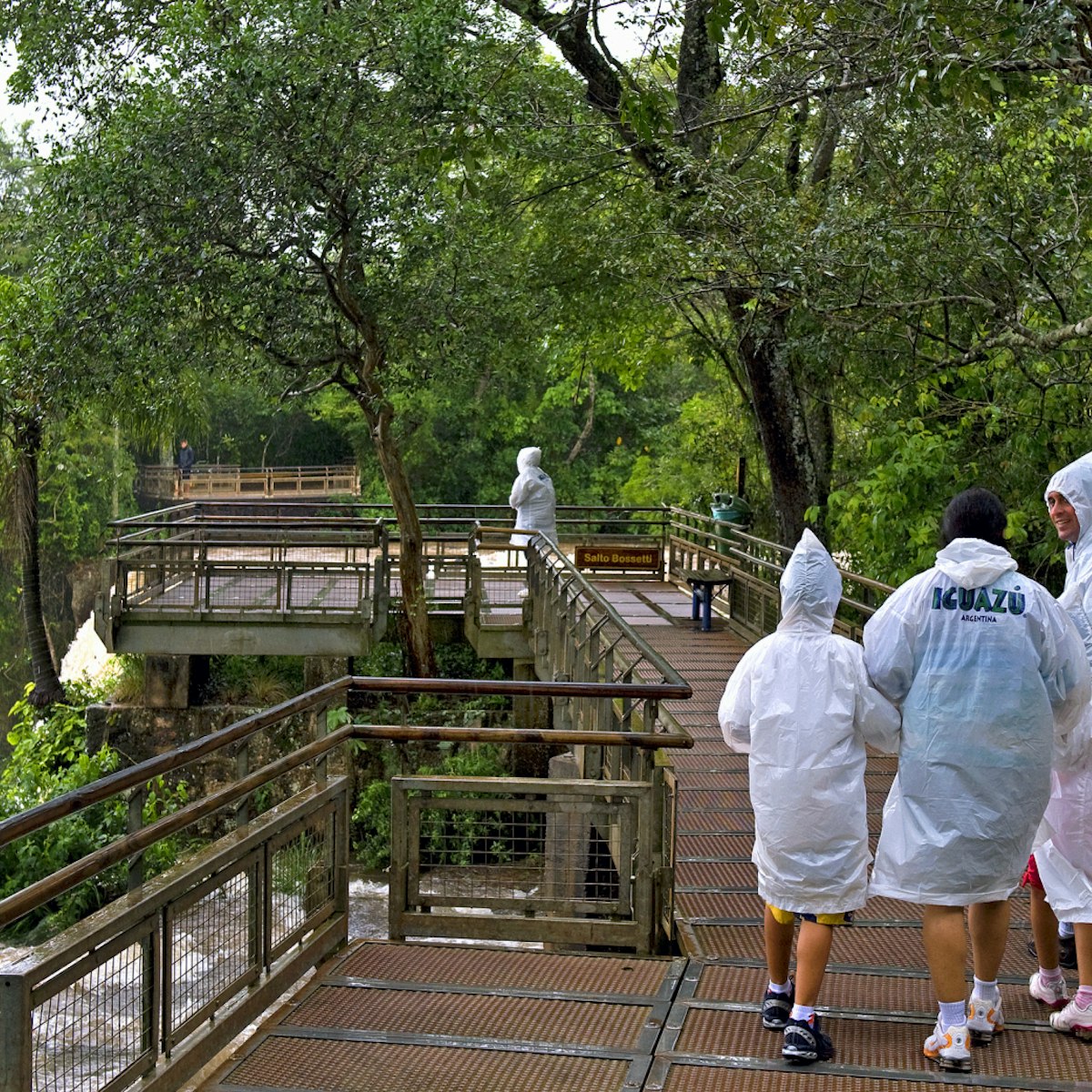
Circuito Superior
The Paseo Superior (1750m) is entirely level and gives good views of the tops of several cascades and across to more. A recently constructed final section…

Isla San Martín
From the end of the Paseo Inferior, a free launch takes you across to this island with a trail of its own that gives the closest look at several falls,…

Puerto Iguazú
On the way to the falls, this is an animal hospital and center for rehabilitation of injured wildlife. It also carries out valuable research into the…

Hito Argentino
A kilometer west of the center, this is a great viewpoint with a small obelisk painted in Argentine colors at the impressive confluence of the Ríos Paraná…

Casa Ecológica de Botellas
About 300m off the falls road, this fascinating place is well worth a visit. The owners have taken used packaging materials – plastic bottles, juice…
Plan with a local
Experience the real Argentina
Let a local expert craft your dream trip.
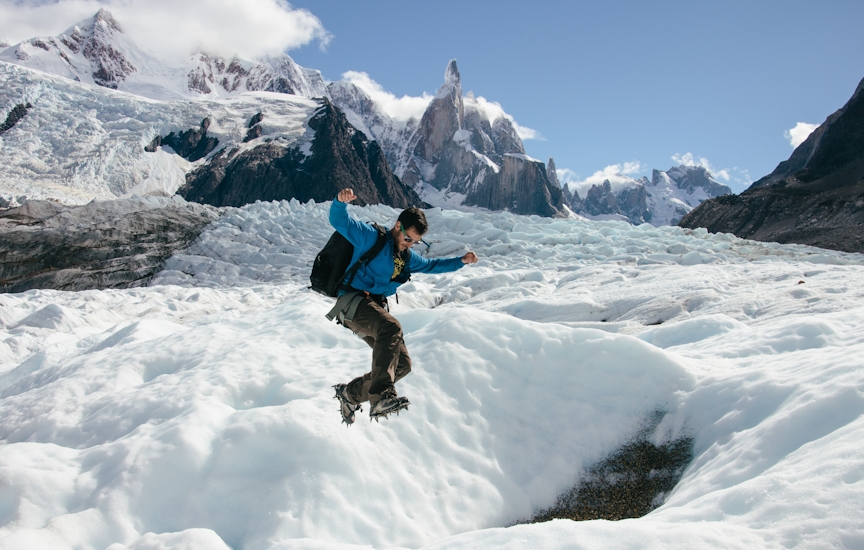
Latest stories from Iguazú Falls
Filter by interest:
- All Interests
- Adventure Travel
- Art & Culture
- Beaches, Coasts & Islands
- Food & Drink

Wildlife & Nature
Jul 3, 2017 • 5 min read
South America is known for many things – incredible culture, gorgeous beaches, amazing food. But most striking might be the continent’s sheer geographical…
Iguazú Falls and beyond

- Best Time to Visit
- Weather & Climate
- Airports in Argentina
- Driving Guide
- One-Week Itinerary
- Top Places to Visit
- Most Popular Cities
- Best National Parks
- Top Things to Do
- Best Places to Hike
- Skiing in Argentina
- Things to Do in Mendoza
- Things to Do in Bariloche
- Things to Do in Ushuaia
- Guide to Iguazu
- Argentina's Glaciers
- Every Food to Try
- Search Please fill out this field.
- Newsletters
- Central & South America
- More to Explore
- Things To Do
Iguazu Falls Travel Guide: Planning Your Trip
Planning your trip, things to do, what to eat and drink, where to stay, getting there, money saving tips.
Taller and wider than Niagara Falls , with 275 cascades spread into a horseshoe shape over nearly 2 miles of the Iguazu River, Iguazu Falls attract nearly 2 million nature lovers and adventure travelers to the "Triple Frontier"—the intersection of Argentina, Brazil, and Paraguay—every year. Also spelled Iguaçu Falls, they are UNESCO-recognized and together make up the largest waterfall in the world.
The South American spectacle—surrounded by the area's characteristic tropical vegetation—is the result of a volcanic eruption. It's named after the Guaraní word for "great water." Some of the most famous include San Martin, Bossetti, Bernabe Mendez, and Devil's Throat ( Gargantua del Diablo ), with its perpetual spray high over the falls. The attraction is just 16 miles outside of Puerto Iguazu, Argentina, and 18 miles from Foz de Iguaçu, Brazil, and can be viewed from either country.
There are a few things you should know before planning a visit to this impressive waterfall.
- Best Time to Visit : The best time to see Iguazu Falls is in the spring or fall. Summer is intensely hot and humid and winter is wet; however, this is when the water reaches an astonishing flow rate of 450,000 cubic feet (12,750 cubic meters) per second, about 800 times the average. If you don't mind a bit of rain, it's an extraordinary time to see the falls.
- Language : Both sides speak Portuguese.
- Currency : In this multicultural region, Argentinian pesos, Brazilian reais, and U.S. dollars are accepted. To be safe, though, you should use the currency of the country you're visiting.
- Getting Around : You can catch a ride directly from the Cataratas International Airport via the Four Tourist Travel shuttle for about $1.60 per person, or by a remis —a taxi, essentially—for about $5. From Puerto Iguazu, a public bus runs from the main terminal every 20 minutes and costs $6. From the Brazil side, buses run every 22 minutes from the main terminal of Foz de Iguaçu and cost $1.
- Travel Tip : Bring a poncho as you're likely to get wet from the spray of the falls. And don't forget to reapply mosquito repellent and sunscreen after—the hot and humid climate will require it.
There is enough to keep a traveler entertained for two full days at Iguazu Falls, so plan your visit accordingly. You won't want to leave before shopping for handicrafts in Puerto Iguazu markets, walking the jungle trails around the falls, and exploring the surrounding attractions. One necessary stop is the Bela Vista Biological Refuge (Foz do Iguaçu), which hosts two-hour guided tours showcasing its 50 resident animal species (monkeys, anteaters, jaguars, and more). Another is the Jardin de los Picaflores (Puerto Iguazu), a haven for hummingbirds.
- Visit Iguazu National Park: For a close-up view, walk through the subtropical forest of National Iguaçu Park (covering territory in both countries) to the base of Salto Floriano and take the elevator to the top of the falls, or walk out over the falls at Salto Union. From the Argentina side, you can follow a series of catwalks over the water rushing into Devil's Gorge. Protective rain suits are provided. There are some areas where it is possible to swim in the spray of the cascades, too.
- Sightsee by boat: Iguazu Falls are packed with adventurous activities from zip lining to a "Green Train" that goes through the jungle, but perhaps the most exciting is riding in a boat at the base of the falls. Jet boats departing from the Circuito Inferior and Puerto Macuco go right into San Martin—prepare to get drenched.
- Get an aerial view: If you'd rather marvel at the natural wonder from above instead, consider a helicopter ride. These 10-minute flights showcase the grand splendor of Iguazu Falls and cost between $100 and $150 per person, on average. Most often, you can get picked up directly from your hotel room.
There are so many things to do in Iguazu Falls, it would be nearly impossible to see everything on your own account. Check out our guide to the best Iguazu Falls tours for a more thorough experience.
Argentinian and Brazilian cuisines showcase the finest South American fare there is. The empanadas —portable pockets of sweet and savory fillings—and choripán —a pork and beef chorizo street-food staple—are unrivaled, while the rich and milky dulce de leche makes for a perfect obligatory post-meal treat. Iguazu Falls are, of course, a blend of several cultures, so expect the food here to incorporate flavors from around the continent and world.
The region is known for its chipa guazu (salty corn pie), sopa paraguaya (savory sponge cake), and seafood (river fish, especially). Iguazu's best from-the-ocean fare can be sampled at Restaurante Tempero da Bahia , a slightly upscale Brazilian eatery that also hosts regular musicians. The place to try Brazilian-style barbecue (aka churrasco) is perhaps at Rafain Churrascaria Show , a carnivorous haunt with frequent music and dance performances.
For international flavors, there's Foz do Iguaçu's La Maffia Tratoria , whose owner is both Italian and Brazilian. The thematic, "Godfather"-inspired interior is perpetuated by a mouthwatering menu of pasta, meats, and wine.
Apart from the plethora of sit-down restaurants, you'll find an abundance of sidewalk stalls serving choripán and empanadas in the markets.
Being such a tourist-popular region, the Triple Frontier has no shortage of hotels. Visitors of Iguazu Falls have a choice of Argentina or Brazil, even—each is a similar distance from the falls, but the latter is said to be more scenic and generally cheaper. You can visit both sides of the falls on a single trip—and some do—but be prepared to face some red tape at the border. For convenience's sake, it may be best to pick a side and stick with it.
- Belmond Hotel des Catarates : In Brazil—the side known for its panoramic views versus Argentina's bird's-eye views—has perhaps the most extravagant Iguazu Falls hotel of all: the a pink, five-star rainforest hideaway with on-property views in the national park. The amenities (a pool, spa, gardens, its own buffet, and more) are almost as much of a selling point as its unmatched location.
- Continental Inn : A mid-range luxury option in Foz do Iguaçu is this four-star hotel, which has pools and a sauna and is much closer to things in town.
- Awasi Iguazu : For a taste of luxury on the Argentina side, this hotel provides an intimate, all-inclusive option with only 14 villas. Excursions to the falls are included in the price, which starts at $1,000 per person.
There are hostels on both sides, from the more upscale CLH Suítes Foz do Iguaçu and budget-friendly Suite Cardoso in Brazil to the top-rated Iguazu Falls Hostel in Puerto Iguazu. For more options, check out our guide to the top places to stay in Iguazu Falls.
Getting to Iguazu Falls should be a relatively easy matter. After choosing which side to stay on, you'll want to book a flight to the nearest airport, either Foz do Iguaçu Airport (IGU) in Brazil or Cataratas del Iguazu (IGR) in Argentina. It's best not to attempt crossing the border immediately after arriving or before departing—definitely not before departing—as it could take a long time to cross the border (assuming you succeed in crossing at all).
- How to Get There From Buenos Aires: The easiest way to get from Buenos Aires to Iguazu Falls is to take a two-hour flight from El Palomar (EPA) to IGR, then take a 16-minute taxi or shuttle to the falls (or your hotel). Flybondi runs the route at least once a day.
- How to Get There From Rio de Janeiro: The flight from Rio de Janeiro -Santos Dumont Airport to Iguazu takes about three and a half hours, while a flight from Rio De Janeiro-Galeao takes only about two hours. Both arrive via IGU and have several airline options departing throughout the day.
- How to Get There From Sao Paulo : Sao Paulo is just over 500 miles from Iguazu Falls and the flight to IGU takes an hour, 40 minutes. LATAM Airlines, Azul, and Gol serve the route regularly, but LATAM is the cheapest, with flights on offer for under $100.
- How to Get There From Asuncion: Although Asuncion, Paraguay, is one of the closest starting points, it's also one of the most difficult and expensive, as there are no direct flights from its airport (ACU) to IGU or IGR. Instead, you have to fly to Cuidad del Este and catch an hour-long taxi ride to the falls. If you would rather rent a car, the drive takes about five hours.
South America is generally a cheap continent to travel in, but not all countries are equally budget-friendly. Brazil, for instance, is said to be one of the most expensive, even though it does have a number of cheap hotels and cities.
- Take the bus: Although taxi rides and guided tours offer the coziest option for getting to the falls from Puerto Iguazu or Foz de Iguaçu, the bus will always be the most economical option. Buses run to and from the attraction frequently and cost about $1 to ride.
- Dine in town, not at the park: The average person can eat on about $6 a day in Argentina. Street food (even restaurant food) is notably cheap in this region, but bear in mind it tends to be wildly overpriced in the national park (because this is the only nearby food option). It's best to fill up before venturing out of town or to pack food for the day.
- In Argentina, exchange your U.S. dollars for pesos at a currency exchange rather than taking money out of an ATM.
- If you're in the market for a souvenir, buy one at one of the markets in town rather than in the park.
Related Articles
More related articles.

- Travel Guide
15 Must-Visit Attractions in Iguazu Falls, Argentina | Amazingworld
- 11 minute read
- November 21, 2023
Which activities offer the most breathtaking views in Iguazu Falls, Argentina?

Are you ready to embark on a captivating journey through the spellbinding beauty of Iguazu Falls, Argentina? Brace yourself for an updated exploration, as we unveil the top 15 exhilarating experiences awaiting your discovery amidst this natural wonderland.
Iguazu Falls stands as a testament to nature’s awe-inspiring prowess, boasting a mesmerizing collection of cascading waterfalls surrounded by lush rainforests. In this updated guide, we’ll uncover a myriad of adventures and activities curated to amplify your visit to this UNESCO World Heritage Site. From heart-pounding adventures like the Jet Boat Safari to serene moments in thermal baths, there’s something for every traveler seeking to immerse themselves in the magic of this breathtaking landscape.
Prepare to witness the thunderous roar of the falls and explore UNESCO-listed trails that offer panoramic views. Delve into cultural experiences, encounter diverse wildlife, and soar high above the cascading waters on a helicopter tour. This comprehensive guide will lead you through an enchanting array of activities, ensuring your Iguazu Falls expedition is brimming with unforgettable moments.
Join us as we navigate through the top 15 must-do adventures in Iguazu Falls, Argentina , embracing the exhilarating, the serene, and the awe-inspiring facets of this natural wonder, inviting you to explore and revel in its boundless splendor.
“If you are looking for the best hotel and flight deals for your next vacation, then we recommend booking your bundled flight and hotel through hotwire.com . “
Bali travel quiz
Your answer:
Correct answer:
Your Answers
A Brief Overview of Iguazu Falls

Iguazu Falls, located on the border of Argentina and Brazil, is one of the most awe-inspiring natural wonders in the world. It consists of a collection of approximately 275 individual waterfalls that span nearly 2.7 kilometers (1.7 miles) in width, making it wider than Niagara Falls and taller than Victoria Falls.
The falls are situated within two UNESCO World Heritage Sites: the Iguazu National Park in Argentina and the Iguaçu National Park in Brazil. The name “Iguazu” comes from the Guarani or Tupi words, meaning “big water.”
The most iconic and powerful section of the falls is the Devil’s Throat (Garganta del Diablo in Spanish or Garganta do Diabo in Portuguese), where the majority of the water rushes through a U-shaped chasm, creating a thunderous spectacle as it plunges over 80 meters (262 feet) into the gorge below.
The sheer volume of water, the lush surrounding rainforest, and the diverse wildlife in the area contribute to the mesmerizing beauty and unique ecosystem of Iguazu Falls, attracting visitors from around the globe.
The falls can be experienced from various vantage points, offering different perspectives of this natural wonder and providing opportunities for exploration, adventure activities, and appreciation of its breathtaking grandeur.
15 Things to do in Iguazu Falls, Puerto Iguazu, and Foz do Iguacu
1. jet boat safari: experience an exhilarating ride under the falls..
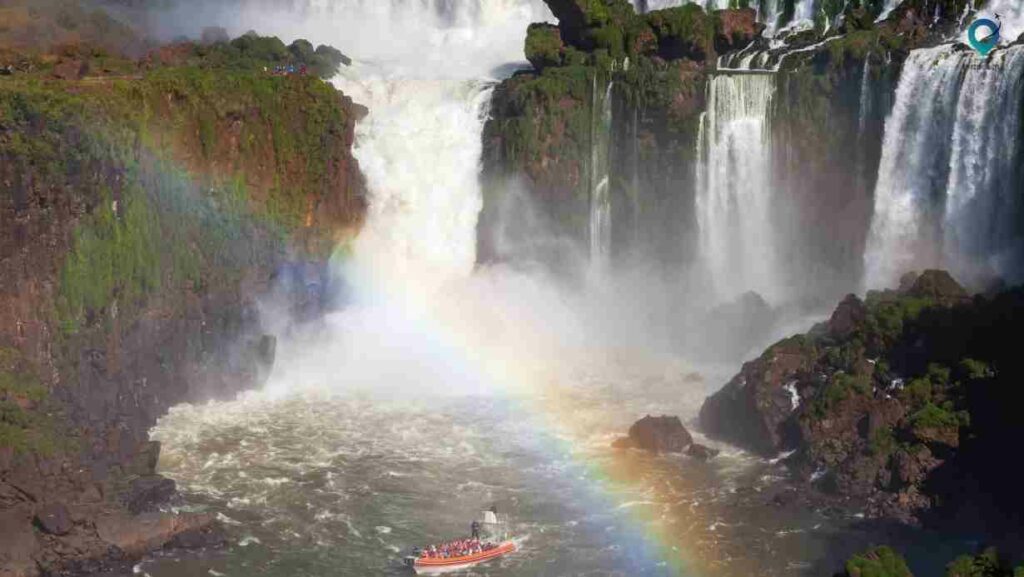
The Jet Boat Safari at Iguazu Falls is an adrenaline-pumping adventure that allows visitors to get up close and personal with the immense power and misty embrace of the falls. This thrilling experience takes participants on a high-speed boat ride along the Iguazu River, navigating through the rapids and ultimately venturing beneath the cascading waters of the falls themselves.
The adventure begins as visitors board specially designed boats equipped to withstand the intense currents and spray of the falls. The boat captains, experienced and knowledgeable about the river’s dynamics, skillfully maneuver through the river, providing a thrilling yet safe experience.
2. Hike, Bike, and Paddle: Explore trails, cycle paths, and kayaking adventures around the falls.

Exploring the Iguazu Falls region involves a myriad of activities for nature enthusiasts and adventure seekers. Hiking, biking, and kayaking offer immersive ways to experience the stunning landscapes surrounding the falls.
Hiking Trails : The Iguazu National Park and Iguaçu National Park boast a network of well-marked trails catering to varying fitness levels. Visitors can embark on guided or self-guided hikes, discovering the lush rainforest, diverse flora, and occasional wildlife sightings along the way. Trails like the Macuco Trail lead to panoramic viewpoints, while the Lower and Upper Circuit trails offer close-up encounters with the falls.
Cycling Paths: Cyclists can explore designated cycling paths around the parks, offering a different perspective and a chance to cover more ground. These paths provide a scenic journey through the verdant landscapes, allowing riders to enjoy the natural beauty at their own pace.
Kayaking Adventures : Adventurous souls can opt for kayaking experiences along the Iguazu River. Paddling through the river’s gentle currents and taking in the surrounding scenery provide a unique way to appreciate the tranquility and beauty of the area. Kayaking tours often offer glimpses of wildlife along the riverbanks, adding to the thrill of the adventure.
Exploring these trails, cycle paths, and kayaking opportunities not only allows visitors to immerse themselves in nature but also provides an active and engaging way to discover the diverse ecosystems and stunning vistas around the Iguazu Falls.
3. Parque das Aves: Visit this bird park to witness diverse avian species up close.
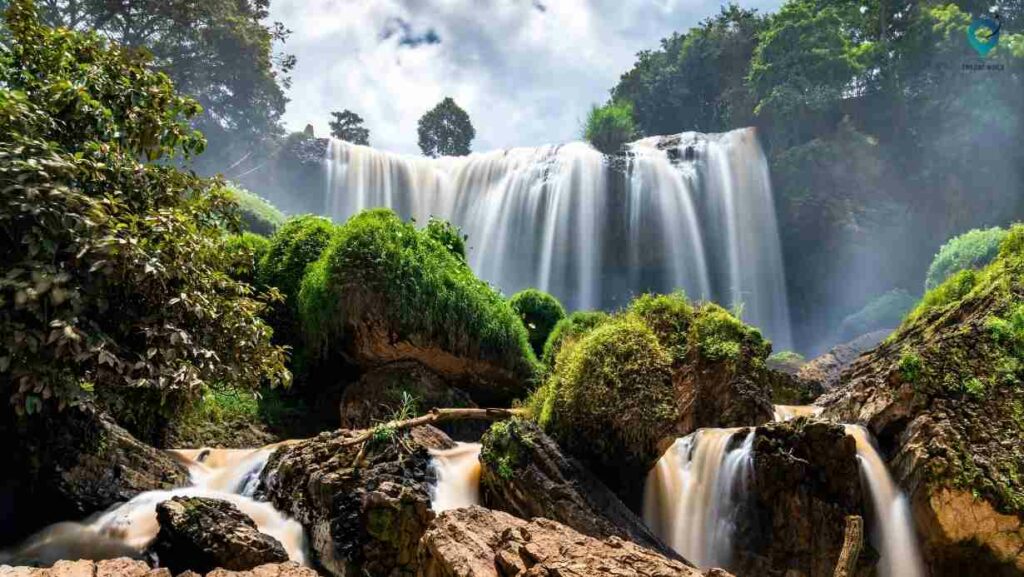
Parque das Aves, meaning Bird Park in Portuguese, is a delightful sanctuary adjacent to the Iguazu Falls. This conservation project serves as a haven for a myriad of bird species, offering visitors a captivating experience amidst lush surroundings.
Avian Diversity: The park is home to an impressive array of avian species, including toucans, macaws, parrots, and colorful tropical birds. Visitors have the opportunity to observe these birds up close in spacious aviaries designed to mimic their natural habitats.
Interactive Experiences : Parque das Aves also offers interactive experiences where visitors can learn about conservation efforts and the importance of preserving these diverse ecosystems. Educational presentations and encounters with birds provide insight into their behavior, habitats, and conservation challenges.
4. Marco Das Américas: Stand at the tri-border between Brazil, Argentina, and Paraguay for panoramic views.

Marco das Américas, also known as the Triple Frontier, marks the meeting point of Brazil, Argentina, and Paraguay. Positioned at this unique geographic intersection, visitors can enjoy breathtaking panoramic views and witness the convergence of the Iguazu and Paraná rivers.
Panoramic Vistas : Standing at Marco das Américas offers visitors stunning vistas of the surrounding landscapes, including the vast river systems and the distinct borders of the three countries. It’s an excellent spot for capturing memorable photographs and appreciating the geographical significance of this meeting point.
Cultural Significance : Apart from its geographical importance, Marco das Américas holds cultural significance, reflecting the shared borders and histories of these neighboring nations. Visitors can gain insights into the cultural diversity and historical connections of the region while taking in the panoramic views.
5. Iguazu National Park: Explore UNESCO World Heritage-listed trails and viewpoints
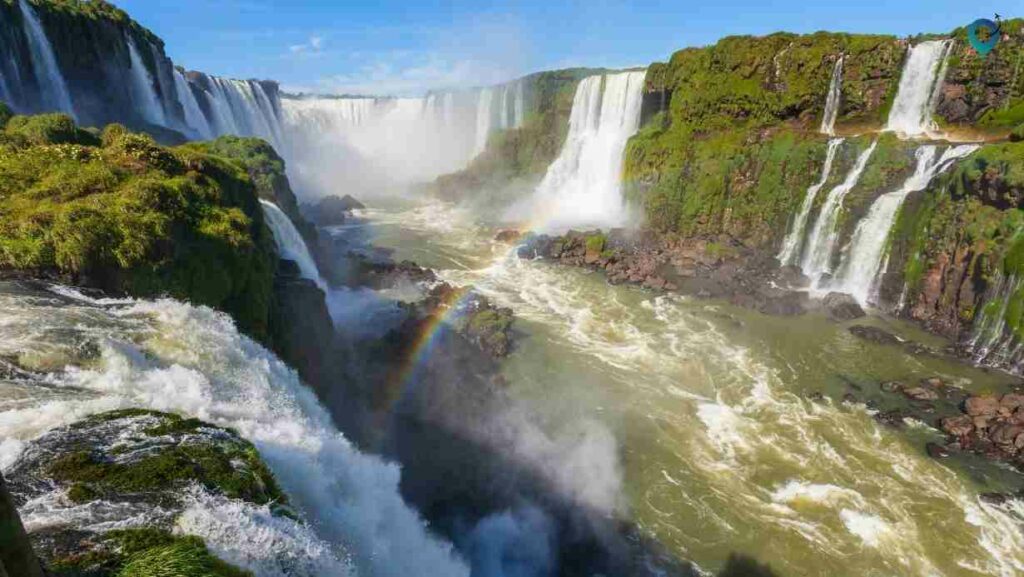
Iguazu National Park, designated as a UNESCO World Heritage Site, encompasses the Argentine side of the Iguazu Falls and offers a plethora of trails, viewpoints, and natural wonders to explore.
UNESCO World Heritage Site : The park is renowned for its unparalleled natural beauty and biodiversity. Visitors can embark on well-maintained trails that lead to various viewpoints offering spectacular panoramas of the falls from different angles, including the iconic Devil’s Throat.
Immersive Experiences : Exploring Iguazu National Park provides opportunities to witness diverse flora and fauna, with chances to spot wildlife such as coatis, toucans, and colorful butterflies. Guided tours and informational signage along the trails enhance the experience by providing insights into the park’s ecosystems and conservation efforts.
Visiting Iguazu National Park allows travelers to immerse themselves in the natural wonders of the falls while appreciating the significance of conservation efforts in preserving this UNESCO-listed treasure.
6. Itaipu Dam: Tour the world’s second-largest hydroelectric plant for a unique engineering perspective.

The Itaipu Dam, situated on the Paraná River, stands as one of the world’s largest hydroelectric power plants and a remarkable engineering feat.
Engineering Marvel: A guided tour of the Itaipu Dam offers visitors a fascinating insight into the intricate engineering and construction of this colossal structure. Visitors can learn about the technological innovations and challenges involved in harnessing hydropower on such a grand scale.
7. Helicopter Tour: Gain a breathtaking aerial view of the falls and surrounding landscape
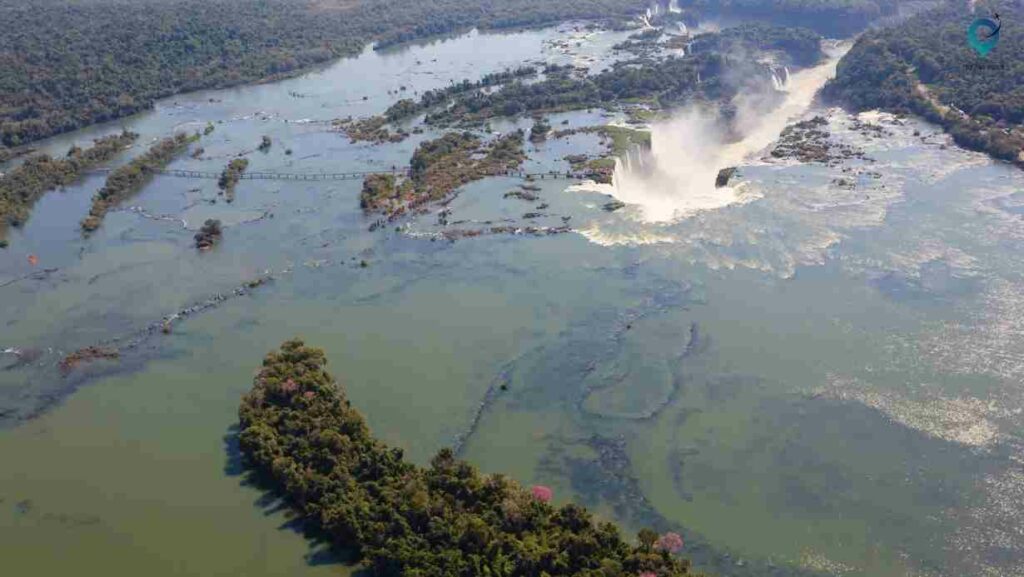
Embarking on a helicopter tour provides a unique and breathtaking perspective of the majestic Iguazu Falls and the expansive landscapes surrounding it.
Aerial Vantage Point : Helicopter tours offer an unparalleled view of the falls from above, allowing visitors to witness the sheer scale and grandeur of this natural wonder. Passengers can marvel at the rushing water, the lush greenery of the rainforest, and the convergence of the Iguazu and Paraná rivers.
Unforgettable Experience : The exhilarating sensation of soaring above the cascading waters and getting a bird’s eye view of the entire expanse creates an unforgettable and awe-inspiring experience. The helicopter ride provides ample photo opportunities for capturing the beauty of the falls and the surrounding landscapes from a unique angle.
8. Macuco Safari: Embark on a jungle adventure including a boat ride near the falls.
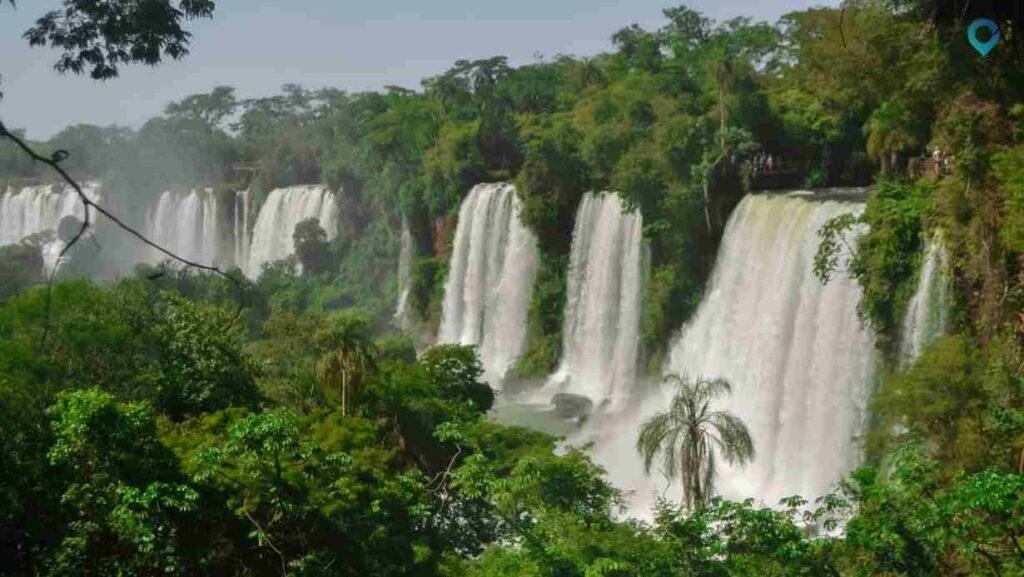
The Macuco Safari offers an exciting and immersive jungle experience combined with a thrilling boat ride that gets visitors up close to the Iguazu Falls.
Jungle Adventure: The adventure begins with a jungle trek through the lush rainforest of the Iguazu National Park. Visitors can immerse themselves in the sights and sounds of the jungle, witnessing various flora and fauna along the way.
Boat Ride Near the Falls: The highlight of the Macuco Safari is the boat ride that takes participants near the falls. Navigating the river, visitors can feel the mist and hear the thundering roar of the falls, creating an exhilarating and memorable experience.
9. Rafting: Experience the adrenaline rush with a rafting expedition along the river.
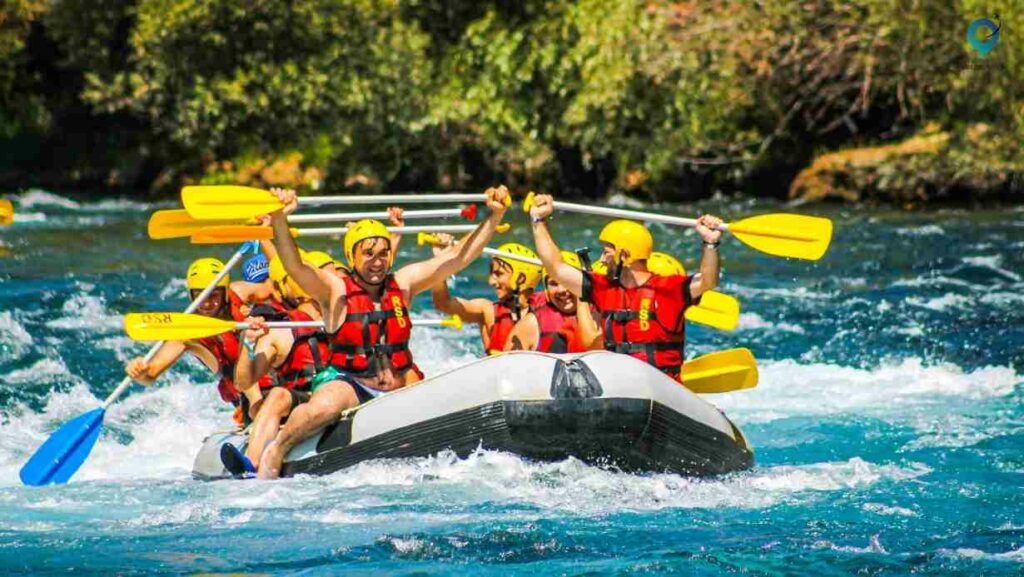
For adrenaline enthusiasts, rafting along the Iguazu River offers an exhilarating and adventurous experience amidst the stunning natural surroundings.
Adventurous Expedition : Rafting expeditions on the Iguazu River provide an adrenaline-packed journey through the river’s rapids and currents, offering an exciting and challenging adventure for participants.
Scenic Thrills : Apart from the adrenaline rush, rafters can enjoy the scenic beauty of the surrounding landscapes, including lush vegetation and the breathtaking vistas of the river and its gorges.
10. Night Jungle Tour: Discover the nocturnal wildlife and sounds of the jungle.
A Night Jungle Tour offers a unique opportunity to explore the rainforest after sunset, immersing oneself in the mystical ambiance of the nocturnal world.
Nocturnal Wildlife Exploration : Led by experienced guides, visitors can embark on guided walks or tours through the jungle trails. This adventure provides glimpses of nocturnal creatures such as owls, night monkeys, and various insects that come to life after dark.
Enchanting Atmosphere : The jungle transforms at night with different sounds, scents, and activities. Participants can experience the magical ambiance of the rainforest illuminated by moonlight and observe how various species adapt and thrive during the nighttime hours.
11. Eat at Local Restaurants: Delight in authentic Brazilian and Argentine cuisine.

Sampling the local cuisine at restaurants in Puerto Iguazu and Foz do Iguacu offers a flavorful journey into the traditional dishes of Brazil and Argentina.
Authentic Gastronomic Delights : Visitors can savor authentic Brazilian specialties like feijoada (a hearty bean stew), picanha (grilled beef), or traditional Brazilian barbecue. Argentine cuisine, renowned for its steaks, empanadas, and dulce de leche, provides a rich and savory dining experience.
Cultural Immersion : Dining at local restaurants not only offers a chance to taste delicious dishes but also provides insight into the cultural influences and culinary traditions of the region through food presentation and flavors.
12. Visit Museums: Learn about the local history and culture at Puerto Iguazu’s museums.
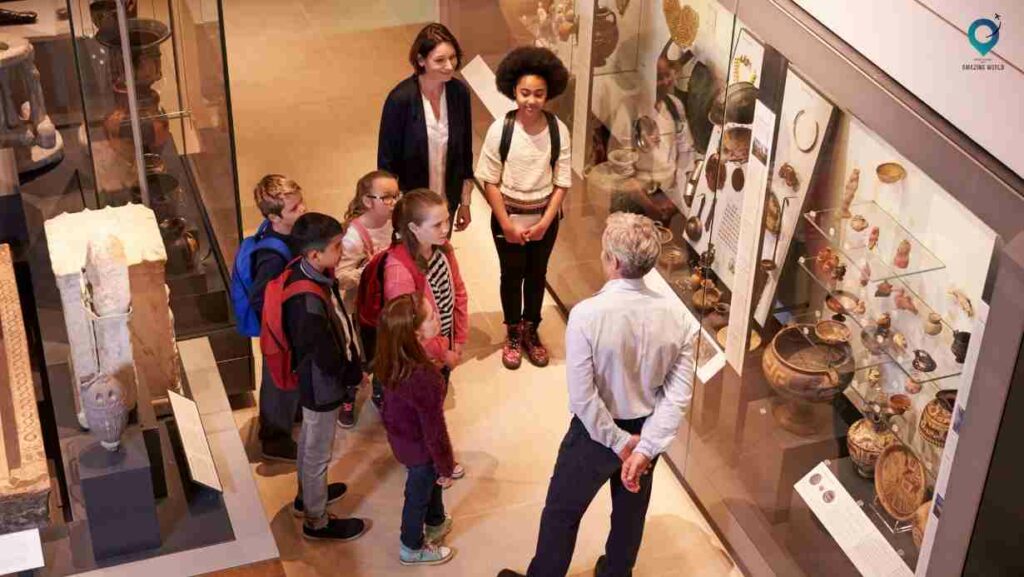
Exploring museums in Puerto Iguazu provides a deeper understanding of the region’s history, culture, and natural heritage.
Historical Insight : Museums like the Guira Oga, which focuses on wildlife conservation, and the Mborore Museum, which showcases the indigenous Guarani culture, offer informative exhibits and artifacts that elucidate the area’s historical and cultural significance.
Educational Experience : Visitors can engage in interactive displays, learn about local traditions, and gain insights into the conservation efforts and the significance of preserving the region’s natural and cultural heritage.
13. Shopping: Explore local markets for souvenirs and handicrafts.

Local markets in Puerto Iguazu and Foz do Iguacu are treasure troves for unique souvenirs, crafts, and indigenous products.
Souvenir Hunting : Visitors can browse through artisanal markets offering a variety of handicrafts, including traditional Guarani artwork, handwoven textiles, jewelry, and other locally made items, providing an opportunity to take home authentic mementos.
Cultural Exchange : Engaging with local artisans and vendors not only allows visitors to acquire souvenirs but also facilitates cultural exchanges, where one can learn about the crafting techniques and cultural significance behind these handmade items.
14. Cultural Shows: Enjoy traditional dance and music performances.
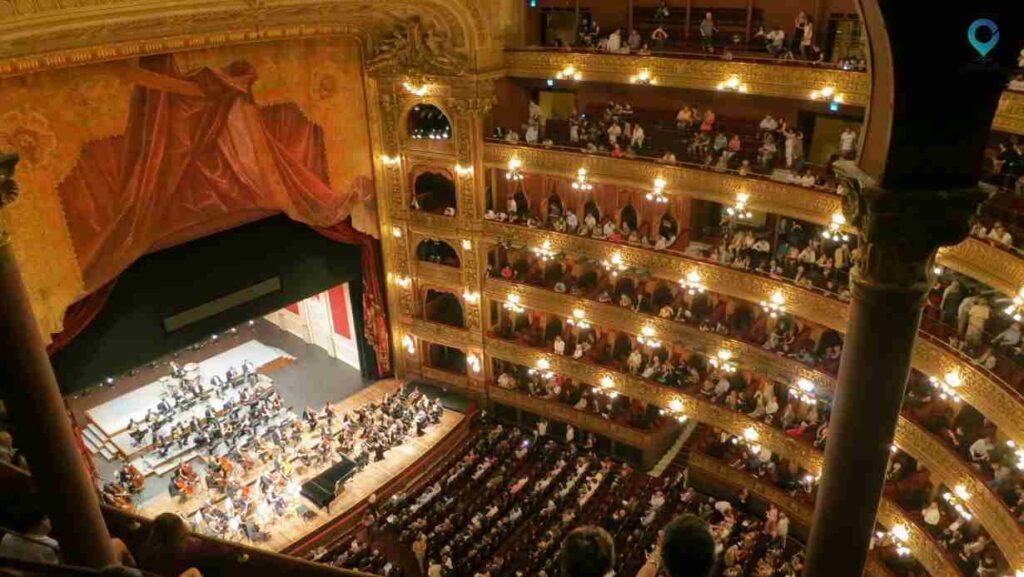
Attending cultural shows featuring traditional dance and music showcases the vibrant heritage and artistic expressions of the region.
Artistic Performances : These shows often feature lively performances with vibrant costumes, rhythmic music, and energetic dances, such as the Argentine tango or Brazilian samba, providing a captivating experience for spectators.
Cultural Immersion : Through these performances, visitors can immerse themselves in the local culture, experiencing the passion and energy that embodies the traditional music and dance forms of Brazil and Argentina.
15. Relax in Thermal Baths: Unwind at nearby thermal springs for a rejuvenating experience.

After the adventures and explorations around Iguazu Falls, visitors can indulge in relaxation and rejuvenation by visiting nearby thermal baths. These thermal springs offer a serene and therapeutic environment, allowing travelers to unwind amidst natural geothermal pools.
Therapeutic Healing : The thermal baths in the region are renowned for their mineral-rich, warm waters. These waters are believed to possess healing properties that can ease muscle tension, improve circulation, and promote overall well-being. The mineral content, such as sulfur, calcium, and magnesium, is thought to have therapeutic effects on the body.
Tranquil Ambiance : Surrounding the thermal springs are serene landscapes, often embraced by lush vegetation and tranquil settings. Visitors can bask in the peaceful ambiance while soaking in the warm waters, providing a sense of relaxation and tranquility.
Rejuvenating Experience: The experience of soaking in the thermal baths after a day of activities offers a delightful escape, allowing visitors to unwind and recharge both physically and mentally. It provides an opportunity to pause, reflect, and rejuvenate amidst nature’s soothing embrace.
Tips for Visitors
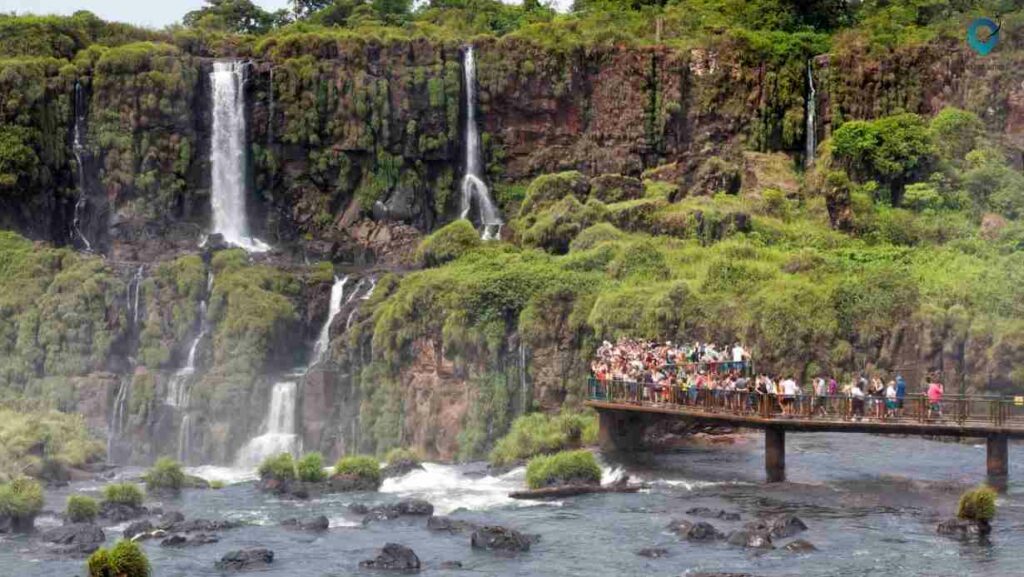
Best Time to Visit: Plan your visit during the dry season (between May to September) to witness the falls at their fullest and enjoy clearer skies for better visibility and outdoor activities.
Comfortable Attire: Wear comfortable clothing and sturdy footwear suitable for walking trails and exploring the falls. Don’t forget waterproof gear, especially during boat tours or closer encounters with the falls.
Sun Protection: Bring sunscreen, hats, and sunglasses to shield yourself from the sun’s rays, especially during outdoor excursions.
Stay Hydrated: Carry water bottles to stay hydrated, especially in the tropical climate surrounding the falls.
Plan Ahead: Consider booking tours or accommodations in advance, especially during peak seasons, to secure preferred activities and accommodations.
Respect Nature: Follow Park regulations, avoid littering, and respect wildlife for a more enjoyable and responsible experience.
Visiting Iguazu Falls and its surrounding areas in Puerto Iguazu and Foz do Iguacu offers an unforgettable adventure filled with natural wonders and thrilling activities. From the jaw-dropping beauty of the falls to the diverse array of adventure opportunities, the region caters to nature enthusiasts, adventure seekers, and those seeking relaxation amidst stunning landscapes.
Exploring the trails, taking in the breathtaking vistas, experiencing adrenaline-pumping adventures, and discovering cultural and historical sites provide a comprehensive experience for visitors. Whether it’s witnessing the falls from various viewpoints, embarking on boat tours, exploring the national parks, or engaging in unique activities like helicopter tours and thermal baths, there’s something for everyone at Iguazu Falls.
Remembering to plan accordingly, respect the environment, and immerse oneself in the wonders of nature contributes to an enriching and fulfilling experience. Visiting Iguazu Falls is not just about witnessing a natural marvel; it’s about creating lifelong memories and connecting with the beauty and power of the natural world.
How much did you like Our detailed THE TOP 15 Things To Do in Iguazu Falls, Argentina ? Review Also, please share these Blogs with your friends on social media.
Recommended
- Eno River State Park
- Tyger River Park
- Lake Welch Beach
- Little Elm Beach
- Cypress Bend Park

Meet David Hoper, a passionate travel Blog writer with 7+ years of experience in travel content. Through his exemplary storytelling and engaging narratives, he shares his experiences and brings destinations to life. With a keen eye for detail and a love for exploration, he has cultivated a diverse portfolio of travel blogs that inspire and inform readers worldwide.
In this article:

Post written by: David Hoper
Leave a reply.
Your email address will not be published. Required fields are marked *
Save my name, email, and website in this browser for the next time I comment.

- November 20, 2023
Travel Guide 22+ Must-Visit Instagram Travel Destinations in 2024 | Amazingworld
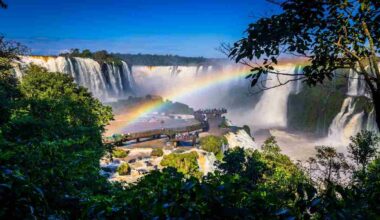
- November 22, 2023
Travel Guide Iguazu Golden Waterfall : The Most Beautiful Waterfall On Earth
You may also like.

Top 17 Must-See Tourist Attractions in Des Moines, IA: Your 2024 Guide
- 31.7K views
- 15 minute read

22+ Must-Visit Instagram Travel Destinations in 2024 | Amazingworld
- 16 minute read

Uber vs Lyft: Pros and Cons of Each Rideshare Service

Ginnie Springs – Things to Do & Attractions A Quick Guide
- 13 minute read

Travelers Guide: 10 Common Taxi Scams and How to Avoid Them
- 19 minute read

A Complete Guide to Colorado Train Rides – Historic Trains
- 9 minute read
Our Latest Instagram Posts
@amazingworld.travel8.
The Ultimate Guide to Iguazu Falls: Argentina and Brazil
I can’t stop talking about Iguazu Falls.
I’ve been blessed to have experienced hundreds of spectacular landscapes over my past 12 years of travel. The downside of this, of course, is that it now takes a hell of a lot to impress me. Subsequently, I wasn’t expecting to be blown away by Iguazu Falls. I must have seen over a hundred different waterfalls at this stage in my life. What could be so special about this one?
I must have been tempting the universe with my dismissiveness, because I came away from Iguazu Falls naming it one of the most amazing things I had ever seen. That was unexpected. My jaw was permanently agape as I walked from viewpoint to viewpoint, marvelling at the sheer size of the falls and the power of nature. It was like nothing I’d ever seen before.
There’s a famous quote about Iguazu Falls, uttered by Eleanor Roosevelt, when she first set sight on their majesty.
“My poor Niagara,” she exclaimed; dismayed by the discovery that Niagara Falls had nothing on Iguazu.
It’s no surprise that she came to this conclusion. Iguazu Falls is twice as tall as Niagara Falls and three times as wide. It’s wider, too, than Africa’s Victoria Falls. Comprising a whopping 275 individual waterfalls and stretching for almost two miles in length, Iguazu is easily one of the most impressive water-based landscapes that you could ever see.
And I’m here today to show you how to make the most of your time at Iguazu Falls.
I learned so much from my time at the waterfalls. I made several mistakes, sure, but I also managed to have one of the most incredible experiences of my life. By taking some very specific steps during my visit, I found myself one of the most impressive viewpoints of the waterfalls with nobody else around . I had them all to myself!
It was amazing — and I want to make sure you can have that experience, too.
This is going to be a long old article — I’ve got facts, I’ve got figures, I’ve got a dramatic story about a violent speedboat ride — as I want to cover absolutely everything you could possibly need to know about visiting the falls. Let’s get started.
Note: Because Argentina’s currency experiences wild fluctuations on a daily basis, I’ve chosen not to give prices in pesos, but to instead share the equivalent amount I paid in USD. That way, the prices within the article will remain accurate.
Where is Iguazu Falls?
Iguazu Falls is located in the northeast of Argentina and the south of Brazil; 80% of the waterfalls are found on the Argentinian side, while Brazil is home to just 20% of them. Most people visit the waterfalls in both countries, as they each offer different perspectives, viewpoints, and experiences.
While the waterfalls don’t quite extend into Paraguay, they’re only a few miles from the tripoint border: the spot where Argentina, Brazil, and Paraguay meet.
How Do You Get to Iguazu Falls?
Luckily, there’s airports on both sides of the border, which makes getting to Iguazu a breeze.
- The Argentinian airport is located in Puerto Iguazu and is called Cataratas del Iguazú International Airport (IGR). The airport is 10 km (6 miles) from the Argentinian entrance to Iguazu Falls.
- The Brazilian airport is located in Foz do Iguaçu and is called Foz do Iguaçu/Cataratas International Airport (IGU). The airport is just 3 km (2 miles) from the Brazilian entrance to Iguazu Falls.
It’s important to note that you can only fly to either airport from the country it’s located in. As in, you couldn’t fly from Buenos Aires to the Brazilian airport; you could only fly to the Argentinian side.
Flights depart regularly throughout the day. In Argentina, there’s around a dozen direct flights from Buenos Aires to Iguazu Falls each day, with the flight taking just under two hours. It’s usually priced at around $70.
In Brazil, it’s much the same. There’s a handful of direct flights each day from Rio de Janeiro and Sao Paulo. Flight time is two hours from Rio and 90 minutes from Sao Paolo. Again, flights are usually around $70.
Of course, you could also opt to go overland to Iguazu Falls if you’re won’t be travelling from Buenos Aires or Rio — buses travel from all over Argentina, Brazil, and Paraguay to the waterfalls.
Just keep in mind those vast South American distances. A bus from Buenos Aires to Iguazu Falls takes 19 hours and can cost as much as $100 — more than taking a flight! Overland travel isn’t necessarily going to be the cheapest option here.
I was already in Buenos Aires, so that made my decision easy. I flew out on a late night flight to Puerto Iguazu and landed at midnight. The following morning, I was up early to head to the park.
How Much Does it Cost to Visit Iguazu?
The two sides of the park are run separately, so if you want to visit both sides of Iguazu Falls, you’ll need to pay two sets of entrance fees.
It costs $24 to enter the Argentinian side, with children under the age of 16 paying $12. Under 6s go free.
It costs $20 to enter the Brazilian side, with children under the age of 6 going free.
You can pay with both cash and card on both sides of the waterfalls.
Amazingly, people with disabilities (and the person accompanying them) get to enter Iguazu Falls free of charge! Almost all of the paths on both sides of the falls are well-paved and accessible by wheelchair, so that’s a double bonus.
Trust me: the experience is 100% worth the entrance fees, so if you’re unsure if the price is too high, it’s not. This is one of the coolest travel experiences I’ve ever had and I can assure you that you won’t regret spending money on it.
Which Side of the Falls Should You Visit First?
I visited the Argentinian side first, simply because I was in Buenos Aires beforehand. If you’re already travelling in South America, or have your itinerary planned out, that will make your decision for you. You’ll choose based on whether you’ll be coming from Argentina or Brazil.
But if you haven’t finalised your plans yet? I don’t think it makes an enormous difference either way, especially as the Devil’s Throat in Argentina is closed for 2024 (more on that below!)
I personally enjoyed visiting the Argentinian side first.
In Argentina, you’ll get to observe the waterfalls from multiple vantage points and gain a better understanding of just how vast the Iguazu complex is. You’ll walk on top of the waterfalls on one trail and then approach them from afar on another; it’s all about the aerial views here. In Brazil, there’s just one short walkway, but it does lead to the best viewpoint in the park.
In Argentina, with the Devil’s Throat closed, the walkways don’t bring you particularly close to the waterfalls and you’re above them for most of the time. In contrast, in Brazil, you get to come within metres of the cascades, standing at their base and getting sprayed by mist from all angles. I felt like I experienced the power of Iguazu in Brazil, whereas I was wowed by dramatic views in Argentina.
I also spent seven hours exploring the Argentinian side and just 90 minutes[!] in Brazil.
That’s why, if I had to choose, I’d say visit Argentina first. The Brazilian experience, of getting up close to the waterfalls and being drenched by them, makes for the perfect dramatic finale. You could be disappointed to experience that first and then head into Argentina and stay perfectly dry.
How Many Days Should You Spend at Iguazu Falls?
Two days is the perfect amount of time to spend at Iguazu Falls.
I saw absolutely everything I wanted to during my two days, so with a third day in town, I’m not quite sure what I would have done. That is, beyond reentering the park and looking at the same waterfalls for a second time.
You’ll want to spend a full day on the Argentinian side. With that amount of time, you can walk the upper trail and lower trail, stroll along the sedate Green Trail, ride the train a couple of times, and take a speedboat up to the falls. At sunset, you could venture out to the tripoint to see where Argentina, Brazil, and Paraguay meet. And if you time your visit with a full moon, you’ll be able to return to the park at night to see the waterfalls lit by its glow.
On your second day, you can cross the border into Brazil and still make it to the park’s entrance by opening time. The Brazilian side is much smaller, so you don’t need more than half a day to see it all, even if you’re opting for the speedboat. If you wanted to take a helicopter over the falls, you could comfortably fit that into the afternoon, while the adjacent Bird Park only requires an additional hour to explore.
And, well, that’s it. During those two days, you’ll have seen all the viewpoints and had all the experiences.
My Detailed Two-Day Iguazu Falls Itinerary
A small amount of research has the power to completely transform your experience at Iguazu Falls.
As I mentioned at the start of this article, I was lucky enough to find myself at a popular viewpoint without a single other person around.
Several hours later, there were dozens upon dozens of people standing in that same spot, struggling to take a crowd-free photo. Had that been my experience, I don’t think I would have found it quite so special.
To ensure you get the same experience as me, I’m going to be sharing every single detail of how you can rock your trip to Iguazu Falls.
Let’s start with how to get from Puerto Iguazu to the Argentinian entrance of Iguazu Falls.
How to Get to Iguazu Falls From Puerto Iguazu
The Argentinian entrance to Iguazu Falls opens at 8 a.m. and ideally, you want to be at the entrance to the park before this time.
Buses run from Puerto Iguazu station to the falls every half an hour, so that means you want to be aiming for the 7:30 a.m. bus at the latest. To give yourself plenty of wiggle-room, aim to be buying your ticket from the Rio Uruguay ticket window by 7:10. The bus station is located in the heart of town, so I’d be surprised if it was more than a 10-minute walk from your accommodation.
Buying a ticket was super-simple — just ask for a return ticket to the waterfalls — as all of the staff speak English and know what you’re there for. I paid roughly $1.80 for the return ticket.
From the ticket office, cross over the bridge to the station platforms and find a bench to sit on while you wait for the bus to arrive.
Given that it’s so easy and inexpensive to take the bus, I don’t see the point in taking a taxi instead.
Especially there are no ride-sharing apps operating in Puerto Iguazu, so you can’t take an Uber or Cabify to the falls.
There are plenty of taxi services at the bus station — you can see some in my photo above — and drivers hanging around on the main street in town, so you still won’t struggle to find somebody. You can expect to pay the equivalent of around $20 for the 30-minute journey.
Should You Buy Your Iguazu Falls Ticket Online?
You can buy tickets to Iguazu Falls at the park entrance on the Argentinian side, so there’s no real need to buy them online — it’s the same price whether you book in advance or turn up on the day. Ticket numbers aren’t limited, so they won’t sell out, either.
If, however, you would prefer peace of mind, or don’t want to waste time queueing at the entrance, buy your tickets from the official website . You’ll have to choose a time slot when you pay, so make sure you select the earliest one.
And just a quick note here, so that you can learn from my mistake.
If you’ve bought your Iguazu Falls ticket online — as I did — make sure to download the ticket on to your phone and take a screenshot so you’ll easily have offline access to it.
I arrived at the entrance to the park and discovered, to my horror , that I didn’t have service on my phone! There also wasn’t free Wi-Fi at the entrance. And so, I couldn’t click the attachment in my email to download my ticket. Weirdly, I had downloaded it the night before, but it hadn’t saved anywhere on my phone.
There really wasn’t anything I could do.
And so, I had to buy a second ticket! Sigh. So make sure you have offline access to your ticket if you do buy yours in advance.
How to See Iguazu Falls (Argentina) Without the Crowds
Now, the Argentinian side of Iguazu Falls has three main components: the upper path, the lower path, and the Devil’s Throat.
The most popular part of the park is the Devil’s Throat, so you’d typically want to head there first.
However , back in late-2023, there was an unseasonable amount of heavy rain, and it resulted in extensive damage to the boardwalk and viewing platform — it’s now completely inaccessible. It’s kind of devastating, because so many visitors name the Devil’s Throat as the highlight of their entire Iguazu experience. Alas! You cannot control nature, and in fact, witnessing nature’s power is exactly why you travelled all the way here — you can’t then complain about it being too powerful!
When will the Devil’s Throat reopen? Current estimates are late-2024 at the earliest. I know — it sucks.
Because of this, I’m not going to write about the Devil’s Throat in this guide. Once it’s reopened, I’ll come back and update the article. Until then, let me share how you can make the most of the unexpected closure. Trust me, you’ll still come away with your mind blown from the waterfalls.
(So yes, it absolutely is still worth visiting Iguazu Falls if the Devil’s Throat is closed!)
The most popular trail in the park in 2024, then, is now the upper path, so you’re going to want to head there first. And the fastest way to do so is by taking the train.
As soon as you enter the park, you’ll see a counter for picking up train tickets. The price of the train is included in your entrance fee, so you won’t have to pay anything extra, but you do need a ticket to board. Simply ask for one at the counter then walk straight ahead to the “Estacion Central” building.
Because you’ve (hopefully!) entered the park as soon as it opened, you’re now going to be able to board the first train of the day. This will ensure that there’s only around 50 people on the popular upper path at the same time as you — as opposed to 5,000 later on in the day. Take a seat in the first carriage of the train, too, to ensure you’re first off when you arrive.
Once you disembark from the train, there’s only one path to follow, so stride purposefully in that direction, leaving the fidgeters behind in your wake.
The first turn-off you’ll encounter is for the upper path, which is labelled “Paseo Superior” — that’s the one you want to take.
Now I’m going to advise something rather controversial here: I recommend skipping the first viewpoint, which is for the waterfall that’s pictured above. In fact, I recommend racing past.
The main reason is that everybody lingers in this spot. It’s their first glimpse of a waterfall, after all, so of course they’re going to stop to admire it. Still, it absolutely pales in comparison to what you’re about to see.
And so, I recommend hurrying past that first viewpoint and walking straight to the next one. If you time it correctly — entering the park at opening time, boarding the first train, skipping the first viewpoint — you should now have the panoramic views of Iguazu Falls all to yourself.
I couldn’t believe I managed to pull it off, and it was one of the most magical moments of my life. To be able to stand and witness the power of nature and have no other humans around for a solid five minutes? I don’t think there’s many visitors to Iguazu Falls who can say they experienced that.
So what can you expect to see on this trail?
The clue is in the name: the upper path is a route that takes you up and over the top of the waterfalls. Along the way, you’ll be traversing a boardwalk that’s located just a foot or two above the surging, chocolate-brown waters. You’ll be surprisingly close to the brink, too, watching as the river passes beneath your feet then crashes 250 feet — or 80 metres — into the pools below.
It happens all of a sudden, too: there you are, walking towards the waterfalls and now here you are, standing on top of Iguazu Falls.
The entire Paseo Superior runs for 1,750 metres, with much of it passing over the top of the falls. Along the way, you’ll be able to see incredible views like these:
It’s not until you’re actually there in person that you can truly comprehend the forces that are at play here. The falls are deafening and the water is violent and the two combined are really quite remarkable.
I’d be gobsmacked if you weren’t gobsmacked.
It was also fun to see just how quickly the water gets churned up. As you walk along the path, you’ll be able to watch the calm waters on the right, drifting on by, with no idea what’s in store for them. And then off they go, smashing down to the ground below.
You’ll know when you’ve reached the end of the waterfall-spectating section because the path reaches a dead end and you have to head back the way you came. After a few hundred metres of this, you’ll reach a turn-off to the left, which then you takes you on a pleasant stroll through the rainforest.
Yes, it’s not quite as breathtaking as the waterfalls, but I still enjoyed this gentle stroll beside the calmer waters.
You can expect to spend around an hour in total walking the upper path and by the time you reach the end, you’ll be wondering how anything can ever top what you’ve just seen.
Before we move on to the second trail of the day, you might feel pulled to indulge in your completionist tendencies. If so, take a quick walk back down the start of the Paseo Superior trail for a second time, just so that you can spend a few minutes admiring the viewpoint you skipped on the first go-around.
Odds are, though, it’s not going to be particularly exciting in comparison to what you’ve just seen.
The lower path is also known as the Paseo Inferior and I found it to be equally as impressive as its upper counterpart. As you can see from the sign, it runs for 2.5 km (1.5 miles) and takes around 90 minutes to complete.
Because most visitors start on the upper path, I have to say that this route was delightfully peaceful, too. There were certainly more people than the zero I encountered on the first trail, but you’re definitely not going to feel as though you’re jostling for space with anyone.
You can see why I stress the importance of entering the park at opening time!
The lower trail starts further away from the falls, so you’ll be catching glimpses of the water in the distance as you walk. Of course, there’s also that enormous plume of mist that lets you know exactly where they are.
The trail starts off rather sedately, weaving through the rainforest and alongside the river, passing over the tops of smaller waterfalls. For the first third of the trail, there’s not all that much to see.
Suddenly, you turn a corner and bam :
There they are again.
The viewing platforms on the lower route are more spacious than those of the upper, so although a handful of people are often gathered here, there’s always plenty of room to spread out.
You’ll notice it offers a different perspective of the waterfalls, too. When you’re walking on the upper trail, you can kind of only really see the top level of Iguazu Falls. From the lower path, you can see both tiers, effectively doubling the size of the viewable waterfalls.
If you’re travelling alone, like I was, use this relatively crowded spot to offer to take a photo of a couple together — then ask if they’d take one of you. It’s the only way I manage to get photos of myself when travelling!
My favourite viewpoint from the lower path is the one pictured above, which comes right at the end of the trail. It’s actually your last real glimpse of Iguazu Falls from the walking paths, so make sure you take plenty of photos here.
Hilariously, while I was there, there was a guy with a step ladder and a high-end camera, offering to take professional photos of tourists at the viewpoint. I just loved that entrepreneurial spirit!
You’ll finish your walk with a passby of the Two Sisters. These waterfalls aren’t technically part of Iguazu Falls, but are impressive nonetheless. And this is also the only waterfall on the Argentinian side that you can observe from its base.
The walking portion of the day’s activities is now mostly over, so if you’re feeling hungry, there’s a food court located close to the end point of the lower path.
Don’t get too excited, though: the food is terrible and overpriced across the board. One of the restaurants — Jaguar House Cafe — is rated 1.7 on Google Maps, while a different restaurant (Fast Comida) is rated 1.8! It’s rare to see ratings quite as low as that.
The bad food was enough to put me off — and I was still full from breakfast — so I grabbed a bag of chips, bought a couple of souvenir magnets, then set off for my next activity.
Before we move on, though, I just want to share a quick warning about the coatis.
These adorable animals are one of the symbols of Iguazu Falls. As in, they’re everywhere . They’re also very cute. You’ll see dozens of them hanging around beside the restaurants and if you have any food, they’ll be trying to get to it. Because of this, some of the food places are actually located inside cages to try to keep the coatis out!
Is the Iguazu Falls Speedboat Worth It?
Now that you’ve ticked off the two waterfall walks, it’s time to head back to the park entrance to buy a ticket for the speedboat.
The biggest mistake that visitors make at Iguazu Falls is not riding the Gran Aventura speedboat.
You absolutely must do this while you’re there. It was the highlight from my entire South America trip. I don’t even know how to put into words just how deliriously happy the experience made me.
There are two ways to get to the speedboat ticket office.
The first is to get back on the train and take it back to the start point. I, however, recommend taking the Green Trail — the Sendero Verde — instead.
It’s just 650 metres in length (2,000 feet), so doesn’t take too long to walk. It’s not a particularly exciting trail, I’ll confess, but it does expose you to a new part of the park. It’s usually pretty quiet, too, so is a good option for escaping those rapidly-increasing crowds.
Keep your eyes peeled for toucans in the trees here, as this is one of the best spots for bird-watching in Iguazu. While I wasn’t lucky enough to spot one, I did see a huge black and white tegu lizard, which is arguably just as exciting.
You’ll emerge from the trail beside the speedboat ticket office; it’s located on your left-hand side. Speak to the staff behind the counter and ask to join in on the next departure. Tours leave every 75 minutes, so you’ll likely be on the 12:45 p.m. tour. It costs $45 per person and I promise it’s worth the money.
So yes, my speedboat experience of Iguazu Falls was some of the most fun I’ve ever had.
It sounds kind of dramatic, but it was truly such a memorable travel experience. It was fun, funny, and exhilarating, and I couldn’t stop laughing afterwards.
Iguazu Falls destroyed my passport. (That was the second mistake I made.)
And I’ll confess that when I signed up for the speedboat, I wasn’t exactly aware of what I was getting myself into. There was a part of me that thought I was signing up for a calming river cruise.
When I was queueing up for the experience, then, and a safety video began playing, listing the 50-odd conditions that disqualified you from riding the speedboat, I started to feel alarmed. If you cannot handle acute levels of stress, you should not board.
Uh, yikes?!
It was with an air of tentativity, then, that I stepped aboard the truck that would take us through the rainforest for the next 20 minutes.
Along the way, our guide shared more about Iguazu Falls, the geography and history of the area, and the animals that call this park home. We paused often, whenever we spotted something in the trees, like an enormous spider or friendly toucan.
When we reached the dock, we collected a dry bag that was roughly the size of my torso and were fitted with a life jacket.
Upon boarding the speedboat, it was time to remove everything we held precious to us. Off came our shoes and socks — that was mandatory — and then any valuables we also wanted to keep dry. Some people had brought a spare set of clothes to change into afterwards; clearly more aware of what was in store than I was. Into the dry bag they all went, and thus began the safety briefing.
With everyone now firmly holding on to the handrail, it was time to begin.
We tore off up the Iguazu River at lightning speed, the wind whipping our hair around our faces.
To the right, we passed thundering waterfalls, while up ahead, the churning rapids threatened to throw us overboard. I gripped the handrail even tighter. Up and over the currents we went, catching air then forcefully slapping back down to the surface of the water.
Within minutes, Iguazu Falls was directly in front of us, the mist already starting to dampen our faces. Our guide had told us the recent rains had resulted in the waterfalls expanding to a flow-rate that was five times heavier than normal. It was hard to process just how much water was falling metres from our vessel.
The speedboat in front of us gave a sneak peek at what was to come.
They sat stationary for a while, as though building up courage to attack. And then they surged forwards: faster, faster, faster. At the base of the falls, their boat served as a valuable tool for gaining perspective of the scene; just how tall the waterfalls were. And then white.
I watched with my mouth wide open as they were completely engulfed by the waterfall.
Before I could react, our driver was shouting for us to put our phones away; to get ready; to hold on.
The spray began to spatter across my face as we neared the cascade. I laughed out loud — not that anybody could hear me — at the sheer impressiveness of the scene. It was everywhere now. The water . Like standing beneath a showerhead that was turned up to 11. I was soaked . Everything was dripping; my bare feet swimming in a pool of water.
I thought I’d experienced it all, but we weren’t stopping yet. No, we were charging ahead still, deeper and deeper into the waterfall until my senses were numb to the world. A roaring white-out of heaviness, pounding, soaking confusion. Delirium .
What was life? What was consciousness? What was up and what was down?
Reality lost all meaning as water overflowed from my screaming mouth and I wondered if this was how I might die; death by World Wonder.
It was 36 degrees (97°F) during my visit, so the cold waters of Iguazu were refreshing rather than shocking, but it still wasn’t over yet.
We circled the island and chose another waterfall to immerse ourselves into. Then another. And another. I looked like I’d emerged from a fully-clothed fall into a swimming pool.
We were all in hysterics at this point, squealing joyfully, screaming, applauding, regressing into inner-children, throwing our arms up towards the water in praise. I can’t remember a more exhilarating experience than this one.
The strength of Iguazu Falls was no longer a mystery. The top of head had experienced it all.
Amazingly, by the time we’d returned back to the dock and taken the truck back to the start point, I was completely dry.
I was completely dry, that is. My passport was not.
Not the best time to learn that my money belt was not, in fact, as waterproof as advertised. So yes, use the dry bag for everything while you’re on the speedboat, even if you think it’s in a waterproof container. This waterfall has a way of getting everywhere.
Still, my two-hour Gran Aventura experience was one of my best ever , so it was a 10/10 from me; well-worth ruining my passport for. All I needed to do now was make my way out of the park and recover from it all in the guesthouse swimming pool.
On my way to the exit — I took the train to get back to the start — I couldn’t believe just how much the crowds had intensified. You’ve seen the photos throughout this article: the vast majority of them don’t have a single person in sight. And yet, by 4 p.m., the walkways were looking like this:
Is It Worth Spending Two Days on the Argentinian Side?
When you leave the park, you’ll have the option to get your ticket stamped, which allows you entry for following day for a 50% discount. Is it worth it?
In my opinion, no. Or, at least, in 2024, when the Devil’s Throat and a few other walkways are closed, it’s not. You have plenty of time in one day to do the three most important things: the upper path, the lower path, and the speedboat ride.
If you have an abundance of time in your travel itinerary and absolutely adore spending time in nature, you might want to head back to see the exact same views again. But really, you’ll have seen the vast majority of the park on your first day.
The only thing I didn’t include on my visit was the Macuco Trail. This hiking path is located just inside the entrance to the park and takes you on a rainforest walk to — you guessed it! — a waterfall.
It’s nice enough, but… it’s a 7 kilometre round-trip trek (4.5 miles), so takes around 90 minutes to complete. And then when you get to the end, you’re greeted with a small, skinny waterfall that’s not even 5% as impressive as the ones you’ve seen throughout the day.
Really, you’ll only want to opt for this if you’re a dedicated hiker, if you want to complete every single activity there is to do in the park, or if you’ve already decided to spend two days there and don’t have anything else to do.
Instead, I’d recommend spending the night in Puerto Iguazu and then heading over the border to Brazil the following morning. And speaking of spending the night in Puerto Iguazu…
Where to Stay in Puerto Iguazu
I’ll confess that my main reason for spending an additional night in Puerto Iguazu — rather than crossing the border into Brazil that evening — was my lovely accommodation.
I chose to stay at Rincón Escondido B&B at a price of $90 a night. Honestly, I booked it for three reasons: 1) it was the best-rated property in Puerto Iguazu, 2) I wanted to use a swimming pool after visiting the falls, and 3) every single review made the breakfast sound like it would be the best .
Thankfully, it lived up to expectations. The owner was so kind, waiting up until midnight to greet me from the airport, happily serving me breakfast at 6:30 so that I could get to falls on time, and giving me tons of advice on how best to avoid the crowds at Iguazu. And yes, the breakfast was ridiculous, with fresh fruit, breads, croissants, muesli, yoghurt, avocado, egg, muffins, banana bread: all for one person!
Cooling off in the swimming pool after a 36°C (97°F) day at the waterfalls was also very much an enjoyable activity.
What About Staying in the Gran Melia?
One little-known fact about Iguazu Falls is that both sides of the waterfalls have a hotel located inside the parks’ perimeter.
On the Argentinian side, it’s the Gran Melia . And if you’re thinking to yourself, that’s gotta be expensive , you would be correct. You’re looking at around $600 a night to stay there; more if you want a room with a view over the falls.
I personally would not recommend doing this. A lot of the reviews mention that the rooms are a bit tired and the food not being great. But not only that: you can’t actually access the waterfalls outside of opening hours! To me, that would be the main benefit of staying somewhere so expensive, but alas!
That’s why I would suggest saving your splurge — if you want to have one — for the Brazilian side of the falls. The hotel there actually does give you access to the waterfalls outside of park hours!
Things to Do in Puerto Iguazu
There isn’t much.
The main activity is visiting the tripoint of Argentina, Brazil, and Paraguay: the borders of all three countries meet in the spot where the Iguazu and Parana rivers converge. If you do want to see it, it’s best to do so in Argentina, because you have to pay to access it from the Brazilian side.
I walked the 40 minute, 3 kilometre distance from my guesthouse to the tripoint for sunset. It was enjoyable enough, and I’m fairly certain it was my first ever triple border, but there really isn’t much to do there. You simply look out at the two rivers and wave at the tourists who are standing at the equivalent landmarks in Brazil and Paraguay.
On my walk back to the guesthouse, I stopped in at Chez Le Choripan for a choripan for dinner — it was one of the best versions of the dish I had in Argentina. Choripan is a beloved Argentinian street food; the clue’s in the name: it’s grilled chorizo sausage on toasted bread! There’s usually tons of flavourful chimichurri added, too.
And with that, I settled in for an early night.
Because tomorrow? We’re going to be heading to Brazil.
How to Get from Puerto Iguazu to Foz do Iguaçu
The Brazilian equivalent of Puerto Iguazu is Foz do Iguaçu, and the two towns separated by just 10 kilometres, or six miles. It takes 20 minutes to drive from one to the other — but of course, you do have a border to cross in the middle.
You’ll want to be up early today, because much like yesterday, we want to be at the entrance to the park by opening time. On the Brazilian side of Iguazu Falls, the park opens at 9 a.m. on weekdays, or 8:30 a.m. at the weekends.
What that means is that we need to eat our extravagant breakfast, pack up our bags, and walk into town to catch a taxi to Foz do Iguaçu. Then, we’ll need to drop our bags at the new hotel — I stayed at JL Hotel by Bourbon — and take a taxi to the park entrance — all before nine o’clock.
In other words, we need to get moving .
Working backwards and presuming you’re visiting on a weekday: ideally, you want to be calling a taxi from your Brazilian hotel to the waterfalls by 8:20 a.m., which means checking in to your Brazilian hotel at 8:10 a.m., which means crossing the border at 7:50 a.m., which means you probably want to be having breakfast in Puerto Iguazu at seven.
There’s two options for crossing the border.
If you’re trying to save money, you can opt for the bus. Much like the previous day, you’ll head to the bus station and buy a ticket to Foz do Iguaçu at the Rio Uruguay counter. You’ll pay a couple of dollars for this option, but are taking a risk with the timings: it takes much longer to cross the border this way and the bus could also be delayed. Plus, when you arrive at Foz do Iguaçu bus station, you’ll still need to navigate to your hotel.
I decided to take a taxi to eliminate all of those concerns.
Amazingly, taxis get to skip the line at the border, as they have a dedicated lane just for them. In my opinion, it’s worth taking a taxi just for that privilege. I subsequently managed to cross the border in under five minutes; it was definitely worth the $20 I paid. All up, it took 30 minutes to get from the main street in Puerto Iguazu (where I found a random taxi driver on the street) to my hotel in Foz do Iguaçu.
Where to Stay in Foz do Iguaçu
I chose to stay at JL Hotel by Bourbon while I was in Foz do Iguaçu and paid $100 a night. This was for much the same reasons as my Puerto Iguazu hotel: It was the best-rated option in my price range, the swimming pool was much-needed on those hot days, and the breakfast was sizeable and delicious.
The hotel was also centrally located with wonderful staff who were happy to keep my luggage for me when I checked in early. The room was clean, modern, and spacious, and felt like good value for money.
But What About Hotel das Cataratas?
I mentioned at the end of my Argentina section that there’s a hotel on the Brazilian side that allows you access to the waterfalls outside of park hours. It’s true! The Hotel das Cataratas gives you access to what is a truly unique experience.
It’s a beautiful five-star hotel and it’s an eye-wateringly expensive hotel at a price of $800 a night. But I do think that if your budget allows, this is going to be a worthy way of spending it. The reviews are pretty much all in agreement that it’s the best hotel they’ve ever stayed in. And it’s the only way that you can see Iguazu Falls outside of park opening hours.
To see them at sunset? Or sunrise? Or to stand in front of the Devil’s Throat and have nobody else around you? It turns out you can put a price on that.
How to Get From Foz do Iguaçu to Iguazu Falls
Good news! Foz do Iguaçu does have Uber, so that makes getting around so much easier. Because I was worried about getting to the waterfalls on time, I opted to do this. It was just $10 for the 20 minute ride to the park entrance.
You could, of course, take the bus to the waterfalls instead. The bus station is called Terminal de Transporte Urbano on Google Maps, and buses leave from there every 30 minutes. You’ll want to take the 120 bus, which costs roughly $1 and takes half an hour to get there.
I’d only take the bus if you’re travelling on a tight budget or spent the night in Foz do Iguaçu (so have plenty of time to spare).
A Guide to the Brazilian Side of Iguazu Falls
The first thing to keep in mind is that the Brazilian side of Iguazu Falls is much smaller than its Argentinian equivalent. I actually hadn’t been aware of this before I arrived, so I was happily racing from viewpoint to viewpoint… and suddenly I was at the end, 90 minutes after arriving.
I was bit like… wait, is that it?
Because of this, I want to stress that the Brazilian experience is one to savour. There’s not very much to cram in to your itinerary today, so if you want to make a full day of it, you’ll have to go slow.
Brazil’s version of the park felt very different to the Argentinian side. In fact, it had a distinct Disneyland vibe to it all.
Upon entering the complex, you’ll join a queue for a double-decker bus that shuttles you to the start of the waterfalls. Again, this is a situation where you ideally want to be at the park entrance before it opens. I, unfortunately, got to the park 10 minutes afterwards and there were already a solid hundred people in the queue in front of me.
It meant that I didn’t get to experience that special solitude from the day before: my third mistake of the trip!
Shuttles run frequently from the entrance — every couple of minutes another bus swings through — so you fortunately never have to wait too long to board.
Once seated, you’ll spend the next 20 minutes making your way to the start of the walkway that runs parallel to Iguazu Falls. And it’s true: on the Brazilian side, there is just one walking trail and it stretches for a distance of 1.5 km, or one mile.
I get that I’m not really selling the Brazilian side to you guys right now — I mean, a one-mile path? Is it really worth the effort?
Despite its diminutive size, though, I do think that the Brazilian side of Iguazu Falls offers a completely different perspective to the Argentinian one.
In Argentina, you’re either walking on top of the falls or walking towards them, and the angle of the walkways means that you can never quite see every single one of the 275 waterfalls.
But on the Brazilian side, you get to see them all. Because you’re looking into Argentina, which is home to 80% of the waterfalls, you can paradoxically see much more than you can while you’re in Argentina.
I also only saw rainbows on the Brazilian side.
The walkway is dotted with viewpoints and photo spots and there were often queues that were 30 people deep. (That’s mostly because I hadn’t arrived at opening time.)
You’ll walk parallel to the Argentinian side — the river acts as the border between the countries — getting a close-up angle of all the waterfalls you wouldn’t have been able to see on the previous day.
The main attraction of the Brazilian side comes at the very end. The Devil’s Throat . Yes, this is the exact same Devil’s Throat that’s currently closed on the Argentinian side!
Well, in Brazil, you can get up close to it from a completely different angle. In fact, you’re able to stroll out on a walkway that takes you right up to the waterfall.
With the exception of the speedboat experiences, this is the only part of the park that will get you wet, so wear a raincoat if you’re worried about that.
This marks the end of your Iguazu Falls experience, so you’re going to want to savour as much of the experience as you can. As you stride out on the walkway, you’ll be engulfed by a cloud of mist from the dense waterfall on your left-hand side. Ahead of you, the Devil’s Throat.
The waterfalls are so heavy in this part of the park that it can make taking photos a little tricky. There’s so much mist in the air that your camera lens will be perma-damp and visibility will be low. Still, you can’t complain when the views are like these:
How to Avoid the Crowds in Brazil
The Devil’s Throat Walkway was the only part of my Iguazu Falls experience that had me surrounded by hundreds of people. But there is a way to avoid them all.
When the double-decker bus stops at the start point of the walking trail, do not get off .
If you stay on the bus instead, it’ll take you to the end of the walking trail next. This is where the accessible entrance to the Devil’s Throat is located. Hop off the bus here, take the elevator down to the ground floor, and then stride out on to the Devil’s Throat walkway.
You should now have the most popular part of the park all to yourself.
When you’ve finished up on the walkway, spend a few minutes hanging out on the huge viewing platform that’s directly beside a surprisingly aggressive waterfall. I really enjoyed this part of the trail, as it helped give a scale to the behemoth that is Iguazu Falls.
After all, this is just one of the waterfalls. The fact that there were 275 more that were just like this was what was really wild to me.
And that’s it. That’s the end of your Iguazu Falls adventure.
Yes, the Brazilian side is much smaller than the Argentinian one, but as you can see from my photos: it’s no less impressive! That’s why I think you’d be missing out if you didn’t go to both sides of the falls.
Should You Take the Speedboat in Brazil, Too?
Brazil does operate a speedboat experience that’s much the same as the one in Argentina. It involves a 20 minute truck-ride through the rainforest and a speedboat that takes you up to the waterfalls.
Personally, I felt so emotionally drained from my speedboat experience on the previous day that I couldn’t quite muster up the energy for a second go-around.
If you’re looking to spend more time in the park, though, or want to experience as much of Iguazu as possible, this is definitely the best way to do so.
If you only want to sign up for one speedboat experience, though, the general consensus is that the Argentinian one is best. It takes you to more falls than the Brazilian one while also propelling you further under the water. The Brazilian one is relatively more relaxed.
Should You Take a Helicopter Ride Over Iguazu Falls?
The Brazilian side of the falls is the only one to offer a helicopter ride over Iguazu. You’ll pay roughly $150 for a 10-minute flight . It’s definitely expensive, but it’s also the only way to see the entirety of Iguazu Falls from above. It’s yet another perspective of this natural world wonder and, well, you might only be here once. Will you regret skipping it in the future?
There is one problem with the helicopters, though. The Argentinian park has actually banned helicopter rides because they disrupt the fragile ecosystem. Specifically, the loud noises often scare the birds and native animals who call this area home.
On the scale of unethical-things-we-do-while-traveling, I don’t think this is the most egregious activity you can do. It may be enough to dissuade you from signing up for it, though.
Is it Worth Visiting the Brazilian Bird Park?
Parque das Aves — the Bird Park — is located directly opposite the entrance to Iguazu Falls, so the vast majority of visitors to the area opt to do both. I was no different: I love birds — especially funny-looking ones — and I had nothing else to do with my day.
I spent 90 minutes making my way around the park. The trail leads you from one enclosure to another, introducing you to different bird species from the world. The big draw here is the local toucans, but my absolute favourite is pictured above: the bright-red ibis. If you’re Australian, yes! That really is a red bin chook.
I had lunch at Parque das Aves and that was a great regret of mine. You should be done with the waterfalls and bird park by around lunchtime, so I recommend heading back to Foz do Iguaçu to eat instead.
And there you have it: that’s how to spend two days at Iguazu Falls.
Could You See Both Sides of Iguazu Falls in One Day?
Yeah, you could actually do so quite easily.
Start off in Argentina, check off the upper and lower trails, then aim to get the 12:45 p.m. speedboat. You’ll be finished with that by 2:45 p.m., which gives you just under two hours to get across the border and to the Brazilian side of the park (it shouldn’t take more than an hour to travel from one to the other). The Brazilian side halts entry at 4:30 p.m. but closes at 6 p.m.; you should be able to see the waterfalls there in an hour — too easy!
Obviously if you skipped the speedboat, you’d definitely be able to see both in a single day.
I do think that you’d have a much more enjoyable, and less stressful, experience if you split it across two days, but if you’re short on time, it’s definitely doable.
Can You Visit Iguazu Falls as a Day Trip?
It’s a lot easier to do so from Argentina.
The earliest flight out of Buenos Aires is at 5:55 a.m., which gets you to Puerto Iguazu at 7:45 a.m. From the airport, you can take a 30 minute taxi to the park entrance and be there by 8:30 or so. There’s plenty of evening flights back to Buenos Aires, too, ranging from a 8 p.m. to 11 p.m. departure time.
From Rio de Janeiro, the flight times aren’t as favourable. In fact, the earliest flight gets you in at midday while the latest flight back leaves at 5 p.m. You technically could fly in and spend three hours at the Brazilian Iguazu Falls — the airport is beside the park entrance — before turning back around again, but it would be a particularly unhinged way of travelling.
Should You Take a Guided Tour of Iguazu Falls?
I don’t think so.
I don’t see why you would need to.
I rolled my eyes, in fact, when I was reading other travel blogs and they stated the parks were overwhelming and confusing, so it’s best to take a tour (which earns them a commission, of course). Like, it’s literally one trail that you follow for a mile; there is nothing overwhelming and confusing about it!
It’s so easy to navigate the two individual parks that it’s impossible to get lost while you’re there. And even crossing the border is a piece of cake, so you don’t need anybody to help you with that.
The only reason, I guess, to take a tour is if you’re looking to learn more about the natural environment from a local expert, or if you’re a solo traveller who’d like a tour guide to help take photos of them.
Over than that, though, I really don’t think it’s necessary.
How to Visit Paraguay Too! …And Should You?
For country counters motivated travellers like me, there’s a certain allure that comes from knowing you’re a twenty minute walk from a brand new country.
It’s true: the bridge in my photo above is located on the western reaches of the Brazilian town of Foz do Iguaçu. Entering Paraguay is as simple as walking out of your hotel, crossing the bridge, and arriving in Ciudad del Este. They don’t even check your passport when you do so!
As tempting as it may be to do exactly that, there’s one big problem.
Ciudad del Este sucks .
I think every single person who has been to Paraguay would agree that it’s the worst place in the country.
Ciudad del Este is home to one of the world’s largest tax-free markets. It’s here where contraband, counterfeit goods, and cartels blend together; where you can encounter the trafficking of drugs, weapons, and even children. It’s a grim, seedy place, with poker machines lining the streets and guards with shotguns manning the storefronts. And yeah, you can buy anything you want there.
I was so keen to take a look around Paraguay but I just could not bring myself to do it in this way. Ciudad del Este sounded awful and the multitude of shopping-themed tours online were the exact opposite of what I wanted to do.
I spent hours researching before determining that Paraguay and me were not meant to be.
But then, I did find one tour.
One that takes you everywhere but the shopping district of Ciudad del Este.
It was a small-group tour called the Paraguay Experience , and it whisks you away to all of the best parts of this region of the country. My tour lasted for nine hours in total and I had such a great time!
The tour guide, Bruna, was lovely and so passionate about Paraguayan culture; she decided to set up this tour because she hated seeing that tourists were all being taken to the worst parts of the country she loves. She wanted to show them that Paraguay is so much more than a tax-free shopping haven.
On our tour, we had her dad driving us around and her son in the back, practicing his English, so it felt like we were part of her family; there were four guests taking the tour in total. And we drove all over the place!
We visited ITAPU Dam, an absolute behemoth — the third-largest dam in the world — that was voted one of the Seven Engineering Wonders of the World. It was actually super-fascinating to get up close to it and see just how enormous it was.
We visited Saltos del Monday , which is pictured above: had I not been to Iguazu Falls for two days running before standing here, I’d have named it the most impressive waterfall I’d ever seen!
A highlight for me was stopping off for lunch in a little local restaurant and getting to try multiple Paraguayan dishes. My favourite was chipa — a type of cheese-filled bread that’s made from cassava flour and anise.
We stopped in at the local museum, where we had a private tour of the exhibits and learned all about Ciudad del Este’s history; our guide even gave us a bag of local mate as a gift!
We finished it all off by visiting the tripoint of Argentina, Brazil, and Paraguay.
Needless to say, I wholeheartedly believe this is the best way to see Paraguay as a day trip. I don’t think it’s worth visiting Paraguay if the only part you’ll see is Ciudad del Este; you’re not going to enjoy it.
And That Was Iguazu Falls!
Well, I didn’t quite expect to write 10,000 words on how to best explore Iguazu Falls. I feel like I’ve essentially just published a guidebook! I guess I had a lot to say.
And so, I’ll keep my ending short: Iguazu Falls is amazing and I hope you have the best time exploring it.
Let me know if you have any questions in the comments! :-)
Lauren Juliff
Lauren Juliff is a published author and travel expert who founded Never Ending Footsteps in 2011. She has spent over 12 years travelling the world, sharing in-depth advice from more than 100 countries across six continents. Lauren's travel advice has been featured in publications like the BBC, Wall Street Journal, USA Today, and Cosmopolitan, and her work is read by 200,000 readers each month. Her travel memoir can be found in bookstores across the planet.
Related Posts
How to Spend Three Magical Days in Cusco, Peru: A 2023 Itinerary
Two Weeks in Peru: An Itinerary for First-Time Visitors
The Cost of Travel in Peru: A 2023 Budget Breakdown
How to Spend Three Fantastic Days in Quito, Ecuador: A 2023 Itinerary
The Cost of Travel in Ecuador: My 2023 Budget Breakdown
How To Spend Two Amazing Weeks in Ecuador: An Itinerary for 2023
Wow, what a detailed, excellent write-up!
Thanks so much for reading, Scott! It’s definitely detailed, hahaha.
Lauren, This is the BEST description I’ve ever read about how to visit Iguazu EVERYONE who visits the falls should read this first, it will save them tons of time and make sure they get the very best experience possible. The only tip I’d add is that if one can afford it staying on the Brazilian side at the Belmond Das Cataratas is a really special experience. We are normally budget travelers and I have not compensation from the hotel in any way, but it was a wonderful stay. It’s expensive, for sure, but it’s the only hotel actually in the park and staying there lets you easily visit the trails and falls early at sunrise and late at sunset, which are very special times to see them and without other people. Plus, the hotel has a lovely pool, excellent restaurant, beautiful grounds, and super nice rooms. For a rare splurge, if you can afford it we recommend it. Finally, you’re absolutely right that the JET BOAT TRIP IS A MUST DO!! Thanks for the great travel report. We’ll follow you from here
Brian! Thank you so much for your kind words! I really do appreciate them. And thank you for the tip for the Belmond Hotel das Cataratas — I definitely think I’d splurge for a stay there if (when!) I return to the falls.
Hi! When did you visit the falls? Did the flooding from 2023 interfere with your experience? We were planning to visit in summer of 2024. Thank you!
Yes, it did, unfortunately! I visited in December 2023, which was around a month after the flooding occurred. No Devil’s Throat for me! But it was still such an amazing experience. It looks like the Devil’s Throat is set to reopen in July, based on this post from the official Iguazu Falls instagram account. Fingers crossed it’ll have opened for your visit!
Hi Lauren!! Thank you so much for writing this, my friend and I are doing a girls’ trip to the falls soon, and this blog is helping us out a lot! Just one question, you mentioned that on the Argentina side, “The first turn-off you’ll encounter is for the upper path, which is labeled “Paseo Superior” — that’s the one you want to take.” I have been looking at the Argentina side maps, and there seem to be two routes for the Superior path. One is closer to the Cataratas station, and the other is by Dos Hermanas Fall (which seems farther from the station but closer to the main falls), which one were you referring to? Thank you again for your help!!
It’s the second one, which is closer to Dos Hermanas Falls. The closest path to the train station is the exit to the paseo superior trail. It’ll be clear when you get there, as the exit trail is marked as no-entry, I think! Have an amazing time at Iguazu!!!
Very well written Lauren. My wife and I did the tour earlier this year. 2 days and yes do the speedboat. It definitely is a must do as is the helicopter ride in Brazil despite the cost of about $150 per person. My wife and I did a 2 day tour from Buenos Aires. The cost of the tour was about $650 for both of us including airfare. It did not include the helicopter ride and taxi to/from our hotel in Buenos Aires. We stayed at the Iguazu Grand Hotel which was included in our tour costs.
Leave a reply Cancel reply
Your email address will not be published. Required fields are marked *

¡Bienvenido a Iguazú todo el año!
Punto turístico por excelencia, visitado por millones de personas que vienen a disfrutar el mayor espectáculo de agua y selva del mundo: las cataratas del iguazú., ¿dónde hospedarse, gastronomía, agencias de viaje, ente municipal de turismo, municipalidad de puerto iguazú, puerto iguazú se encuentra ubicada en el extremo nordeste de la república argentina. junto a los países de brasil y paraguay conforma la triple frontera, donde los ríos dividen tres países rodeados de exuberante naturaleza. portal de la oferta del destino iguazú. puerto iguazú misiones argentina - año 2024.

Diseño Reemix Publicidad
Visiting Iguazu Falls Argentina & Brazil Sides: The Ultimate Guide
Planning on visiting Iguazu Falls and wondering which side of Iguazu Falls is better? Well, in this travel guide to Iguazu Falls, we’ll cover all this and more !
From where to buy tickets to the best time to visit and how to get to Iguazu Falls and around The Park, we’ve written a comprehensive guide to help anyone plan an unforgettable trip to Iguazu Falls!
We spent a long weekend exploring the Argentina and Brazil sides of Iguazu Falls, and while we’ve seen plenty of pictures of the new natural wonder of the world , nothing prepared us for seeing the sheer size of Iguazu Falls in person!
In fact, when Elenor Roosevelt first laid eyes on Iguazu Falls in 1944, all she had to say was, “Poor Niagara!” . And rightfully so!
After all, Iguazu Falls is the largest waterfall system in the world . As you stand and take in the views, you’re almost completely surrounded by the horseshoe-shaped waterfalls. Iguazu Falls is truly something colossal.
Regardless if you are visiting Iguazu Falls for one day, two days, or three days, seeing this thundering natural beauty once in your life is a must!

Visiting Iguazu Falls Planning & Travel Guide
Pin & Save It For Later!
Jump Ahead To:
Visiting Iguazu Falls Quick Tips & Essential Details
- Park Hours: Both sides of Iguazu Falls are open all year. The Argentina side opens daily at 8 AM and closes at 6 PM. Whereas the Brazil side opens at 9 AM and closes at 6 PM.
- Start Early: Outside of beating the heat the afternoon brings, the earlier you start, the fewer crowds there tend to be.
- Visiting: You can visit both sides of Iguazu Falls on your own. A tour is not required to enjoy the sights of Iguazu Falls! However, if a tour sounds appealing, there are many top-rated tours to choose from!
- Lockers: Both parks offer lockers to lock and store any belongings you wish not to carry.
- Tickets: It’s recommended that you purchase your tickets ahead of time on the Park website . Your ticket to the Argentina and Brazil sides includes everything – access to the walking paths/circuits, train, and bus that take you to the falls. It does not include any meals, drinks, souvenirs, boat excursions, or helicopter rides you wish to do. Those will need to be paid separately.
- Wildlife: Don’t pet the Coati’s, or any animals for that matter! As cute as they look, these are wild animals, and they bite!
- Time: You should plan to spend no less than 6 hours on either side of Iguazu Falls. Ideally, a day on each side. If you’re short on time, there are tours that will let you see both sides in one day .
- Environment: It’s hot, humid, and wet, so dress appropriately and weatherproof any lenses/camera gear.
Read our Northern Argentina Itinerary for inspiration on where else to explore!
Where Is Iguazu Falls Located?
First things first, what country is Iguazu Falls located within? Well, it would be countries (plural), not just one.
Iguazu Falls is located in two South American countries – Argentina and Brazil .
Iguazú Falls (Argentina spelling) or Iguaçu Falls (Brazil spelling) is a series of 275 waterfalls that the Iguazu River feeds.
Use the + and – signs to zoom in and out of the above map. The yellow points indicate where Iguazu Falls is located, where the two National Park entrances and closest cities are.
The Iguazú River is the natural border between Brazil and Argentina . And it is here, straddling the border between the Northeastern Argentinan province of Misiones and the Brazilian state of Paraná, where Iguazú Falls can be found.
To get to Iguazú Falls, you need to make your way to the city of Puerto Iguazu (Argentina) or Foz de Iguazu (Brazil) .
These are the two closest cities to Iguazú Falls and where you can reserve your accommodations for your visit.
Iguazu Falls Facts
Before visiting, it’s also important to know that the Argentina and Brazil sides of Iguazú Falls are National Parks. In fact, each park is one of the top national parks visited in each country.
Iguazú National Park in Argentina was established in 1934. Whereas Iguaçu National Park in Brazil was established 5 years later in 1939.
In 1984, both sides were deemed a UNESCO World Heritage Site , and officially, in 2011, Iguazú Falls was named one of the Seven New Natural Wonders of the Modern World .
Before we dive further into this travel guide for your visit to Iguazu Falls, we want to share some pretty cool facts about the falls!
- The 275 falls range in height from 195 to 262 feet (60–82 meters), with the famous “Devil’s Throat” on the Argentina side being the tallest waterfall in Iguazu Falls.
- On average, there are 396,258 gallons of water per second that cascade over the falls
- The falls are the largest waterfall system in the world at 1.7 miles wide and nearly 265 feet high
- Iguazu Falls is taller than Niagara Falls in the United States and wider than Victoria Falls in Africa
- More than 2000 species of plants, 450 species of birds, and 80 species of mammals are found within Iguazu Falls National Parks.
Which Side of Iguazu Falls Is Better – Argentina or Brazil?
Even though Iguazu Falls straddles the border between Brazil and Argentina, it’s not an even split.
80% of the falls are in Argentina, and the remaining 20% are found in Brazil.
So, while Argentina has more of the Falls in its country, the views from both sides are incredibly different. This is why we COMPLETELY recommend visiting both sides if you have the time.
Argentina Side of Iguazu Falls
The Argentina side of Iguazu Falls allows you to get really close to the Falls.
The two circuits (boardwalks), Upper Circuit and Lower Circuit, follow the Falls, allowing you to get above and alongside them and take in some views at a distance.
Also, we felt you saw more wildlife (like Coati’s!) on the Argentina side. The reason is that the circuits take you through the Jungle as you make your way to and from the various viewpoints of Iguazu Falls.
The famous Garganta del Diablo (Devil’s Throat) is on the Argentina side. Garganta del Diablo (Devil’s Throat) is the tallest of The Falls and THE top thing to see when visiting the Argentina side of Iguazu Falls.
PRO TIP: Unfortunately, Garganta del Diablo (Devil’s Throat) was closed during our visit to Iguazu Falls. Due to recent flooding, the portion of the boardwalk that leads to Garganta del Diablo was destroyed. When planning your visit, check the latest construction status to see if Devil’s Throat is accessible. Or, check with a Park Ranger when you visit.
Brazil Side of Iguazu Falls
As for the Brazilian side, you’ll only find one boardwalk . However, this one boardwalk will offer you a completely different experience and viewpoint than you’ll encounter on the Argentina side.
Wading out over a flat, large portion of one Fall, the boardwalk lets you get utterly drenched by the thundering falls that almost surround you. You’re more so in the waterfalls on the Brazilian side, and you’ll also have exceptional views of Iguazu Falls.
Having experienced the Argentina and Brazil sides of Iguazu Falls, we preferred the Brazil side more. Now, this is totally personal preference, but we loved getting out on the boardwalk and being surrounded by the Falls and drenched in its mists.
While we preferred the Brazilian side more, the Argentina side is still absolutely amazing and worth visiting! The views you’ll see on each side widely differ from one another
We HIGHLY encourage you to make time for both sides if you can swing it!
If you can’t allocate one day to each side, there are tours that allow you to see both sides of the falls in one day !
How To Get To Iguazú Falls
There really are only two ways to get to the towns near Iguazú Falls.
If you are coming from another city in Brazil or Argentina, you can fly or take a bus to get you to the cities near Iguazú Falls. As a reminder, they are either Puerto Iguazu, Argentina, or Foz do Iguaçu, Brazil.
Getting To Iguazu Falls From Buenos Aires
Of course, flying will be the quickest way of travel, especially if you’re coming from Buenos Aires .
If you’re coming from Buenos Aires, you’ll have several direct flight options to Iguazu Falls.
Airlines like Aerolineas Argentinas and FlyBondi offer several direct flights from Ezeiza International Airport (EZE) to Cataratas of Iguazu International Airport (IGR) daily.
PRO TIP: If you’re looking for a tour from Buenos Aires to Iguazu Falls, you have options! This one-day , two-day , and three-day tour from Buenos Aires includes your airfare and accommodations!
However, if you want to travel by bus from Buenos Aires to Iguazu Falls, that is certainly an option! Just prepare, as it’s a long ride ! It’s about 807 miles (1,300 km), taking anywhere from 18 – 20 hours .
You can check out the latest bus routes and prices and book your tickets at BusBud .
Getting To Iguazu Falls From Rio De Janiero
If you’re flying from Rio De Janeiro, there are direct flights into Foz do Iguaçu !
Airlines like LATAM and GOL offer direct flights from RIOgaleão – Aeroporto Internacional Tom Jobim (GIG) to Foz do Iguaçu International Airport (IGU).
The same goes for buses. The journey from Rio De Janiero To Foz do Iguaçu is long, 24+ hours!
If you prefer traveling by bus, you can check out the latest routes, times, and prices through BusBud .
Getting To Iguazú Falls From Puerto Iguazu, Argentina
Once you arrive in Puerto Iguazu, the closest town to Iguazú Falls on the Argentina side, you’re a 20 – 30 minute drive from the National Park entrance.
When thinking of your preferred mode of transportation for visiting Iguazu Falls, you have three options :
1. Taxi’s From Puerto Iguazu to Iguazú Falls
The first option, which we chose, was to take a taxi to and from Iguazu Falls!
We stayed just outside the city center of Puerto Iguazu at an amazing hotel called Tre Iguazú . From here, the hotel called a Taxi to take us to and from Iguazú Falls.
In fact, we enjoyed our driver so much that they became our personal driver during our time in Iguazu!
We grabbed the driver’s WhatsApp number and texted them every morning to coordinate our ride to and from Iguazú Falls for the day. In fact, our driver was even permitted to take us across the border to the Brazil side of the Falls, which was a very nice perk!
Coordinating with the Taxi driver was super easy, and we encountered no hiccups!
It was about $60 USD (total for 2 people) for 2.5 days. Plus, that included helping us cross the border into Brazil.
2. Bus From Puerto Iguazu to Iguazú Falls
For those staying in the city center of Puerto Iguazu, you have the option to take a public bus to Iguazú Falls.
They leave every 20 minutes from Terminal de Omnibus, starting at 7 AM , and take an average of 30-35 minutes to get to Iguazú Falls.
The last pickup from Iguazú Falls to take visitors back to Puerto Iguazu is 7 PM , but definitely confirm with the driver or when you buy your ticket! We don’t want you to be stranded at The Falls 🙂
The company that runs these routes is called Rio Uruguay . Tickets cost (at the time of writing this post) 7,000 pesos . No need to buy your tickets ahead of time. You can do so once you arrive at the terminal.
3. Tours From Puerto Iguazu to Iguazú Falls
The last option is to book a guided tour to the Argentina side of Iguazu Falls! We recommend booking your desired tour well in advance to ensure you get the tour on the day you want!
From full-day private tours to group tours and boat rides , you definitely have some options when looking to book a guided experience to Iguazu Falls!
Getting To Iguazu Falls From Foz do Iguaçu, Brazil
Once you arrive in Foz do Iguaçu, the closest town to Iguazú Falls on the Brazil side, you’re a 30-minute drive from the National Park entrance.
You have four options for getting to Iguazú Falls from Foz do Iguaçu.
- Taxi : Flag one down in town or ask your hotel to coordinate a pickup.
- Uber: Yup! Uber. You can call an Uber from Foz do Iguaçu to take you to Iguazú Falls (Brazil side only! Uber’s won’t cross the border)
- Public Bus: Bus 120 departs every 20-30 minutes from the main bus terminal, Terminal Transporte Urbano, in Foz do Iguaçu. The journey to the Park entrance takes about 40 minutes.
- Tour : For those who want to sit back and relax, a tour of the Brazilian side of Iguazu Falls may be perfect for you! Consider tours ( like this one! ) that offer guests a helicopter ride, boat ride, and full access to the trail and bird park to experience everything the Brazil side has to truly offer! Or, opt for a private tour or group tour to see the Brazilian side of Iguazu Falls.
Border Crossing: Argentina To The Brazil Side of Iguazu Falls (and Vice Versa!)
Alrighty! For those staying in Argentina and want to make a day trip to the Brazil side of Iguazu Falls (or vice versa!), breathe easy because it’s totally doable ! In fact, we highly recommend it.
You have three options to choose from to get you across the Argentina and Brazil border:
- Taxi/Private Transfer (what we did!)
Regardless of your transportation choice, Argentina to Brazil is a short drive away. Visitors will go through a customs checkpoint in Argentina before crossing the Tancredo Neves Bridge into Brazil.
Once in Brazil, you’re a quick 20 minutes to Parque Nacional do Iguaçu, the entrance to the Brazil side of Iguazu Falls.
PRO TIP: If you are coming from the Brazil side into Argentina, the process will be the same, it’s just flipped. Once in Argentina, you’re about 25 minutes from Parque Nacional Iguazú, the entrance to the Argentina side of Iguazu Falls.
1. Taxi/Private Driver
To coordinate the trip, you can work with a taxi/private driver (what we did!), and they will take you across the border with no problem. Our driver waited for us in the parking lot of Parque Nacional do Iguaçu while we explored the Brazilian side of Iguazu Falls.
When we were ready to leave, we sent them a WhatsApp message, and they pulled around to pick us up and take us back over the border to Argentina to our accommodation.
The whole crossing was SUPER easy (thanks to our driver). We had our driver for 2 days and, at the end of 2.5 days, paid then $60 USD , which we felt was well worth it!
NOTE: As we understand, if you come from Brazil, you will pay more for a private driver/taxi than we did. When we visited, the Brazilian Real was much stronger (less inflation) than the Argentine Peso.
2. Public Bus
Busses operated by Rio Uruguay run every 25-30 minutes from Terminal Transporte Urbano (TTU) in Foz do Iguaçu. Sames goes for the Argetnina side. Rio Uruguay operates out of Puerto Iguazu’s main bus station (Terminal de Omni), taking locals and tourists across the border into Brazil.
As we understand it, you’ll need to change buses two times along the way.
This bus you board in Brazil or Argentina will not take you directly to The Falls on the other side. Rather, once you’re in Brazil (or Argentina), you’ll hop on the second bus, and that bus will take you to the entrance of Iguazu Falls on the Brazil (or Argentina) side.
All in all, you can estimate this trip to take anywhere from 1.5 – 2 hours , but depending on border crossing traffic, it may take longer.
PRO TIP: Don’t forget to keep your ticket until the end of the trip! You definitely don’t want to lose it, or else you’ll have to pay for another bus fare ticket.
3. Tours To Argentina & Brazil Sides of Iguazu Falls
Outside of a taxi, a tour is, by far, the easiest and most hands-free option to take you across the border.
- If you’re coming from Brazil and want to see the falls in Argentina, this day tour is a great option!
- If you’re coming from Argentina and want to see the Brazil side of the falls, this day tour across the border is a great option!
- Do you want to see BOTH sides of Iguazu Falls? Then you should definitely check out this day tour that will take you to both Brazil and Argentina!
Argentina/Brazil Border Crossing Must-Have’s:
Regardless of how you choose to cross the border between Argentina and Brazil, there are some things you must have when making the journey:
- Your passport
- Applicable Visa(s)
- Ensure your driver has approved credentials to drive back and forth across the border. This is more so for taxis/private drivers. Oh, and never pay your taxi/driver in full ahead of time. You don’t want them to ditch you in another country 🙂
When we visited, a visa for Brazil or Argentina was not required for U.S. citizens . HOWEVER, we are told that is changing for Brazil.
REGARDLESS, please double- and triple-check the visa requirements for your home country before crossing the border.
Also, if a visa is required for your home country, make sure you have completed the required paperwork and have all the necessary items required of you before you get to the border crossing.
PRO TIP: Plan to arrive at the border crossing by/around 8 AM. As the day progresses, more traffic congestion happens at the border.
Best Time To Visit Iguazu Falls
The best time to visit Iguazú Falls is between April and May or September and October . These months are the shoulder seasons, so the heat will be less intense, and rainfall is less likely during your visit.
We totally disregarded these months (whoops!) and visited towards the end of January , which happens to be Argentina’s summer and rainy season 🙂
Sure, we had overcast and a few sprinkles, but the sun did come out, and we had lovely weather, all things considered!
PRO TIP: Regardless of when you visit, you should plan to arrive when the park opens (8 AM Argentina / 9 AM Brazil) to avoid as much of the heat as you can! Oh, and the earlier you arrive, the fewer people there tend to be. A win, win!
How Much Time Do You Need In Iguazu Falls?
We recommend allocating one full day to each side of Iguazu Falls. So, if you’re only planning to visit one side, we recommend 2 nights, 1 day .
Whereas, if you’re visiting Iguazu Falls on both sides, we recommend 3 nights, 2 days .
From Salta , we flew directly into Puerto Iguazu on a Thursday. We spent Friday and Saturday at Iguazu Falls and departed Puerto Iguazu for Buenos Aires on Sunday.
We spent about 6-7 hours on each side of Iguazu Falls. So, you really do need a full day to experience each side properly.
Think of it like this. Iguazu Falls is a perfect trip for a long weekend – Thursday to Sunday or Friday to Monday!
Can You Visit Iguazu Falls In One Day?
Yes , you can visit Iguazu Falls in one day!
Ideally, you arrive the day before your day in the Iguazu Falls National Park – so 2 nights, 1 day.
You can choose to explore each side on your own or opt to take a tour that takes visitors to both the Brazil and Argentina sides of Iguazu Falls in one day!
You must be strategic if you plan to arrive and depart the same day. Book your flight/bus to arrive first thing in the morning and depart late at night.
Tours like this from Buenos Aires are great options for those looking to fly in and out on the same day.
PRO TIP: Taxies can pick you up from the Bus Station or Airport and take you straight to The Falls. There are lockers at the park where you can leave your things if you are traveling with any belongings.
Can You Visit Iguazu Falls Without A Tour?
You sure can ! The only thing required to enter Iguazú Falls is a ticket purchased online before or when you arrive. You are welcome to visit and walk the boardwalks/circuits on either side of Iguazú Falls without a tour or guide .
Now, if you want to do something special, like a boat ride that’ll take you up to The Falls or a helicopter ride over The Falls , then tours are required.
We did the boat tour when we visited the Brazilian side of Iguazu Falls and LOVED it ! It was so much fun, but fair warning, it is a little pricey , and you’ll get absolutely drenched . But in our opinion, it was so worth it!
The boat takes you right up to one of The Falls! And if you’re lucky, you’ll see a herd of Capybara’s on the river bank.
PRO TIP: You can book your boat tour directly with The Park once you arrive. Boat tours are offered on the Brazil and Argentina sides.
Tickets For Visiting Iguazu Falls (Cost & Where To Buy)
You can purchase your tickets for Iguazu Falls one of two ways …
- In person at the National Park ticket counter
- Ahead of time online through the National Park website
We recommend option 2 to ensure you get the desired day and time you want. Buying online allows you to show up to the park and walk right in versus waiting in a potentially long queue to purchase your tickets.
- Tickets for a full day on the Argentina side cost $35.000,00 ARS for adults (6 years and older). Children 5 and under or persons with disabilities are free to enter.
- Tickets for a full day on the Brazil side cost $97.00 BRL . Children up to 6 years of age are free to enter.
PRO TIP: When visiting Iguazu Falls on the Argentina side, at the end of the first day, before you leave the park, revalidate your tickets to obtain a 50% discount for the second consecutive day if you plan to return to the Argentina side.
How To Get Around The Argentina Side of Iguazú Falls
Alrighty! Now that you know how to get to Iguazu Falls, it’s time to understand how to navigate and get around the park.
Once you’ve shown your ticket and are officially inside the National Park, you have a few options for getting to the actual Falls.
When visiting the Argentina side of Iguazu Falls, you can choose to walk the entire way to Iguazu Falls or take a train part of the way.
Walking The Upper And Lower Circuits
If you choose to walk, you’ll take the Green Trail (which starts at the park entrance) to the Upper and Lower Circuits.
- The Upper Circuit is 1.08 miles (1,750 meters) and will take you above the falls. Oh, and this trail is 100% accessible to those who need it.
- The Lower Circuit is 0.9 miles (1,400 meters). This circuit takes you along the falls, offering a panoramic view of Iguazu Falls.
If you walk the entire way (the Green, Upper, and Lower circuits) – what we did! – you’ll walk a little less than 2.4 miles .
Now, there are two other circuits (four in total) within the Argentina side – Garanta Del Diablo and Macuco Trail .
- The Garanta Del Diablo (Devil’s Throat) is a 0.7 mile (1,100 meters) path you’ll walk to reach (you guessed it!) Garanta Del Diablo. This circuit is also 100% accessible.
- The Macuco Trail is a 2.17-mile (3,500-meter) walk through the jungle. This trail actually takes you away from Iguauz Falls and brings you to only one waterfall, Salto Arrechea.
The Upper and Lower Circuits are amazing! Both offer different views of The Falls, so we highly recommend walking the Upper and Lower circuits and Garanta Del Diablo if it’s open.
Riding The Ecological Train
For those who want to do a little less walking , you can ride the Ecological Train.
The Ecological Train is an open-air train that is included in the price of your park entrance ticket. You’ll board the train near the park entrance. Once aboard, you’ll be taken to the Upper Circuit, Lower Circuit, or Garanta Del Diablo entrances.
If you choose to ride the train to the Upper and Lower Circuits, understand the train only removes the Green Trail from your walk. You’ll still have to walk the full 1.08 miles for the Upper Circuit and the 0.9 miles for the Lower Circuit to see Iguazu Falls.
As for riding the train to Garanta Del Diablo, the train does take you most of the way to Garanta Del Diablo. Which significantly cuts down your 0.7-mile walk.
How To Get Around The Brazil Side of Iguazú Falls
Those visiting the Brazil side of Iguazú Falls, you’ll find your experience getting around The Park slightly different from the Argentina side.
All visitors are required to hop on The Park bus . The bus runs every 20-30 minutes and is included in your Park Entrance fee.
The Park Bus will take visitors to three stops.
- The First Stop: The entrance to the Macuco Safari, aka a boat ride to Iguazu Falls. We did this, and it was AMAZING! This is not included in your ticket, so you’ll need to pay extra for this experience.
- The Second Stop : The entrance to the main (and only) 1-mile circuit/trail that’ll take you to Iguazu Falls
- The Third Stop: Where the bus picks you up to take you back to the park entrance once you are done walking the circuit. This stop also has a platform that allows you to get insane views of the falls! Don’t miss it!
Walking the 1 mile (1,500 meters) circuit is THE best way, included in your park ticket, to see Iguazu Falls from the Brazil side.
What To Do at Iguazu Falls
While exploring the beauty and sights of Iguazu Falls is pretty straightforward, there are a few things you definitely don’t want to miss!
After spending a long weekend in the area, we’ve created a list of the best things to do in Iguazu Falls and the surrounding area in two days.
Check out our full post on the best way to spend 2 days in Iguazu Falls !
What to Wear When Visiting Iguazu Falls
When visiting Iguazu Falls, remember to plan and wear clothes for the environment you’ll be in – which is hot and wet.
It’s 100% inevitable that you will get wet when visiting Iguazu Falls. The mist from The Falls is far-reaching. Not to mention the humidity is….well, it’s a lot!
You’ll be walking through a jungle, after all. So, plan to wear and pack things that can get wet and dry quickly.
- Teva Sandals or Chaco Sandals are great footwear to wear at Iguazu Falls. They’re comfortable and can get wet.
- Quick dry tops and shorts (think athletic wear) that you don’t mind sweating in and can get dry quickly are the perfect clothing to wear when visiting Iguazu Falls!
- Bug spray and sunscreen . Apply both generously to keep those bugs away and the UV rays blocked.
- Quick dry towel ! The one thing we didn’t bring and 100% wish we would have. When we visited the Brazil side, we got drenched, and a towel would have been a nice thing to have to help us dry off and sit on our ride back to our accommodation.
- A day pack to keep a reusable water bottle , portable charger , Go-Pro /camera, snacks, medications, and personal items like your wallet and passport/ID. Bonus if your day pack comes with a rain fly ! This will help keep your bag and belongings dry.
While we didn’t use one, we saw many people with binoculars . If you have a pair, it may be a good idea to pack so you can see distant views of the falls and the surrounding jungle!
PRO TIP: At Iguzua Falls, you can purchase a plastic poncho if rain is forecasted or you are worried about staying dry.
Where to Eat When Visiting Iguazu Falls
You’ll find restaurants, cafes, and several grab-and-go establishments on the Argentina and Brazil sides of Iguazu Falls.
- On the Argentina side of Iguazu Falls, you can sit down and eat at restaurants like Fortin Cataratas or Restaurante La Selva .
- On the Brazil side, you can dine at Restaurante Porto Canoas and Y Restaurant .
We purchased a quick snack at one of the cafes and had a late lunch in Puerto Iguazu at Patagonia Brewery once we returned from The Falls.
If you choose to eat inside the Park, especially on the Argentina side, be aware of Coatis! We promise, they’ll be eager to try whatever food you have on your plate.
Where To Stay When Visiting Iguazú Falls
Stay inside iguazú falls park: luxury accommodations.
If you want to stay inside the park, be ready to pay a luxury price! However, with your luxury price comes the perk of being able to access the park outside when the public can – at sunrise and sunset, which we can imagine is utterly magical!
Plus, wildlife is more active in the early hours and late evening, so who knows what sort of furry creatures you’ll see?!
- The Gran Meliá Iguazú : The luxury stay in Puerto Iguauz and on the Argentina side of Iguazu Falls is The Gran Meliá Iguazú. Have clear views of The Falls from your hotel room or their massive on-site pool. Walk past the pool to access the path that will take you directly to Iguazu Fall’s Upper and Lower Circuits. If you feel like splurging, this may be the most perfect place to do so!
- Hotel das Cataratas : The 5-star Hotel das Cataratas in Brazil offers guests traditional Portuguese-styled rooms with stunning views of Iguazu Falls. Spend your morning exploring the Falls and your afternoon relaxing poolside. Like the Gran Melia, Hotel das Cataratas allows you premier access to The Park, and if you can swing it, this very well may be worth the price point!
Where To Stay In Puerto Iguazu, Argentina
When visiting the Argentina and Brazil sides of Iguazu Falls, we used Puerto Iguazu as our home base. For 3 nights, we stayed at Hotel Tré Iguazú , and we loved it!
It sits outside the main city center of Puerto Iguazu, allowing you to stay out in the jungle (very comfortably) and relax. Plus, using their pool after a day of exploring was the cherry on top!
As for other places to stay in Puerto Iguazu, here are some other top-rated accommodations for you to consider!
- Luxury Stays: Places like Iguazu Jungle Lodge , Rincón Escondido B&B , Loi Suites Iguazu Hotel , and Overo Lodge & Selva offer guests an elevated stay complete with a pool, while Secret Garden Iguazu allows guests to relax in extremely peaceful surroundings.
- Mid-Range Stays : Places like Ingá Apart & Suites , Z Hotel Boutique , and Arapy Bed and Dream offer comfortable, clean accommodations (with pools!) for guests to unwind in after a day of exploring Iguazu Falls. The staff is helpful in coordinating transportation or providing recommendations on where to eat!
- Budget-Friendly Stays + Hostels: For those looking to stay in more budget-friendly accommodation, you’ll find a handful of amazing places to call home for a few days! Accommodations such as Scenario Yguazu , Bungalow Hostel , Hostel Iguazu Falls , and Casa 24 Puerto Iguazu offer guests quaint stays and are some of the top-rated budget-friendly accommodations in the area.
Where To Stay In Foz de Iguazu, Brazil
- Luxury Stays: Sanma Hotel , Wish Foz do Iguaçu , and Vivaz Cataratas Hotel Resort are nicer accommodations near Iguazu Falls on the Brazil side. Offering onsite restaurants and pools, these accommodations are highly rated and well worth considering to stay if the price is in your budget!
- Mid-Range Stays : For those looking for something more in the mid-range of accommodation, look no further than Nadai Confort Hotel e Spa , Viale Cataratas Hotel , Hotel Rafain Centro , or Viale Tower Hotel . All have great reviews from fellow travelers complimenting each location on their rooms, staff, and, of course, location!
- Budget-Friendly Stays + Hostels: Iguassu Eco Hostel , Tetris Container Hostel , and Hostel Quintal de Casa are perfect accommodations for those who are looking to be as economical with their stay. Clean, comfortable beds and a vibrant atmosphere await you!
Want More Information on Argentina!?
Iguazu Falls Itinerary: The Best Things To Do At Iguazu Falls
How To Visit Argentina’s Rainbow Mountain
13 Things To Do in Cafayate
How to Spend 2 Weeks in Argentina
15 Things To Know Before Visiting Argentina
How To Spend 3 Days In Mendoza
An Itinerary For Three Days in Buenos Aires
Your Guide to Driving Scenic Quebrada De Las Conchas
16 Things To Do in Humahuaca: The Best Town in Jujuy, Argentina
Pin It For Later!
For more travel tips, guides, and awesome travel shots, be sure to poke around our site and follow us on Instagram @wanderingstus , Pinterest , and Facebook . Oh, if you have any questions, let us know in the comment section. We’re happy to answer. Or, leave us a positive note!
Happy Travels,
– Lauren & Jesse Stuart (The Stu’s)
We're Lauren & Jesse, the creators behind Wandering Stus! We've been traveling for decades, exploring and experiencing the very best this world has to offer. Whether we're roadtripping the U.S. in our camper, hiking through National Parks, or jet-setting to different countries around the globe, we write detailed travel guides to help you plan one amazing (and unforgettable) adventure!
Questions?! Let us know. Leave us a comment! Cancel reply
This site uses Akismet to reduce spam. Learn how your comment data is processed .
- [email protected]
- (+5411) 4556-0617

7 Things to Know Before Traveling to Iguazu Falls
Ramiro rodriguez.
- November 1, 2022

The Iguazu Falls are chosen by thousands of tourists who come to appreciate the majesty of its waterfalls and the natural environment surrounding them with amazing biodiversity. They were declared a World Heritage Site by UNESCO and named one of the world’s seven wonders .
We share with you everything you should know before visiting Iguazu Falls, so you can fully enjoy your days in the destination.
Where Is Iguazu Falls? Is It Easy to Get There?
The Iguazu Falls are l ocated in South America and are shared by the countries of Argentina and Brazil .
Each destination guards them in its two national parks: Iguazu National Park, in the Argentinean province of Misiones, and Iguaçu National Park, in the Brazilian state of Paraná. Learn more about where are the Iguazu Falls located .
Do I Need a Previous Reservation to Visit Iguazu Falls?
We recommend buying in advance to secure your place at the waterfalls. Be aware that some tours and excursions in Iguazu Falls need a previous reservation, so booking in advance will be necessary.
We also recommend that your trip includes a local guide, so you can make the most of your time and completely understand all the surroundings.
Should I Book With Anticipation?
It is recommended to organize the trip in advance. Especially flights and lodging reservations, since it is a very popular destination. Keep in mind that there are quotas of visits per day.
How Many Days Do I Need to Visit Iguazu Falls?
To fully enjoy your visit to the Iguazu Falls on the Argentinian side, it is recommended to dedicate at least two days. On the other hand, visiting the Falls on the Brazilian side is possible in a half day since the tour is shorter than on the Argentinian side.
Check our suggested itineraries to know how much time you should spend at Iguazu Falls .
Remember that you can validate your ticket and get a 50% discount on the entrance fee for the second consecutive day of your visit.
Are the Iguazu Falls Expensive?
The price of general admission is a price according to the magnitude of being able to see one of the world’s natural wonders .
In addition to the general entrance fee, where you can take various circuits through walkways in the middle of the jungle, there are different excursions with different prices.
Among the excursions are:
- Full Moon Walking Tour
- Jungle Fly Adventure (trekking, ziplining, and rappelling in the jungle)
- Gran Aventura (you will board rafting boats surrounding the falls)
- Birdwatching
You can choose from many more tours and activities in Iguazu Falls. We have excursions for any kind of traveler.
Do I Need a VISA to Visit Iguazu Falls?
U.S. and European Union citizens do not need a VISA to visit Iguazu Falls . They only need a valid passport and can stay for 90 days as tourists in the country.
Should I Visit Both Sides of the Falls?
The vast majority of the waterfalls are on the Argentine side, which allows you to see them up close. Still, you can get the full panoramic perspective with a visit to Iguazu Falls on the Brazilian side.
To have a complete experience of the Iguazu Falls, visiting both the Argentine and Brazilian sides is highly recommended .

Table of Contents

- Iguazú Falls Tours
Thrill of Nature´s Power

Iguazú means “big water” in the native language.
- Argentina Tours & Trips (45)
- Chile Travel (17)
- Perú Trips (3)
- Less Than 5 Days (11)
- Week Trip (5-10 Days) (28)
- Two Weeks (11-15 Days) (16)
- 15 Days + (5)
Your result includes travel itineraries in Iguazú Falls Tours

Buenos Aires & Iguazu Falls Trip
Buenos Aires - Iguazu Falls

Glaciers, Falls & Tango
Buenos Aires - Calafate - Iguazú

Buenos Aires Day Trip to Iguazú
Iguazu Falls

Family Experience: Patagonia & The Great Falls
Buenos Aires - Iguazú Falls - El Calafate

Lake District, Wine & Falls
Buenos Aires - Iguazú Falls - Mendoza - Bariloche

Iguazu Falls Full Jungle Experience

Iguazú Falls & Iberá Wetlands Nature Tours
Iberá Wetlands - Iguazú Falls

Iguazú Experience: Lodging in The Rainforest
Iguazú Falls

Buenos Aires, Iguazu & Classic Patagonia Adventure Tour
Buenos Aires - Puerto Madryn - Ushuaia - El Calafate - Iguazú

Best of Argentina Trip
Buenos Aires - Calafate - Mendoza - Iguazú - Ushuaia
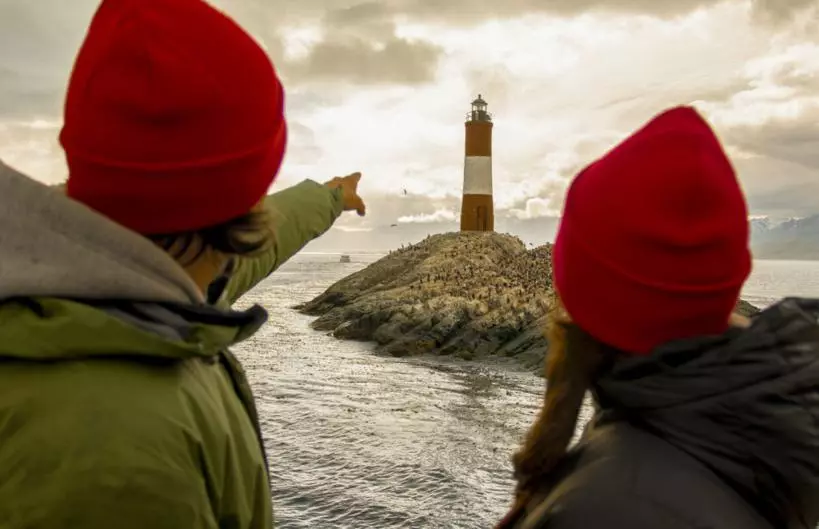
Argentina Travel Highlights
Buenos Aires - Iguazú - Ushuaia - Calafate
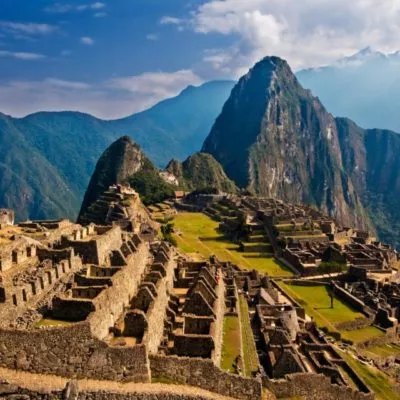
Best of South America Tour
Perú - Buenos Aires - Iguazú Falls - Brazil
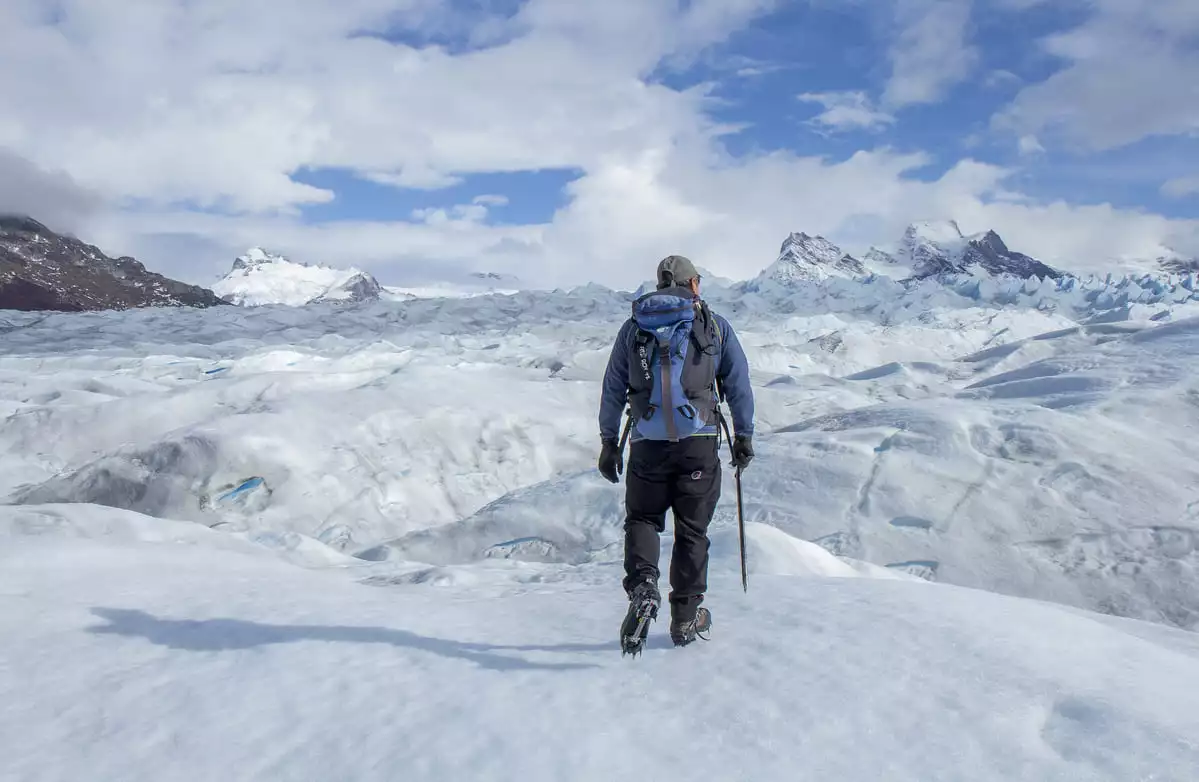
Argentina for Adventurers
El Calafate - Ushuaia - Buenos Aires - Iguazú Falls

Argentina: North to South Adventure
Buenos Aires - El Calafate - Ushuaia - Salta - Iguazú Falls

Highlights of Northern Argentina
Buenos Aires - Salta - Jujuy - Iguazú Falls - Iberá Wetlands
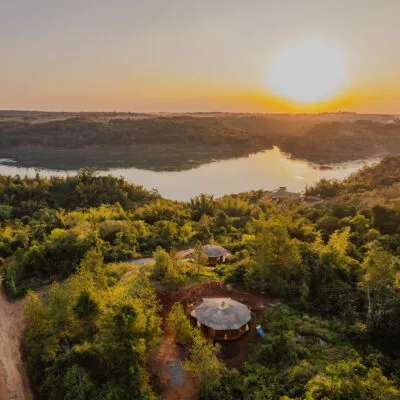
Exclusive Pristine Camps Experience in Iguazú Falls
Yes, it can be done on the Argentinean side and also on the Brazilian side. Both Iguazu Falls Argentina tours and Iguazu Falls Brazil tours offer boat rides that take you close to the base of the falls, providing an exhilarating experience.
The price is USD 26. You can pay at the ticket offices at the park’s entrance in cash (in Argentine pesos) or with a credit or debit card. You can also buy them online as part of an Iguazu Falls trip package.
The Park is open every day of the year from 8:00 am. You can enter until 4:30 pm and stay inside the park until 6:00 pm. Many Iguazu Falls Argentina tours and Iguazu Falls Brazil tours include early access to maximize your visit.
80% of the waterfalls are in Argentine territory, which means that the park is bigger, and there are more waterfalls and more trails. It takes all day to enjoy it. The Brazilian side is the perfect complement since the panoramic view from this side completes the experience perfectly. The Brazilian side is smaller and can be visited in half a day. Combining both sides during your Iguazu Falls trip ensures a comprehensive experience.
That is not necessary, you can buy it before you enter. However, booking your tickets as part of Iguazu Falls Argentina tours or Iguazu Falls Brazil tours can save time and ensure availability.
Yes, you can take Iguazú Falls tours from Buenos Aires . It is best to take the first flight in the morning and the last one in the afternoon and have a guide waiting for you at the airport to go straight to the park. It’s recommended to travel without luggage to go directly to the park and enjoy nature as much as possible.
Customize Your Adventure:
Share your trip plans, and we’ll tailor it to your needs and budget.
What to Do When Visiting Iguazú Falls?
Iguazu means big water in Guarani, which is a fitting name for the deafening roar this beast of a natural waterfall showcases. It is something very akin to ‘magic’—and it should be because the Falls are one of the Seven Natural Wonders of the World and a UNESCO World Heritage site .
You can book Iguazú Falls tours from Buenos Aires . Puerto Iguazú is the closest city to the Iguazú National Park on the Argentinian side and it is shared by three countries: Paraguay, Brazil, and Argentina. Both Brazil and Argentina have National Parks devoted to them, and they are sufficiently different in character to each merit visiting. Iguazu Falls features 275 waterfalls up to 80 meters high, and one of the most spectacular and colossal is the Devil Throat, a massive drop of turbulent water as you’ve never seen before.
For the intrepid explorer, Iguazu Falls offers countless opportunities. Whether it’s trekking through the breathtaking landscapes, bird watching in the rainforest, or exploring the vibrant cultural scene of the border towns, there’s something for every type of traveler. Each Iguazu Falls tour is designed to highlight the region’s natural beauty and cultural richness. Enhance your Argentina travel experience by visiting iconic destinations such as El Calafate and enjoying Bariloche tours . Our tailored tours ensure that every aspect of your journey is unforgettable, from comfortable accommodations to expertly guided excursions.

Multi-Country Trips

Epic Family Trip Adventures in Argentina

Wildlife & Nature Tours

Destinations to Combine With Iguazú Falls Tours
Iguazú is a highly popular destination in Argentina and it is easily combined with other regions like Patagonia. From Iguazú, you can fly to Buenos Aires, Patagonia, Salta, and Jujuy (in the North) and also Río de Janeiro in Brazil.
Iguazú Falls tours from Buenos Aires
Cosmopolitan, dynamic & generous, this city is brimming with places and tourist attractions you wouldn’t want to miss out on. Buenos Aires sits on the coast of Río de la Plata, the widest in the world. If you cross this immense river it will take you 1 hour to reach the other coast in Uruguay! This city is the jumping point for almost any trip to Argentina since the international airport (best known as “Ezeiza”) and a domestic airport (called “Aeroparque”) concentrate the affluent of most of the flights in the country. We recommend staying at least 5 days to wander the streets, and the many cafés and taste the delicious meat for which Argentina is famous worldwide.
El Calafate
This is one of our country’s most impressive landscapes that you will remember the most. The village of El Calafate serves as the gateway to Los Glaciares National Park. Huge blue icebergs floating in milky turquoise waters, cracking noises of massive ice pieces falling into the lake, and the massive Perito Moreno Glacier (UNESCO World Heritage Site) will take your breath away.
This is a small city, really easy to get around on foot, and it has beautiful views of Argentino Lake. The nearest airport counts with a good flight frequency, this is the easiest way to reach El Calafate. The city and its glaciers (around 47 in the park) were discovered at the end of the XIX century. Today, El Calafate offers boat trips in Argentino Lake, day tours to Patagonia ranches to learn about the rural culture, and visits to El Chaltén and Mount Fitz Roy to enjoy amazing views adventure hikes, and other activities.
For an even more adventurous trip, consider adding Ushuaia tours to your itinerary to explore the southernmost city in the world.
Northern Argentina (Salta & Jujuy)
With colonial plazas, red hills, and green oases, the Argentine Northwest is a region of contrasts. The traditions and folklore of this area, which was once part of the Inca Kingdom, are still alive with indigenous culture. The main provinces known as “the North” are Salta and Jujuy. Salta is the capital city in the province of the same name and was founded in 1582. Called “La Linda” by Argentines, which in Spanish means pretty, Salta is a good place to start exploring Northern Argentina. Travelers depart from this city to the breathtaking Calchaquíes Valley and the city of Cafayate, the birthplace of Torrontés wine. Heading north from Salta, you’ll reach Jujuy, known for the Humahuca Gorge (UNESCO World Heritage site) as well as the Great Salt Flats, a white paradise that everyone should visit at least once in their lives!
Rio de Janeiro
Known as the “Marvelous City”, Río de Janeiro was founded by a Portuguese sailor in 1502 and nowadays is one of the most visited cities in Brazil. “Janeiro” means January in Portuguese and the first month of Summer in the South Hemisphere. And something that this city always offers is sunshine days and a continuous feeling of vacations floating in the air. Río has the second-largest economy in the country after São Paulo, and today is still the financial center of Brazil. Countless visitors come to Rio de Janeiro to relax on its beautiful beaches, dance the night away to the beat of Samba (the national dance), and learn about Brazilian culture. Among this city’s highlights, you’ll find Guanabara Bay, Sugarloaf Mountain, Corcovado Mountain, and Copacabana Beach, a perfect visit to combine with tours of Iguazú Falls.
Tips and Culture of Iguazú Falls
If you want to explore deeper into the culture and personality of Iguazú, take note of the following tips.
Meet the Guaraníes
There are still some villages of native Guaraníes living in Misiones. And some of them are open to visitors. In a 2-hour encounter, you can explore the place, talk with locals, and learn about its traditions. They’ll show you the medicinal plants they use, share their ritual chants, and finally, their craft-made art pieces.
Wander the Jesuitic Ruins
A couple of hours from Puerto Iguazú are the Jesuit Ruins of San Ignacio Miní. These are some of the most well-conserved in the area. It is a must-do for those interested in Colonial history and lovers of little adventure on the road!
Not far from the Jesuitic Ruins are Wanda Mines, a real trip to discover precious rocks native to the area like the “amatista” or the “aquamarina.”
Puerto Bemberg
Just a few hours from Puerto Iguazú is Puerto Bemberg, one of the most exciting lodges in Iguazú. Puerto Bember is a natural reserve surrounding a historic house, the “Casa Bemberg.”
This aristocratic house built in the 30s’ was refurbished to host visitors from all over the world.
This family house has a privileged view over the Paraná River and a private port from where you can explore surrounding waterfalls like the Yasí Fall.
Puerto Bemberg is undoubtedly one of the most recommended places to see after the Iguazú National Park.
What is the “Yerba Mate” Road?
The road connects Iguazú in Misiones to Iberá in Corrientes, the neighboring province. People travel north to south of Misiones to learn about “Argentine tea” elaboration.
Local producers and lodges offer their knowledge, and visitors can make different stops to learn about the “mate” history and its variety.
Think about adding a visit to the Iberá Marshlands, one of the more off-the-beaten-path destinations of Argentina. It is a trip for wildlife and nature lovers.
In these hand-picked articles from our Travel blog you will find useful information for your next trip
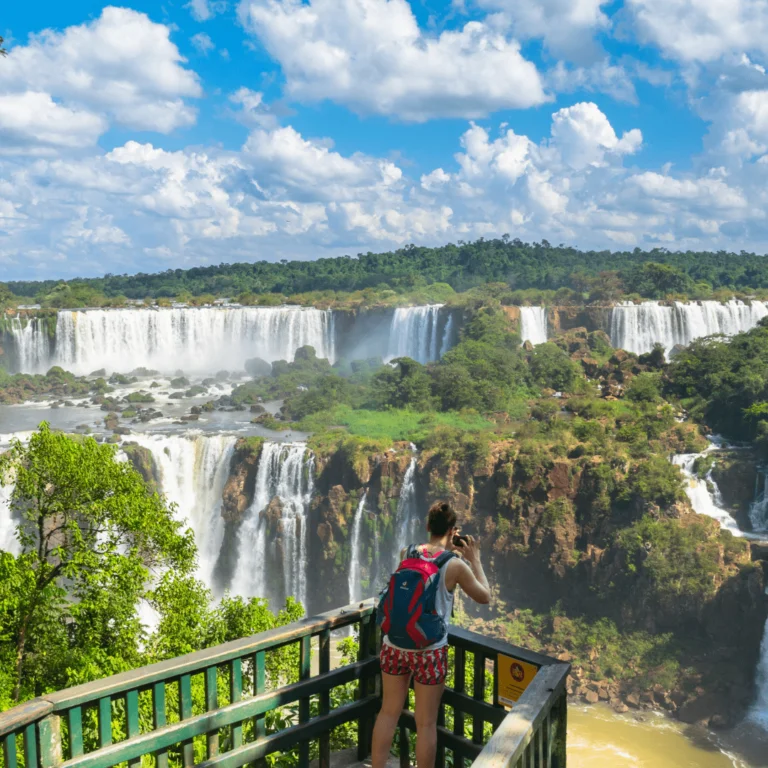
Visit Iguazu Falls: Where to Get the Best Views
Iguazu is one of the largest waterfalls in the world. Not a bad meeting point for the countries. As you […]

The Brazil Side of Iguazu Falls
Iguazu Falls is located at the meeting point of three South American countries: Brazil, Argentina, and Paraguay. The Falls area […]

Can we Swim in Iguazu Falls?
As one of the world’s largest waterfalls, Iguazu Falls is not a place you would want to test out the […]
Related Travel Guides
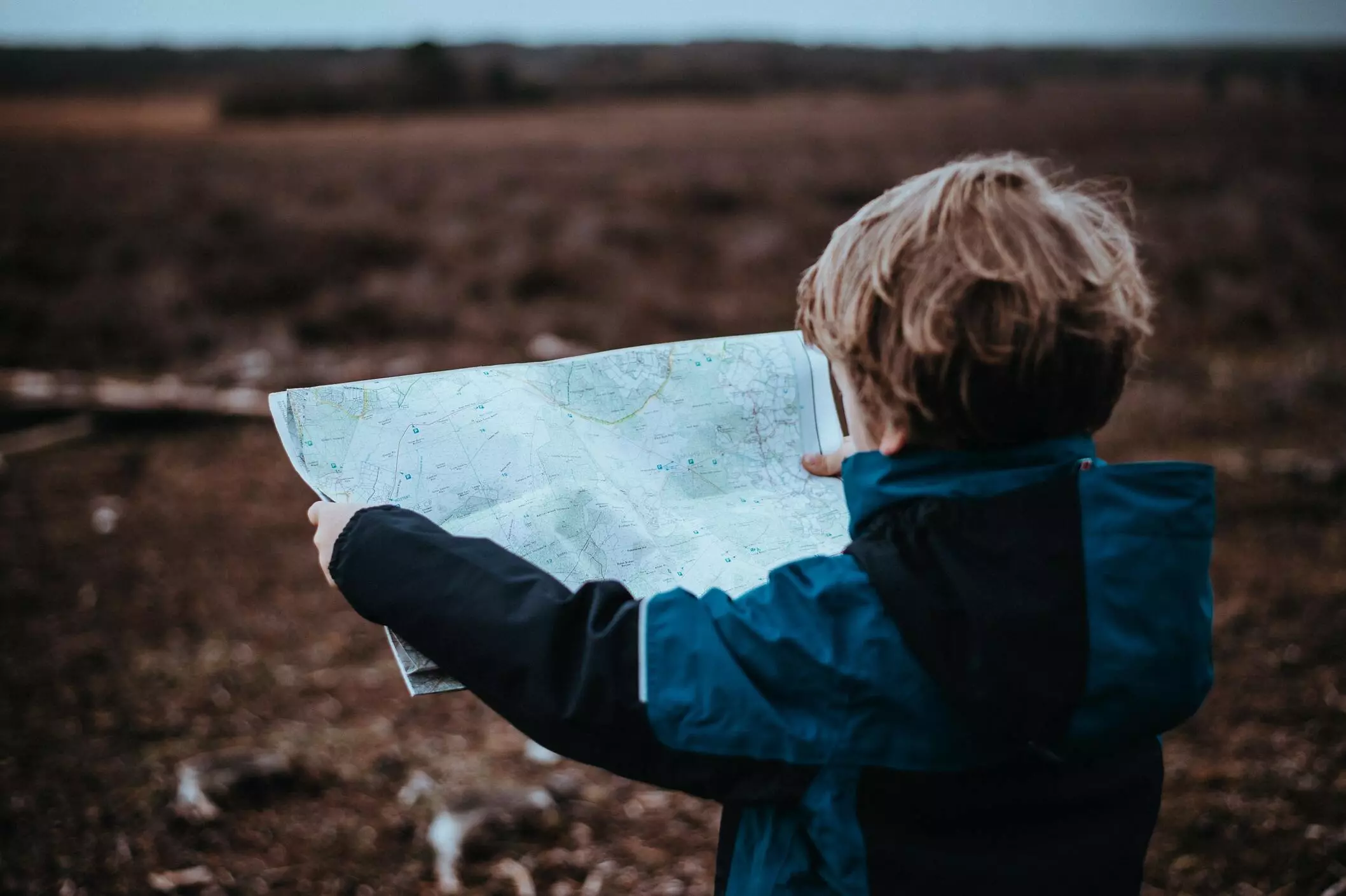
Family Holidays

South America

I specially want to thank Antonella and Lucia for their hard work and dedication towards our very successful holiday. Your dedication and eye to detail was very much appreciated.
Celia our guide for our two days at Iguazu falls was exceptional.
We will definitely recommend Sayhueque to our friends back in Australia.
We had an incredible experience.
The only hiccup we had were the flights being overbooked and having to spend more time than needed at the airport. Overall, we loved all the excursions. We would 100% recommend Say Hueque.
- At Iguazu, we enjoyed having the private guided tour to learn more about the falls and Rodrigo was great. It would have been nice to have an extra hour or so at the end to walk around ourselves and revisit some of the falls- they were so beautiful and could have spent the whole day there watching them!
- For the hike at Torres del Paine, the guides were fantastic. We are just faster hikers and don’t typically hike in a group. I think for that excursion, having the option to take the bus there and do a hike on our own and bus back would have been nice.
- The museum was closed in Ushuaia for the penguin rookery tour. Would recommend scheduling that tour on the days the museum is open if possible. Either way, seeing those penguins so close was so much fun! They’re so cute!
- Wish we could have been there one extra day to watch Argentina win the World Cup while in Argentina! What a fantastic game!!!
Thanks again for all your assistance with this. We had a wonderful time and hopefully one day we can go back (we really want to combine the O and the W for a backpacking trip in Torres del Paine!)
All the guides and hotels were fantastic and we wish we had more time there, we really had the best honeymoon we could have asked for!
Merry Christmas and happy New Year!
Now that we are back I just thought to write to you and thank you for the amazing trip and the organisations you did. First of all Argentina is amazing and I wish, really wish you guys know it despite the financial and political incompetence everyone complained about. About the trip: My background is biology, so you can imagine how excited I was seeing all the biological and geographical diversity in Ushuaia and then in Iguazu... Everything about the tours in Ushuaia and Iguazu was well managed and was great (even one day there was a mix up with the tours in Iguazu but at the end it was sorted and even became super special). We had no issue with the luggages etc.,. Thank you. There was only one small thing that I thought to tell you about: the hotel Mil810. It was a bit annoying, there were several issues with it, one was that the walls that are super thin, so I could hear everything happening in the next door (the snoring, the showering and even when they brushed their teeth, I could not sleep due to the snoring of the man next door :D). The internet was super unstable and even one night we did not have any and also their breakfast was super super basic. Yet these could be temporary issues and also maybe there in Ushuaia internet might be an issue in general but I thought to let you know anyways. But again, all and all it was an amazing trip and everything went smoothly and I hope to be back to Argentina one day again....
We had a very nice time. The flights were fine and on time. The estancia Rincon del Socorro was fantastic!!! Beautiful place, we were one with the beautiful nature, good food and drinks, very friendly stafff, very nice guided tours. We experienced 4 wonderful days!! ...including the fires... We have experienced the fires around the Estancia from close by. The staff has taken good care of us, offered us an alternative dinner and brought us safely back to the estancia. Afterwards Wilfried and I spent another 3 nights, 2 days in Posadas. Despite the fact that it was very hot, we had a great time. We had 2 tours: The city tour was short, but good as a first introduction to the city. About the tour to San Ignacio Mini. and the mate-tour we want to say the following: You had a whole day planned. So we had expected a whole day, with the possibility of lunch in a local village. This was not the case. The visit to San Ignacio mini was very good, but we had expected more from the mate tour. The mate tour was just a short visit to the factory and a video screening, we had hoped to see more of the mate plantations themselves. The tour only lasted a good half day, we were driven back to Posadas and then had lunch there. We are happy to have been introduced to a very beautiful nature reserve Iberà in Corrientes and we are glad that we got a nice impression of Misiones.
I was on the verge of burnout, so I decided to take some time for myself and go on a once-in-a-lifetime journey to reenergize and regain my strength. I picked Argentina because a good Argentinian friend recommended Say Hueque Tours Services, and I will be eternally thankful to her. Every part of the trip was efficiently addressed, from the immaculate planning and attention to detail (printing out the boarding tickets, for example) to the real aid and attention to my demands (custom travel agenda). Folks, this is true Customer Service at its finest. Bravo!
Say Hueque did a wonderful job. They individualized our visit to Buenos Aires and Iguazú Falls. Sandra was an exceptional guide in Buenos Aires. She brought the history of this beautiful city alive for us. We felt very well taken care of!
Let's keep together & connected through our social media channels:
The website uses cookies to enhance your experience. By continuing, you agree to our Cookie Policy
Fill out the form, and our Travel Specialists will craft your quote within 48 Hours
Complete the form and our Travel Specialists will craft your quote within 48 Hours
- Bus Charters for Groups
WHERE SHALL WE PICK YOU UP?
Foz do Iguaçu
Puerto Iguazu
Ciudad del Este
Cross-Border Transfers
Popular transfers which cross borders.
Unsure how to cross the border in Iguazu? With all our transfers which include a border crossing, your driver will guide you through the immigration procedures, taking the stress out of moving between Brazil, Argentina, and Paraguay.
PUERTO IGUAZU TO BRAZIL SIDE OF THE FALLS
Cross the border from Argentina to Brazil. We will pick you up from your accommodation in Puerto Iguazu and drive to the Argentine Immigration where the driver will help you to stamp out of Argentina, and then you drive across the bridge to the Brazilian side where you stamp into Brazil.
From there you will be taken to the entrance of the National Park where you make a time to meet your driver again after your visit to the falls. Later your driver will help you with the border procedures for crossing back into Argentina and drop you off at your hotel.
Argentina ⇒ Brazil
Foz do iguacu to the ciudad del este airport (agt).
Transport across the border from Brazil to Paraguay. You driver will collect you from your accommodation in Foz do Iguacu and take you to the Brazilian immigration so you can exit Brazil with the assistance of your driver. You then travel across the bridge and stop outside the Paraguayan border control so you can check into the country, before continuing to the airport.
After all border procedure are completed, sit back as you are driven the 25 kilometers from the border to the Guarani International airport.
Brazil ⇒ Paraguay
Foz do iguacu airport (igu) to the brazil side of the falls, then onwards to puerto iguazu.
Transfer across the border from Brazil into Argentina. Fly into the Foz do Iguacu airport and be transferred directly to the Brazilian side of the falls. Your driver will look after your luggage while you visit the falls, and when you return you will continue to the border with Argentina.
Your driver will be there to guide you through the processes involved with the Brazilian passport control, and then again after your drive across the Friendship Bridge to the Argentine control. After finalising immigration, you will continue to your accommodation in the city of Puerto Iguazu.
Brazil ⇒ Argentina
Puerto iguazu airport (igr) to foz do iguacu.
Transfer from the Argentina airport across the border to Brazil . If arriving to the airport in Puerto Iguazu, but staying on the Brazil side, then this is the transfer for you. Your driver will be waiting for you as your flight lands, and then you will be transported to the border where you will be assisted with the passport procedures for exiting Argentina.
You will then drive across the bridge to the Brazilian immigration where it is necessary to stamp into Brazil. Once the immigration procedures are completed and everyone is back in the car, you will continue to your accommodation located in the city of Foz do Iguacu.
Argentina ⇒ Brazil
Iguazu transport combos , what are iguazu transport combos.
They are combinations of transport, designed and packaged so you can quickly identify which transfers you require acording to the airport you arrive to and then depart from, plus which side of the falls you wish to visit, then reserve them all at once. See the combinations of transfers available between the airports IGU and IGR to the cities of Foz do Iguaçu and Puerto Iguazu, including visits to the Brazil and Argentine side of the falls – then reserve all your Iguazu transport needs.
Choose your perfect package based on which side of the falls (country) your accommodation will be.
Transport Combos for Foz do Iguaçu Hotels
Foz do Iguaçu Hotels Combo 1
ARRIVING & DEPARTING FOZ DO IGUAÇU (IGU) AIRPORT
Includes airport + brazil side of the falls transfers.
Foz do Iguaçu Hotels Combo 2
Includes Airport + Brazil & Argentine side of the falls Transfers
Foz do Iguaçu Hotels Combo 3
ARRIVING PUERTO IGUAZU (IGR) AIRPORT / DEPARTING FOZ DO IGUAÇU (IGU) AIRPORT
Includes airport + argentina & brazil side of the falls transfers.
Foz do Iguaçu Hotels Combo 4
Foz do Iguaçu Hotels Combo 5
ARRIVING & DEPARTING Puerto Iguazu (IGR) AIRPORT
Transport combos for puerto iguazu hotels.
Puerto Iguazu Hotels Combo 1
ARRIVING & DEPARTING PUERTO IGUAZU (IGR) AIRPORT
Includes airport & argentine side of the falls transfers.
Puerto Iguazu Hotels Combo 2
Puerto Iguazu Hotels Combo 3
Puerto Iguazu Hotels Combo 4
ARRIVING FOZ DO IGUAÇU (IGU) AIRPORT / DEPARTING PUERTO IGUAZU (IGR) AIRPORT
Puerto Iguazu Hotels Combo 5
Shuttles to Iguazu Falls
Shared transport to the falls.
Unsure how to get transport to the entrance of the Iguazu Falls? Have us schedule you a pick up from your accommodation in either Foz do Iguacu or Puerto Iguazu , to take you to the side of the falls of your choice, it’s that easy! Check out your options of daily shared transfers below.
SHUTTLE FROM FOZ DO IGUACU CITY HOTELS TO THE BRAZIL SIDE OF THE FALLS
With 3 daily pickups from your hotel in Foz do Iguacu, and 3 return times, there is no easier way to get to the Brazil falls.
You will be dropped off at the entrance to the falls, and then you are free to explore until your scheduled return time to your hotel in the afternoon.
[Wow-Modal-Windows-Pro id=33]
SHUTTLE FROM FOZ DO IGUACU TO THE ARGENTINE SIDE OF THE FALLS
Secure your seat in the daily van which picks up in Foz do Iguacu and crosses the border into Argentina, before making its way to the entrance to the Iguazu Falls.
Your driver/guide will be on hand to help you at the border and once inside the park, they will explain how to navigate the best trails and show you where you need to go to take the boat ride under the falls.
SHUTTLE FROM PUERTO IGUAZU CITY HOTELS TO THE ARGENTINE SIDE OF THE FALLS
Your guide will be at your accommodation in the morning to greet you and welcome you onto the van before you set off for the national park.
Once inside, you will have information on how to best navigate the most important trails of park, and where to take the train to the ‘Devil’s Throat’. If doing the boat under the falls you will be directed to the starting point.
SHUTTLE FROM PUERTO IGUAZU TO THE BRAZILIAN SIDE OF THE FALLS
Reserve the daily shuttle that picks you up from Puerto Iguazu in Argentina and transports you across the border and into Brazil, before dropping you at the entrance to the national park.
Your guide will help you time your visit on the Brazilian side, and then return to your accommodation in Argentina.
Argentina ⇒ Brazil
Tour groups & bus hire , iguazufalls.travel, we don’t do tours, we do travel, instant booking.
Reserve & pay for your transfers right now. Your service is guaranteed with at least 12 hours advance booking.
Modern Vehicles
Vehicles are no older than 5 years, and are insured against damages to the passenger regardless of whether in Brazil, Argentina or Paraguay.
Reliable & Safe
Experienced drivers with local knowledge of routes, current roadworks and traffic delays ensure our clients arrive safely and on time.
Large Fleet
Whether you are travelling alone or in a large group, we have your ground transport covered! Private cars, vans & buses, plus shared shuttles available.
All your Iguazu transport with just one company
Entrust all your Iguazu transport needs to just one progressive company. Your time is important to us, so take advantage of our experience and make the most of the time that you have at the falls, and around the triple border cities.
Smooth Border Crossings
We are the experts at navigating between the cities of Puerto Iguazu , Foz do Iguaçu , and the hustle & bustle of Ciudad del Este ; so relax as we guide you through the processes involved when moving between the borders of Argentina, Brazil, & Paraguay.
WE ARE WHAT YOU’VE BEEN LOOKING FOR!
With more than 10 years of experience driving satisfied customers, not only will we take you to the greatest waterfalls on this planet, but we will deliver you safely & promptly to the 3 countries, 3 cities & 3 airports of this enchanting region. Whether you are just one person or a group of hundreds, you have just found your Iguazu Transfers!
Years transporting happy visitors around Iguazu
More About Us
Not finding what you need? Create your own itinerary!

IMAGES
VIDEO
COMMENTS
Here's your complete guide to visiting Iguazu Falls! 1. About Iguazu Falls. One of the most important things to know is that Iguazu Falls straddles the border between Argentina and Brazil. Around 80% of the falls are on the Argentinian side, while the remaining 20% is on the Brazilian side.
Best Iguazu Falls Tours. One of the easiest ways to visit Iguazu Falls is with a day tour from Puerto Iguazu or Foz do Iguacu. GetYourGuide has high-rated day tours to see Iguazu Falls on the Argentina side, with optional boat tours where you can see the waterfalls up close and get soaked.This can be a fun way to see the beauty of Iguazu Falls from a different angle.
Visiting the Iguazu Falls. Located on the border of the Argentina and Brazil, Iguazú Falls stretch over 2.7 kilometers (1.7 miles) along the length of the Iguazu River. About 80% of the falls are on the Argentinean side, and only 20% on the Brazilian side. Table of Contents [hide] The Legend of the Falls. The Ultimate Guide for Visiting the ...
Argentina, South America. One of the planet's most awe-inspiring sights, the Iguazú Falls are simply astounding. A visit is a jaw-dropping, visceral experience, and the power and noise of the cascades - a chain of hundreds of waterfalls nearly 1.85 miles (3km) in extension - live forever in the memory. An added benefit is the setting ...
We have travel in November,( of tourist season) the National Park in Iguazu is visited by hundreds , very busy , very long lines to buy the tickets, make sure you have enough water, still hot and long walks to the top of water falls on the walk ways. Make sure you have comfortable walking foot shoes.
From Puerto Iguazu, a public bus runs from the main terminal every 20 minutes and costs $6. From the Brazil side, buses run every 22 minutes from the main terminal of Foz de Iguaçu and cost $1. Travel Tip: Bring a poncho as you're likely to get wet from the spray of the falls. And don't forget to reapply mosquito repellent and sunscreen after ...
per adult (price varies by group size) Journey to Iguazu: 4-Day Adventure from Buenos Aires with Airfare. 2. Bus Tours. from. $1,470.00. per adult (price varies by group size) 10-Day Best of Buenos Aires and Iguazu Falls Tour. 1.
15 Things to do in Iguazu Falls, Puerto Iguazu, and Foz do Iguacu. 1. Jet Boat Safari: Experience an exhilarating ride under the falls. The Jet Boat Safari at Iguazu Falls is an adrenaline-pumping adventure that allows visitors to get up close and personal with the immense power and misty embrace of the falls.
A Practical Guide to Iguazu Falls, Argentina Side. August 13, 2024. Eleanor Roosevelt uttered "Poor Niagara" upon seeing Iguazu Falls Argentina. I've been to both and I have to agree with Mrs. Roosevelt on this one. Iguazu blows Niagara out of the water (ba dum tsssss). The falls in Iguazu are breathtaking and deserving of every ...
Iguazu Falls Argentina - Parque Nacional Iguazu . Iguazu Falls Argentina. At a glance (visiting from Brazil) Time to explore: 1 day; Closest city: Puerto Iguazú ... Hi Ray, I would suggest getting advice from a travel agent to be on the safe side. Generally, yes, it can be done via public busses though it is a long process as you have to ...
Flight time is two hours from Rio and 90 minutes from Sao Paolo. Again, flights are usually around $70. Of course, you could also opt to go overland to Iguazu Falls if you're won't be travelling from Buenos Aires or Rio — buses travel from all over Argentina, Brazil, and Paraguay to the waterfalls.
Hoteles Tours Resto Agencias Instagram Facebook-f Twitter Novedades Novedades ¡Bienvenido a Iguazú todo el año! Punto turístico por excelencia, visitado por millones de personas que vienen a disfrutar el mayor espectáculo de agua y selva del mundo: Las Cataratas del Iguazú. Atractivos Todas las excu
The Iguazu Falls consists of two national parks, one in Foz de Iguazu (Brazil) and the other one in Puerto Iguazu (Argentina). The curious thing is that although one only sees the falls as the main attraction, the park has a size of 252,982 hectares (67,720 on the Argentine side and 185,262 on the Brazilian side).
Before we dive further into this travel guide for your visit to Iguazu Falls, we want to share some pretty cool facts about the falls! The 275 falls range in height from 195 to 262 feet (60-82 meters), with the famous "Devil's Throat" on the Argentina side being the tallest waterfall in Iguazu Falls.; On average, there are 396,258 gallons of water per second that cascade over the falls
Iguazu Falls. The Iguazu National Park is shared with Argentina and Brazil, one in Puerto Iguazu city and the other in Foz do Iguacu respectively. This National Park is a UNESCO World Heritage Site declared in 1984. Thousands of visitors travel to South America especially to witness this unique and natural attraction.
We recommend buying in advance to secure your place at the waterfalls. Be aware that some tours and excursions in Iguazu Falls need a previous reservation, so booking in advance will be necessary. We also recommend that your trip includes a local guide, so you can make the most of your time and completely understand all the surroundings.
Well, in my mind 3 days is the perfect amount of time to visit Iguazu Falls. It gives you a day to see each side of the falls (Brazil and Argentina) without getting too bored in the otherwise somewhat lackluster Puerto Iguazú. In this guide, I'll handle all the planning for you, breaking down exactly what you should do day-by-day in Iguazu.
Puerto Iguazú is the closest city to the Iguazú National Park in the Argentinian side, and travelers visit the city all year round since it's on this side that the 80% of the falls are located. First inhabited by the Guaraníes and then colonized by the Spanish Jesuits, Iguazú still displays many of the traditions of both Argentine and ...
Iguazu means big water in Guarani, which is a fitting name for the deafening roar this beast of a natural waterfall showcases. It is something very akin to 'magic'—and it should be because the Falls are one of the Seven Natural Wonders of the World and a UNESCO World Heritage site.. You can book Iguazú Falls tours from Buenos Aires.Puerto Iguazú is the closest city to the Iguazú ...
Yguazu Travel Service, Asunción, Paraguay. 5,180 likes · 2 talking about this · 61 were here. Agencia de turismo dedicada a ofrecer viajes al interior como al exterior del país,de ocio como de
08:55 - Arrive at Devil's Throat Look-out. 09:40 - Depart Devil's throat for the walk back to train station. 10:00 - Take the train to Cataratas Station (Estacion Cataratas) 10:15 - Start Upper-Level Trail (Circuito Superior) 11:00 - Start Lower-Level Trail (Circuito Inferior) 12:00 - Take Lunch Break for 40 minutes.
Access to the Falls is usually done through one of the three cities in the so-called tri-border between Brazil, Argentina, and Paraguay. The city on the Brazilian side is Foz do Iguaçu - big and reasonably safe by Brazilian standards. The town on the Argentine side is called Puerto Iguazu and is small and pretty. Although the falls are between Brazil and Argentina only, Ciudad del Este, the ...
FOZ DO IGUACU AIRPORT (IGU) TO THE BRAZIL SIDE OF THE FALLS, THEN ONWARDS TO PUERTO IGUAZU. Transfer across the border from Brazil into Argentina. Fly into the Foz do Iguacu airport and be transferred directly to the Brazilian side of the falls. Your driver will look after your luggage while you visit the falls, and when you return you will ...